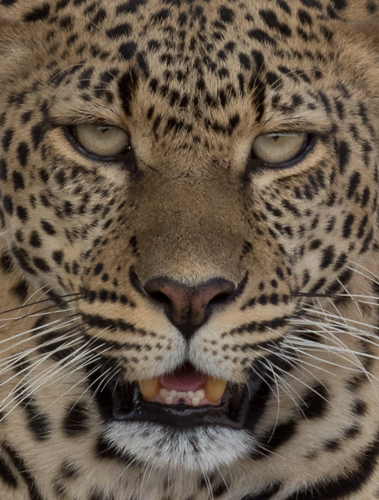
click the leopard for the eagle
Kenya November 2018
After our five days of treking in Rwanda for Mountain Gorillas, we continued with a two week safari in Kenya. The drought of two years ago is over, and vegetation had returned to Samburu. Gnus, which did not return to the Mara in any numbers during the summer, had returned to the areas we were visiting, but there were no river crossings for us.
We had a surprisingly productive trip, with success with all our target species -- a couple very good Leopards, beautiful male Lions, the smallest cubs we've ever seen, Elephants in Samburu, and so much more, including some excellent bird shooting opportunities. The Masai Mara's management, in many sectors, has been disasterous and apparently corrupt, but this year we did not see any cattle inside either the Mara Reserve or in Samburu, and that's real progress from a few years ago.
I was trying a new camera system in addition to the Canon cameras Mary and I usually use, and I captured bird shots like never before, shots that I'd have missed, and that my fellow photographers did miss. I'm still exploring the possibilities here, and I'll say more on this in a future posting.
For now, here's the trip report:
Day 1. Kilgali, Rwanda to Nairobi, Kenya
We arrived from Kilgali, and our five Mountain Gorilla treks, in mid-afternoon. We had our Orientation meeting at dinner, while waiting to be served, which worked great and gave us more free-time (or less of a sense of being rushed) the following morning as we headed to Samburu.
Day 2. Nairobi to Samburu
We left our hotel at 8:10, stopping in route at a curio shop for a bathroom and snack break before continuing to Tree Trout where we had lunch. We were prepared for the Black-and-White Colobus Monkeys and we were extremely lucky. One female had a 20 day old baby, still white – as they are when born, that posed wonderfully on a limb and later on the ground. After 30 minutes or so of shooting the troop wandered off, and we headed to lunch, just minutes before a pouring rain. Great timing!
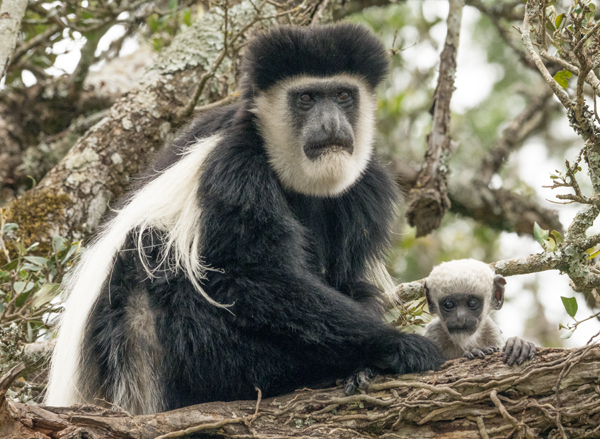
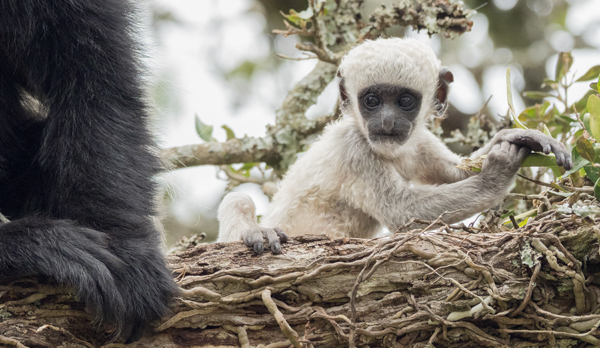
After lunch we headed on to Samburu, going through the Kenya Highlands in the rain, before dropping to the lower elevation that would lead to Samburu. Ahead of us, to the East and North, the landscape was obscured by a dark veil of rain, and after passing through Isiolo towards Archer’s Gate and the entrance to Samburu we drove by flooded fields from the heavy rain. Surprisingly, Samburu was dry, and only as we neared our lodge did we find any evidence of rain – from the day before.
The Isiolo River is flowing, although the water is safely below the normal river bank. Although we didn’t shoot – intending to arrive in time for everyone to unpack in the light, we did see Oryx, Gerenuk, Dik-dik, Grant’s Gazelles, Desert Warthogs, and Vulturine Guineafowl on the drive in. As we neared camp a herd of Elephants, their legs still dark from their river crossing, passed within feet of our vehicle, in single file and unconcerned by our proximity. It was a wonderful introduction to Kenya’s wildlife for several of our participants who had never been to Africa before. We reached camp at around 4:45, had an orientation about camp safety, and settled into camp.
Day 3. Samburu
Our first game drive and the pre-drive arrangement of beanbags on the roofs of the vehicles went well, and by 6:15 we were on the road. We did not travel far today, as almost immediately we found the first of several herds of Elephants that were headed to the river. At one point, strangely, one herd broke into a run, but after investigating we assume that Rangers, on foot, spooked the herd.
Eventually dozens of Elephants made it to the river where all of our vehicles photographed them drinking from several angles. Three bulls continually followed and harassed a female that undoubtedly was coming in to her first heat – she was tiny – and throughout the morning we saw some level of pursuit.
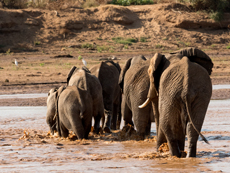
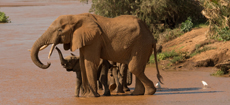
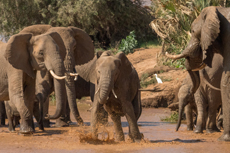
Between Elephant shoots, photographers shot Long-crested Eagles, Baboons, Oryx, Warthogs, Giraffes, and Grants Gazelles, and several species of birds. Towards the end of the morning we found a lone Cheetah, which might be one of a group of three surviving nearly full-grown cubs, or may have been the mother. While the cat looked hungry, she eventually settled down to sleep and we went on.
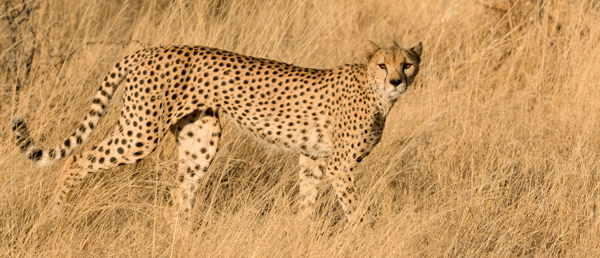
PM. We left before 4PM under partly cloudy skies and, for Samburu, clement temperatures. Tony and Angie had a bull Elephant finally catch up to the young female, but when he attempted to mount her, the enormous difference in size had her collapse. Mating did not proceed and instead the bull simply continued to follow the very young cow.
Mary’s vehicle did extremely well with a wide variety of birds, while my group had a great encounter with more Elephants that literally surrounded our vehicle as they passed, making no noise other than the scuffing kicks as elephants dislodges tussocks of grass they fed upon. Towards the end of the drive we came upon a shy pair of Bat-eared Fox with very, very small pups, but the adults were shy (they usually are in Samburu) and ran off, and the pups retreated deep inside their den. Later, an adult returned, but as we approached it moved off again, and rather than spook it away we backed up and left her in peace.
Day 4. Samburu
The skies were clear, so devoid of moisture that Mt. Kenya was still visible in the distance at 9AM as we had breakfast. We hoped to find Leopard this morning but failed, although we had a fairly good, although fairly shy, Cheetah that was hunting and passing within frame-filling distance of our lenses several times before we lost him in a trackless area.
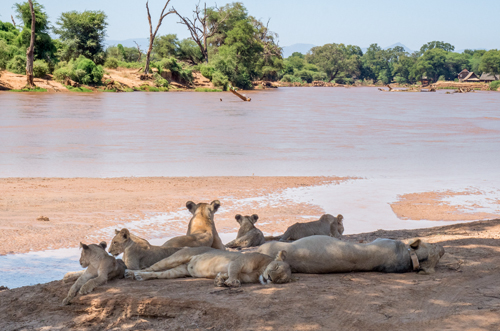
The camera I was using had a nice dynamic range, and this image had extreme contrast. I set the exposure so that the bright areas were not clipped, and later in ACR I tweaked the image to bring in the Lions and tone down the over-exposed background.
Soon after, we found a pride of Lions with three 8 month old cubs and a radio-collared male. They were totally sacked out and beneath a tree, and we left them without taking a shot. By 10:30, however, they had moved to the Iron Bridge area, a favorite ambush spot for the Lions, where we encountered them again. Some tourist vehicles had cut off their original (I presume) access to the river, and to give them room we parked in the shade of an Acacia close to the river’s edge. When the two Lionesses, followed by the three cubs, and later still followed by the male, every cat settled in the shade, almost directly below our vehicle. Eventually we moved off so that we could photograph the Lions from a better perspective than we had, looking almost straight down.
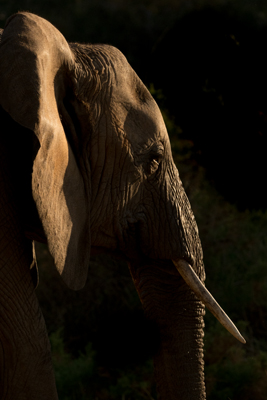
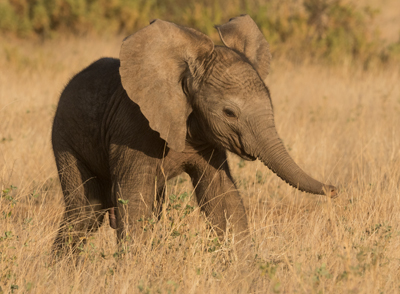
Our vehicle’s shoot began with a family group of five Elephants with a baby under 6 months, still with pink ears and still able to pass beneath the bodies of the mother and the calf’s older siblings. The calf was animated, flapping its ears out wide to Cattle Egrets, who were not impressed. Later in the day we worked on birds, including some nice sequences with Little Bee-eaters.
As the morning progressed the heat grew, and clouds formed, although as I write this at 2:20PM I doubt if they’ll build sufficiently for any rain.
PM. Hoping to find Leopards we headed to Buffalo Springs, traveling rather rapidly to reach the boundary bridge that marks the entrance. Along the way we had more Elephants, and giraffes drinking at the river, and there were some nice landscape/habitat shots looking downriver at the Eles. It was noticeably cooler, and far greener, on the Buffalo Springs side, and virtually all the game seemed to be here. We had at least 100 Grevy’s Zebras, and Rick counted over 40 Giraffes, and figures there were close to 100 scattered about.
We had a nice session with a pair of African Hawk-Eagles perched in a tree, and a Gabar Goshawk that harassed them. I shot in a mode unique to this camera, and got two nice sequences, one with the Eagles in flight and another as the Goshawk buzzed them. No one else captured the shot.
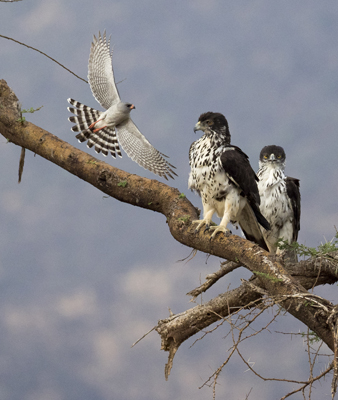
A pair of Impalas in a small bachelor herd spared for several minutes in the open, 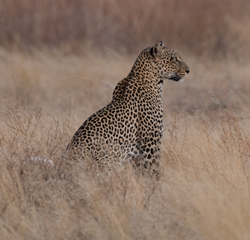 before finally moving out of sight.
before finally moving out of sight.
We got a call that a Leopard was sighted, on the Buffalo Springs side, and we raced there, without any clear directions. We did find the Leopard, but it was nearly dark when we did so, and the shooting, aside from the first few shots when the cat was seated, was very poor. We didn’t arrive back to camp until after dark.
Day 5. Samburu
Another clear, cloudless sky at dawn. We headed back towards Buffalo Springs, hoping to find Leopards, and we succeeded. We had stopped for an Impala mother and young lamb when our guide spotted a cat running across an open spot. The Leopard, a young one, is probably the same cat we filmed last January when her mother dragged a small Nile Crocodile into the open, which the cub then carried into the brush. We followed the Leopard as it moved through the thick, low salt brush, getting several opportunities as it passed into the open, before finally climbing a large Tortillas Acacia tree right in front of us. The Leopard rested upon a limb for a half hour or so before finally descending, straight at our cameras as we had positioned ourselves to be in place at the most obvious line of travel. The cat again weaved through brush before setting in a smaller, very dense tree where we left it.
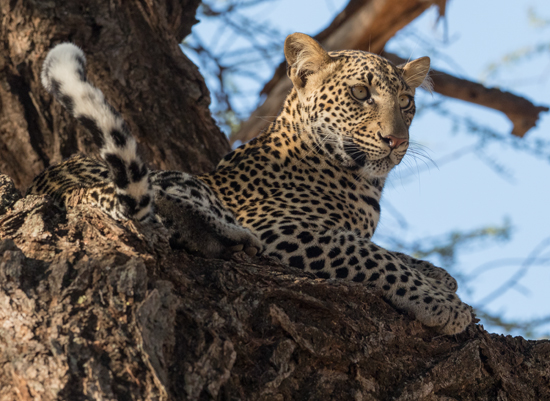
After breakfast at the lookout, where we overlook much of Buffalo Springs to the river, and beyond to the Samburu hills, we marveled that all the herds from yesterday afternoon were gone. Yesterday, in this same area we had scores of animals, but today, just a few small pockets of animals we saw in numbers yesterday. We did have two Grevy’s Zebras scrambling in a play fight, but we were just setting up when the best, and closest interaction occurred, and the Zebras rose on their hind legs to box. Although we followed the group until they disappeared far off-track, we never had another good opportunity.
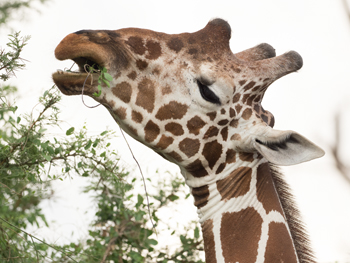 Prior to lunch I set up a camera for a Time-Lapse movie, placing the camera on the lower deck of our porch. Not long afterward a bull Elephant walked down our pathway, and found my camera, mounted on a small tripod. The elephant gently investigated the rig, while I quietly said ‘No, no,’ and Mary gave the ’eh, eh, ehh,’ gorilla-talk for the same message. The Elephant didn’t harm the gear, and lingered around our porch for 15 minoutes or so, just yards away from where I stood, quietly talking to it. Although some of these bulls are supposed to be dangerous (and one must always assume this!), I wonder ….. In Amboseli, researchers with now-decades long experiences with some groups have an incredible relationship with some family groups. Here, though, no one can take any chances.
Prior to lunch I set up a camera for a Time-Lapse movie, placing the camera on the lower deck of our porch. Not long afterward a bull Elephant walked down our pathway, and found my camera, mounted on a small tripod. The elephant gently investigated the rig, while I quietly said ‘No, no,’ and Mary gave the ’eh, eh, ehh,’ gorilla-talk for the same message. The Elephant didn’t harm the gear, and lingered around our porch for 15 minoutes or so, just yards away from where I stood, quietly talking to it. Although some of these bulls are supposed to be dangerous (and one must always assume this!), I wonder ….. In Amboseli, researchers with now-decades long experiences with some groups have an incredible relationship with some family groups. Here, though, no one can take any chances.
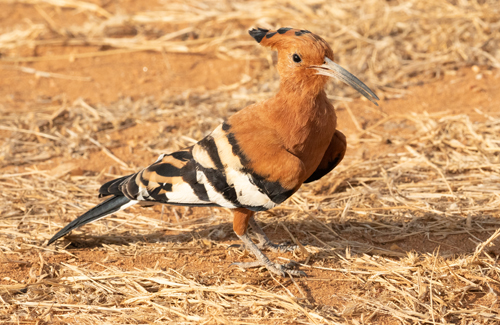
PM. We had a fairly slow afternoon, with my vehicle following the river where we had several encounters with White-throated Bee-eaters, an uncommon species here. African Hoopoes are surprisingly common this year, and I tried a new motor drive feature but the birds flew away from my plane of focus. I was expecting for us to search for yesterday’s Leopard but our bird shooting ate up the time, and as the sun dropped behind the mountains we headed for a SunDowner, a special treat that our lodge provides. In the failing light we watched Elephants crossing the river in the distance, enjoyed a spectacular sunset, and toasted, several times, the start of a great safari.
Day 6. Samburu to Lake Nakuru
We had a cooked breakfast, packed, and were on our way to Nakuru. The roads were good and dry, but with several stops for bathroom breaks, a pharmacy, sunscreen, and supplies, we didn’t arrive in Nakuru until 2:15.
Lake Nakuru was, and the emphasis here is on was, famous for its enormous flocks of Lesser Flamingos. Those days are gone, at least for the foreseeable future, as this alkaline lake has begun to fill, and is becoming increasing fresher, with a subsequent loss on the native fish and invertebrates. Very few Flamingos still feed along the shoreline, and the great flocks of African Pelicans are gone. The water level has risen so high that it is now impossible to circle the lake by vehicle, unless one takes the long and unproductive mountain route. The mud flats, once extending for nearly two hundred yards from the grassy edge, are gone, as are the roads leading to the lake. Yellow-bark Acacia trees are dying, either flooded out completely or their roots saturated, killing trees still seemingly on dry land. No one knows for sure what is causing this, but the suspicion is a change in hydrology and geology, with perhaps a tilting of the continental plate changing the water flow, which now goes downhill, as it were, into Nakuru and surrounding Rift Valley lakes.
At 3:45 the group did a game drive, and did get White Rhinos, Common Zebras, and a few other species. Although it often rains in the afternoon here, today was dry, but thick clouds dropped the light level and, for the most part, the shooting was somewhat slow.
Day 7. Lake Nakuru to Mara Triangle
We left our lodge at 7:10, packed up and ready for our long drive to the Masai Mara. We planned on a relatively short game drive in Nakuru, hoping to target the three subjects found here and nowhere else. We succeeded, getting a White Rhino mother and calf, a big group of Rothschilds Giraffes, and, quite surprisingly, very good Lesser Flamingos. Yesterday, the same area was devoid of birds, but overnight a few thousand arrived, and the birds fed quite close to shore. A spit of land projected into the lake and from there we had frame-filling (with some room) shots, and in great light.
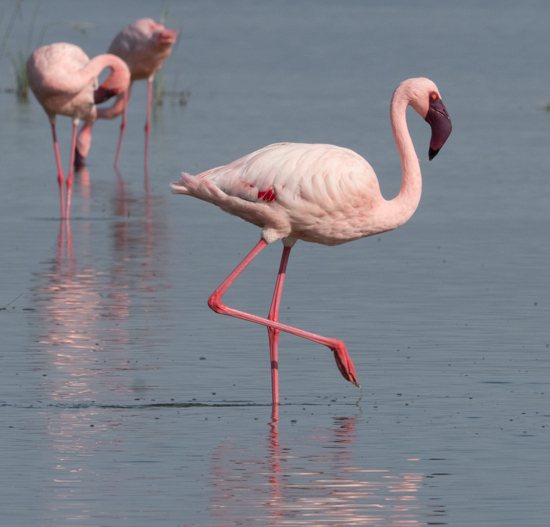
We reached the Park gate by 10, and a few participants did shopping at the curio shop where one of the best carvers in Kenya co-owns the building. From there we headed to the Mara, suffering some very bumpy roads where the Chinese, who were building this road, had stopped construction until the government threatened no other project could be worked on until they finished the road. It should be a good one when finished, but this road may portend a scary future for the area. I wouldn’t doubt that, when completed, that small, individual plots of land will be bought up, and conglomerated, and eventually the Loita Plains, once nearly as rich with game as the Mara or the Serengeti, will be a vast, Montana-like wheat field with huge combines working the area – traveling about on this new, nice, wide road!
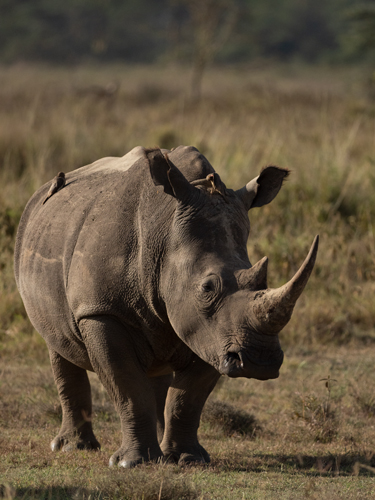 Entering the southeastern gate we saw a small number of almost all of the Mara’s herbivores, but the game was thin and the Mara didn’t look too promising. Until last year, this country was our first stop on any visit to the Mara, but encroachment from Maasai, either moving cattle at night into the park, or raping the land with goats and sheep during the day, had eliminated much of the cover and virtually all of the Lions. As we moved west, coming far deeper into the Park, we were happy to see that large herds of Gnus had returned to the Mara.
Entering the southeastern gate we saw a small number of almost all of the Mara’s herbivores, but the game was thin and the Mara didn’t look too promising. Until last year, this country was our first stop on any visit to the Mara, but encroachment from Maasai, either moving cattle at night into the park, or raping the land with goats and sheep during the day, had eliminated much of the cover and virtually all of the Lions. As we moved west, coming far deeper into the Park, we were happy to see that large herds of Gnus had returned to the Mara.
Oddly, this year the ‘migration’ was very poor, at least during traditional migration times. Gnus barely entered the Mara and didn’t stay long, certainly disappointing the hordes of tourists that come to the Mara with the expectation that they’ll see a river crossing. Despite the few Gnus, our guides told us that over 100 vehicles often crowded the crossing points, sometimes stopping the river crossing in the process. They said it was madness.
In our experience, the migration can occur at almost anytime between June or July when Gnus may enter the Mara for the first time, and December when the last herds may leave. Between those dates, Gnus may come and go, and we’ve seen one week where the plains were empty (the Gnus heading back south into Tanzania), and the next week returning, and filling the plains with animals. So we’re hopeful that we’ll be lucky and the Gnus, quite plentiful on the other side of the river, will choose to cross the Mara River in the next few days.
We arrived at our lodge at 6:15, ready for a break from a very long day.
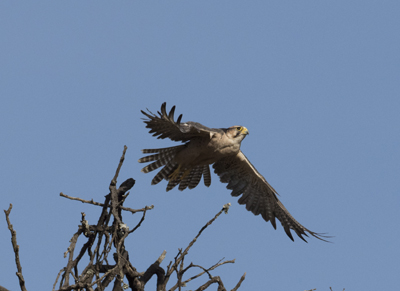
Day 8. Mara Triangle
We loaded and headed to the gate by 6:10, only to learn that the Game Rangers might not let us pass until 6:30AM! Sunrise is at 6:15 or so, but this new rule may have been set in the summer when sunrise times might be earlier. We were allowed to pass, and we heard that this rule was implemented because of infractions by Chinese tourists, although this might be a general blame these days because of other, and numerous, infractions.
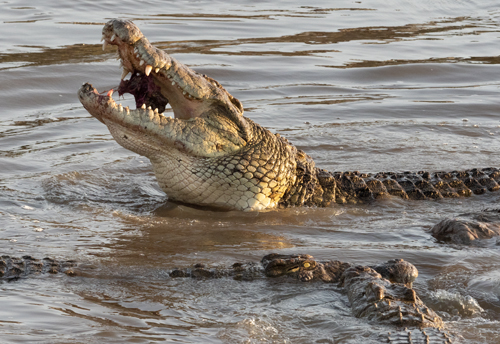
Most of our vehicles headed towards the Mara River where we had several Nile Crocodiles tearing apart a Gnu carcass. The meat was old, as most of the hair on the Gnu’s hide had sloughed off, revealing a white body that resembled a Holstein Cow, except for the distinctive horns of the Gnu. Large male Crocs will hold and defend territory, but it appeared that this wasn’t the case now, as some were true monsters, over 12 foot easily, and fed amiably beside one another and the smaller, most likely female, Crocs that joined them. Crocs would on occasion do massive body spins as they tore off sections of meat or attempted to disarticulate the body, and in doing so the carcass would free itself from rocks and float downriver, the Crocs following. It was a good show.
We were called away by a report of Lions. As it turned out, they were three Nomadic Males that, I believe, have taken over the territory. A Lioness appeared, and acted in a playful, inviting way, flopping to her side and rolling upon her back several times as she slowly moved towards the males. The males were alert, as if they didn’t quite trust her yet, but eventually she trotted by and the three males followed, as did we. Finally, the Lioness settled into a nearly grassless clearing where we laid down, but the males remained in the surrounding bushes where they repeated sprayed urine as they scent-marked, firmly establishing their claim.
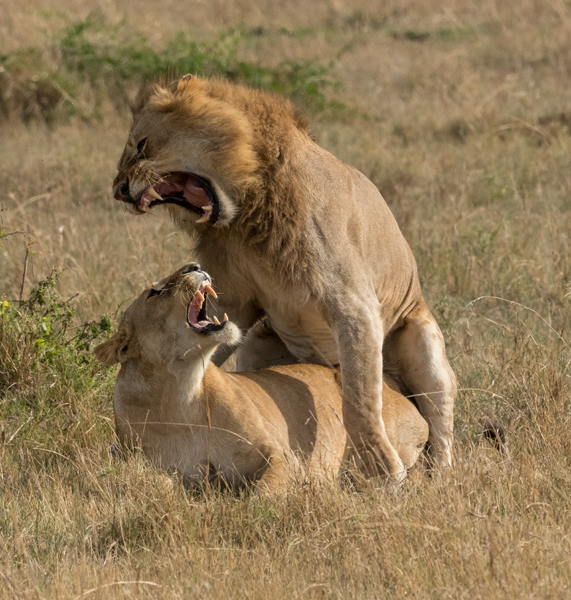
The Lioness got up and headed inland away from the river, with one male behind. Twice she stopped and presented herself, with the following male rushing up and mating. She was fresh, and feisty, and the conclusion of each mating ended with good snarls and attempted swats. Eventually they moved on, off to a trackless section of grass.
Mary’s vehicle hunted for Black Rhinos, unsuccessfully, but they did have another group of Lions where a one-year old cub repeatedly chased Zebras, seemingly to make them run.
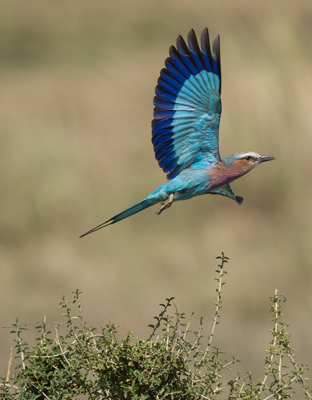 Most of us had a very good session with a Liliac-breasted Roller, and another that replaced the first at a perch. At one point the second flew in to replace the first, and several shooters caught both birds in flight. Along with other subjects – Topi, Giraffe and baby, and birds – it was a great start to the Mara.
Most of us had a very good session with a Liliac-breasted Roller, and another that replaced the first at a perch. At one point the second flew in to replace the first, and several shooters caught both birds in flight. Along with other subjects – Topi, Giraffe and baby, and birds – it was a great start to the Mara.
Our last observation of the morning was interesting, and puzzling. A pod of Hippos were on the opposite shoreline, with one female coming ashore, gaping widely as she walked. Eventually she joined another, slightly larger hippo, and both began nuzzling and licking another, slightly smaller Hippo lying flat on the sandbar. A subadult joined them, and nuzzled the prone Hippo, which looked uninjured and healthy. Both larger adults yawned several times, and the nearest, after a licking bout, drew away with two long white strings of saliva bowing from her jaws to the back of the prone Hippo. The only reason we could think of was the prone Hippo was pregnant, and might give birth soon. We just don’t know.
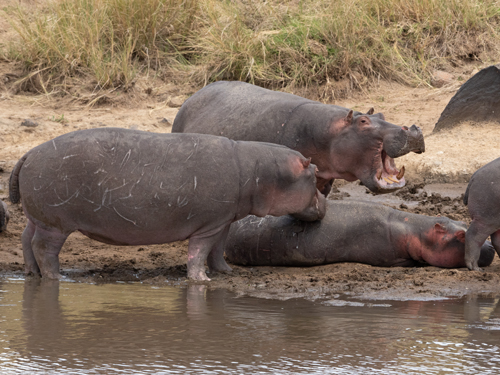
PM. We headed south, with heavy rain clouds forecasting scattered showers. Throughout the afternoon the light was soft, and, at the end of the drive, the rain came, and we drove home with a good shower pelting those of us who still stood upright in the vehicle.
Gnus were gathering in large herds on the opposite side of the river, and we headed down to one of the major crossing areas but the Gnus never crossed. Small, scattered herds of Gnus and Zebras dotted the plains, and we had fair luck with several pair of Zebras that play/fought. Mary’s vehicle spotted two Lionesses, young ones that had not yet had cubs of their own, and are radio call was conveyed that that vehicle had cubs playing! Nonetheless, it was a worthwhile visit, as the two young Lionesses groomed one another and swatted playfully.
Day 9. Mara Triangle
Leaving prior to 6:30AM was no problem today, and we headed south, intending to eventually reach the Mara River and to wait for a gnu river crossing. Just prior to sunrise we had a pair of Gray Crowned Cranes perched on an acacia close to the road. The birds were very vocal, giving a low murmuring call in addition to the traditional bell-like honking. Just as the sun crested the eastern hills the birds took off, everyone snapping away in unision.
We headed towards the Tanzania border where we often have a Lion pride and/or Cheetahs. The area has been extensively burned – perfect for Thompson’s Gazelles, but game was rather scattered. I heard a Spotted Hyena whoop, followed several seconds by more, and more. Hyenas at night may call to keep in contact, but by day repeated whoops signal an assembly, a call for reinforcements, usually done because a lone, or a few Hyenas have found a Lioness at a kill and hope to drive her off. We back-tracked and went looking.
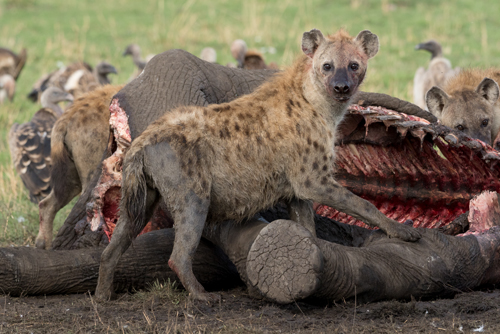
From a distant ridge our guide spotted the source, a gathering of over 200 Vultures and several Hyenas, and, we assumed, lions. By the time we reached the location the cause of all the whooping was nearly finished, which was two clans of Hyenas gathering and contesting a dead Elephant. The two rival factions faced off with one another, their tails curled over their back and bristled – a sure sign of aggression, and the two clans advanced and retreated, contesting the area in front of the Elephant. One group must have been larger – perhaps 25-30 Hyenas vs 15-20 in the other group, and eventually the rivals moved off.
We spent well over an hour with the Hyenas, which did a great job of reducing much of the Elephant. Vultures, mostly Ruppell’s and a lesser number of White-backed, waited their turn, not trying to horn in with the Hyenas, and risk injury. Two different Black-backed Jackals joined the Hyenas, and except for a few short chases they were mostly ignored – there was enough food for all.
The Elephant was a subadult, the cause of death unknown, but the Rangers had hacked out the small tusks, leaving a gaping wound that was now reduced to barely more than a skull. Rangers always take the tusks, eliminating any chance of illegal sales (we hope).
When only a half dozen or so Hyenas remained we headed out, hoping to get a Gnu crossing. As we neared the river we discovered they had already crossed, and judging by their distance from the river we suspect they did so quite early in the morning. We had breakfast – nearly 10:30AM, and continued the game drive, stopping for a family of 5 Lions, and, as we reached the lodge, a two-second sighting of a Serval.
PM. The afternoon was slow, although several of our vehicles had a very good encounter with a Serval at the very end of the day. We headed south, checking on a Gnu crossing, but the thousands of Gnus grazing on the opposite shore were scattered, with no build-up for a crossing. My vehicle headed towards the Elephant carcass, passing sleeping Lions and reaching the carcass with only a few minutes of shooting left before we needed to race back to camp. Along the way we had a brief but excellent session with a rare Side-striped Jackal, a grassland species that sports a white-tipped tail, like a fox.
.jpg)
Two Hyenas were still feeding, with Hooded Vultures now joining the few White-backed Vultures still present. Feathers scattered everywhere, and a carcass probably only 1/3rd its previous volumn, indicated that the Vultures did have a feast, and as we turned to go more Hyenas were returning to the carcass. As we neared camp the cloudy sky broke on the horizon, and beautiful soft, orange light bathed the landscape. We couldn't find a foreground, and kept driving, hoping to encounter a Giraffe or Elephant, but we were unsuccessful. A few of our other vehicles, on other routes, had better luck with Elephants silhouetted against the sky.
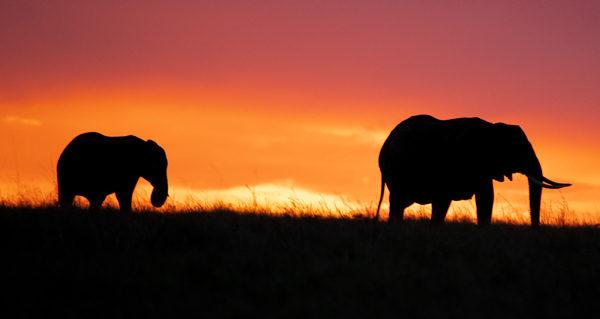
Day 10. Mara Triangle to Upper Mara
We planned on packing the vehicles at 5:45AM, twenty-five minutes before sunrise, and in the predawn gloom it was confusing. One participant went to his vehicle before his luggage did, and consequently it was left behind. Later we received a call that the luggage was at the lodge, and after meeting with a friend leading another tour who saw two pieces there, my vehicle headed back. When we arrived, only one piece was there. We radioed our vehicles, who removed all the luggage for a check, and found nothing. Later, we discovered that my friend’s driver put the luggage in his vehicle! We got it back and all was well. Lesson learned, and something we’ll need to repeat, and emphasize, frequently on future safaris.
We were headed to the Mara River, hoping for a Gnu crossing. By the time my vehicle got the luggage straight we were told nothing was happening, and we started on another route. Seconds later we were told to come, and to hurry, as the Gnus were massing at the river.

We arrived in time, but over the next hour or so the movement slowed, with Gnus settling down or milling about. I decided, if a crossing would occur, it would be long after we had to leave, as we had to reach the new camp by noon.
We started north, salvaging what otherwise would have been a very unproductive morning. We had a mother Black Rhino and nearly full grown calf (with horns nearly as long as mom’s) in the open, but distant; a nice parade of Maasai Giraffes; an approaching cluster of Elephants; and three good chances for a Liliac-breasted Roller taking off. I was changing a setting when the second, and best, flight occurred, but managed nice shots on the other two.
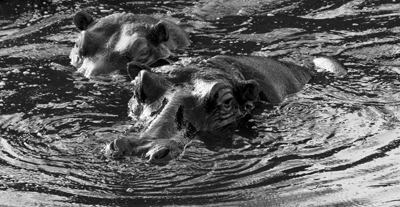
By 11AM we were at the Oloololo Gate for our drive out of the Triangle Conservancy and into the Narok side of the Masai Mara. After crossing the Mara River bridge and climbing the atrociously maintained main road that leads up onto the plains, and Mara Rianta, we entered country that, thirty years ago, was the site of our game drives. Where we once had Cheetahs sitting on our roof here, Leopards calling their cubs from termite mounds, and Lions mauling Maasai warriors (we saw the aftermath), we now had sprawling cinder block buildings, tin-walled farmets, wire and stone fences, vehicle repair kiosks, and plastic trash everywhere. It was gut-wrenchingly depressing.
As we continued east towards the Aitong Hills we left the squalor, entering open, nearly treeless plains where ground cover – nearly bare as we left Rianta – gradually became a knee-high grassland. We passed a few cattle herds, but we were happy to see that now there are a few large, metal-fenced bomas for the cows to be kept at night. Small, one-man tents were set up on the periphery – for the herders, a far less safe position than the cows had.
Our camp is situated in a small forested grove, with the tents on the edge looking out over the open grasses. The accommodations are beautiful, set up like a luxury Botswana safari camp. We settled in and prepared for the afternoon game drive.
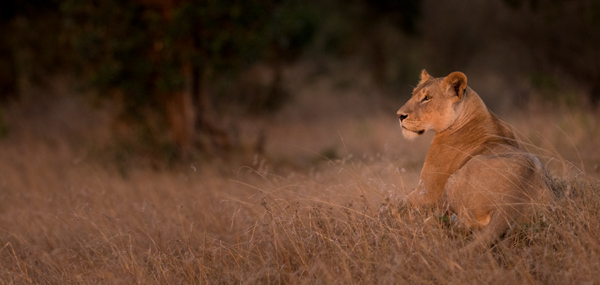
PM. We started our game drive at 4, crossing what first appeared to be barren grasslands with small flocks of Thompson Gazelles and Gnus. A Nubian Vulture nest offered some distraction, and later a pair of what appeared to be orphaned Lion cubs. A Lioness had been severely injured earlier, and we suspect these were her cubs. They didn’t look like they had long to live.
As we headed towards home we found a pair of male Cheetahs, and they provided near frame-filling shots. Not far away, a pride of Lions were on the edge of the forest, with one Lioness sitting in golden light on top of a termite mound. The western sky was spectacular, and we ended the day with Zebras and Acacia trees framed against the glowing orange sky.
Day 11. Masai Mara
We left at 6 and headed towards the distant escarpment and the Mara River. The drive started somewhat slowly, but soon became fantastic. One of our guides spotted some Lionesses with large cubs, and as my vehicle approached another 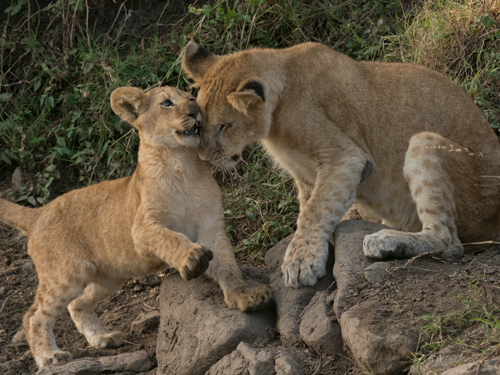 Lioness with small cubs, including the orphan, starving cubs from last night, walked in and joined the group. Over the next hour or more we followed the pride as they slowly moved up, around, and inside a lugga, stopping occasionally to play or drink. A family of Warthogs trotted towards them and one of the Lionesses went into a great stalk, using the termite mounds as cover, but instead of targeting one piglet she looked like she just charged into the group, and all escaped. We eventually left the pride, 15 in all, in the shade of a tree, all resting atop grass-covered termite mounds.
Lioness with small cubs, including the orphan, starving cubs from last night, walked in and joined the group. Over the next hour or more we followed the pride as they slowly moved up, around, and inside a lugga, stopping occasionally to play or drink. A family of Warthogs trotted towards them and one of the Lionesses went into a great stalk, using the termite mounds as cover, but instead of targeting one piglet she looked like she just charged into the group, and all escaped. We eventually left the pride, 15 in all, in the shade of a tree, all resting atop grass-covered termite mounds.
We headed to the river for breakfast where we had a good shoot with Hippos that were playing, mouthing each other, and a mother and calf doing the same. As we left the river a herd of Giraffes were seen about to cross the Mara River. In all, 10 started to cross, but a Hippo walked upriver and disrupted the crossing, and afterwards 8 of the 10 retreated to the original bank. Two stayed behind, seemingly torn between following the herd or crossing, and eventually the 8 returned. Another crossing started, but a herd of Zebras entering the river on the opposite bank probably stopped them again, and the Giraffes turned back and headed back into the forest. The zebras drinking was a nice bonus however.
Continuing on, we found two of the new male Lions, and beyond them, two more cubless females, not very far from a herd of Maasai cattle. Significantly, none of the cows had the obnoxious cow bells, and so the Lions slept on peacefully. We suspect that Maasai are allowed to graze on the land provided they follow some rules, including no cow bells.
As we returned to camp we learned that a Leopard was located, and the Park Rangers led our vehicles to the Leopard, sitting under a bush. The shots were fair, there, but later the Leopard climbed a tree where she presented great views for all of our vehicles. We reached camp around Noon – the best day of the safari to date.
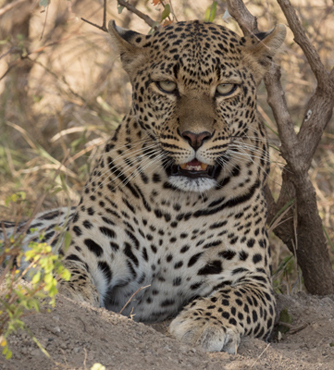 PM. We started our game drive with the Leopard, with everyone taking turns and several minutes photographing the Leopard which was eating a baby Warthog it had captured in our absence. An adult Warthog ran by, close, later on, but whether the Leopard was full or realized she was out-matched, she did nothing but watch it pass. My vehicle lingered in the shade, letting other safari vehicles take their views, and while we waited, after they left, the Leopard moved to an open clearing atop a Warthog burrow. The shooting from that location was superb.
PM. We started our game drive with the Leopard, with everyone taking turns and several minutes photographing the Leopard which was eating a baby Warthog it had captured in our absence. An adult Warthog ran by, close, later on, but whether the Leopard was full or realized she was out-matched, she did nothing but watch it pass. My vehicle lingered in the shade, letting other safari vehicles take their views, and while we waited, after they left, the Leopard moved to an open clearing atop a Warthog burrow. The shooting from that location was superb.
Mary radio-called that she had a Lioness with a fresh Zebra kill, with Hyenas beginning to investigate. When we arrived, one Hyena had returned to its den, and drew in first two, then three reenforcements, and as a Trio that Hyenas drove the Lioness from the kill. She tried once to reclaim it, chasing the Hyenas, but soon gave up and disappeared in the brush.
More Hyenas arrived, including subadult and fairly small juveniles, and a few Vultures, and the carcass was reduced in a short while. We were told of some small 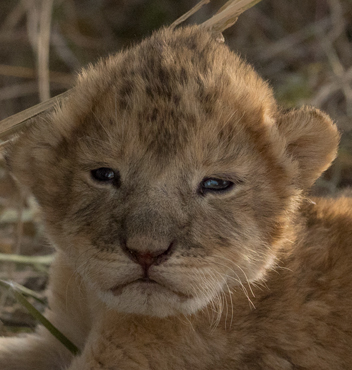 Lion cubs quite near a track, and we did a brief visit there – the cubs were in the most open and vulnerable location I’ve ever seen, and we didn’t want to linger or create clear tracks that might draw to much attention. The cubs were among the smallest we’ve ever seen, too, about 12 days old, with their eyes barely open.
Lion cubs quite near a track, and we did a brief visit there – the cubs were in the most open and vulnerable location I’ve ever seen, and we didn’t want to linger or create clear tracks that might draw to much attention. The cubs were among the smallest we’ve ever seen, too, about 12 days old, with their eyes barely open.
My vehicle headed back towards the Leopard, but so many vehicles had lined up for a look that we drove on by, encountering a pair of Giraffes walking along the crest of the horizon, with a pre-sunset but colorful sky framing them completely. We dropped onto the lowest track we could find to shoot silhouettes, and by the time we finished, almost all of the vehicles at the Leopard had left.
We decided to stay, and eventually – an easy 30 minutes or more – the Leopard awoke, stretched, yawned, and walked down from its mound, disappearing into a warthog burrow! Five minutes later it emerged, and for the next ten minutes, as the light vanished, we followed the Leopard as it walked down a game track. A great encounter.
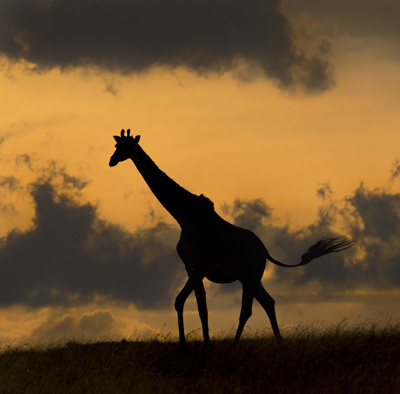
Day 12. To our Last Masia Mara Camp
A boxed breakfast wasn’t available and instead we had a cooked breakfast at 6, which I had hoped would be completed in twenty minutes or so and we’d be on our way. We didn’t leave until 7, as service was in bursts and vehicle packing wasn’t completed until later. Apparently we didn’t miss much but early light, as none of the vehicles already in the field located anything of interest.
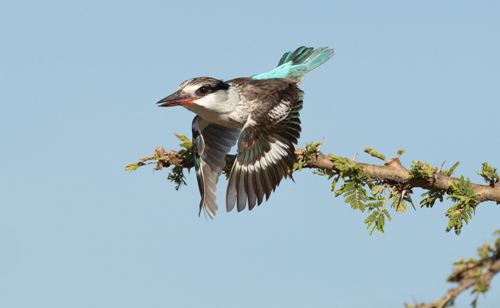
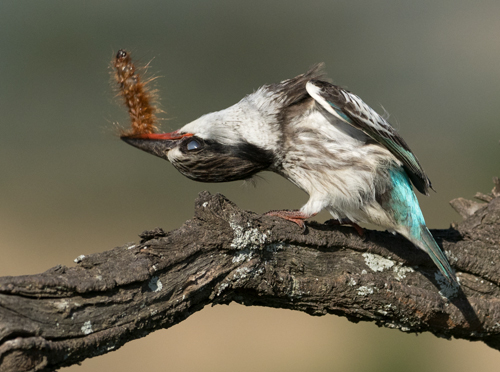
I spotted a Striped Kingfisher, an open woodland species that I haven’t had a chance to photograph for years. This one allowed a close approach, afterwards flying off and catching a spikey, wooly-looking caterpillar which it consumed.
Later, we found what may have been a mating pair of Lions, but the male (the only one clearly visible) was fairly robust, so either a honeymoon was about to start or it had ended, and they had made a small kill while still together. After thirty minutes of watching a sleeping Lion we moved on, heading towards our next destination.
We did find the pride, although a bit dispersed, as there were only 10, and yesterday 15 or so. The smallest cubs, including the orphans, were not present, so we hope that they have not been abandoned. The cats were at a trot when we found them, moving into croton bushes to keep out of sight of Maasai herdsmen with large herds of cattle about a quarter mile away. We saw several cattle herds.
Our route kept us away from cancerous Mara Rianta village, and through country that, back in the day, we did game drives through on a regular basis. Much of the acacia cover was gone, but in the double-walled gorge where we filmed Half-tail and Swati, the Leopards, we found Hyrax and Hyenas, so the area still supports game.
At the Mara Reserve Gate the atrocious road entrance was now reasonably passable – it used to be a national disgrace, and a few dozen Maasai women tried hawking wares. Cattle and sheep were in a pen, confiscated, we were told, for illegally grazing.
The grassland was thick and healthy looking in Red Oat grass. There were few game tracks, so game-driving in that area would be extremely difficult since off-road driving isn’t permitted. As we neared our new camp game, and game tracks, increased, promising better viewing ahead.
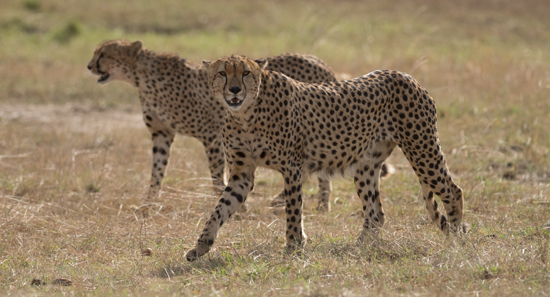
PM. A coalition of unrelated male Cheetahs – a very rare if not unprecedented coalition – were sighted nearby and we headed directly to the cats. So did everyone else, and 31 vehicles converged on the four male Cheetahs (a fifth had separated at the time), jockeying for position and, ultimately, blocking the cats view of potential prey, when vehicles were not actually driving potential prey further away from the hunting Cheetahs. These big, powerful Cheetahs kill adult Gnus, Topis, and young Zebras, but the chaotic and disrespectful manner of so many of the drivers (vehicles) was such that we simply couldn’t stand it and we drove off.
Before it simply got crazy with all the vehicles racing about we did manage some nice shots, and had we asked our driver/guides to stay with the cats, I’m sure we’d have had plenty more. But it simply wasn’t worth it, and we were sickened by what we saw, how the Mara has deteriorated in a crazy free-for-all of drivers.
We moved on, encountering a nice male Lion and female who were eventually chased off by a pair of African Buffalo. Nearby, 11 other Lionesses and older cubs lounged in the grass, completely invisible until they rose.
We continued, shooting some hipps, good Grants Gazelles and Thompson’s Gazelles, and some birds for a nice afternoon truly far away from the maddening crowd.
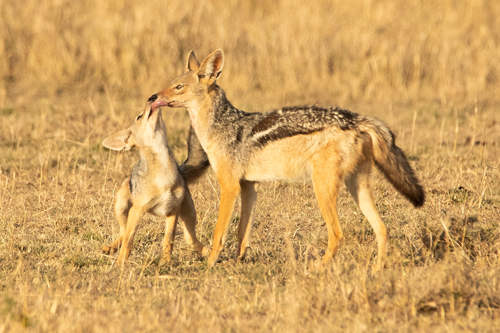
Interestingly, one of our guides wrote an article for SWARA, the East African Wildlife Society's magazine, where he discussed the unethical, unlicensed drivers that are ruining the Mara. It was all set for publication when the top brass in the department nixed it, saying that it put Kenya in a bad light and would make Uganda and Tanzania, and other countries, look more appealing. That's censorship, and by only publishing one side, sugar-coating a disasterous situation, one could label that Fake News! Imagine that! Hearing this, I was extremely disappointed with the courage and integrity of the SWARA editors.
Day 13. Upper Mara
This morning was the polar opposite of yesterday afternoon. We heard about a Lion dragging off a Zebra, and we saw vehicles racing in that direction, and so we chose to go our own way. It was a great morning.
We started with a pre-sunrise Acacia tree and Topi silhouetted against a bright sky. Soon after, we had several young Lions walking across the plains, and later still an unsuccessful hunt as a Lioness missed what should have been a sure-thing kill of Warthogs. Later in the morning this happened again, as a confused Topi calf bounded back and forth in front of both Hyenas and Lions, but eventually the Topi made it back to its mother where it immediately nursed.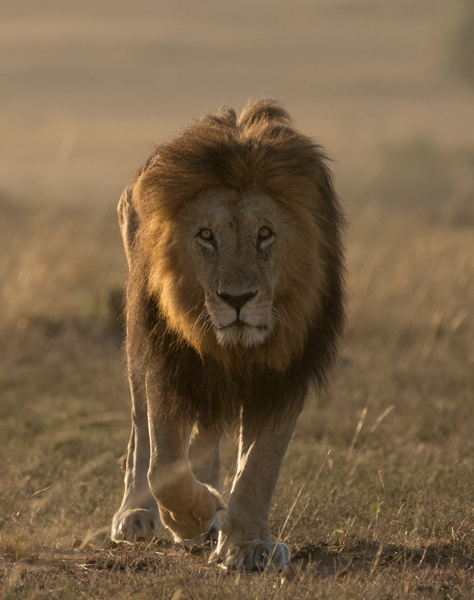
We had a very good male Lion, walking towards us across the grasses, and later, for most vehicles, wonderful shots of the Lion drinking, including its reflection. A few other highlights of the morning included a Jackal regurgitating food to pups; a young Hyena working on the jaw of a Warthog – where we hoped both tusks would be on either side of the Hyena’s mouth, but didn’t; and the male Lion scent marking our vehicle, and spraying one participant’s Molar Bag.
In all, we had 20 different Lions this morning.
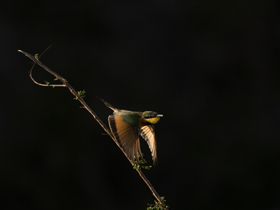
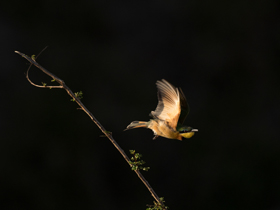
PM. We crossed the Talek River to cover the area south of camp. Mary spotted a very tolerant Serval far off the road, the only cat for the afternoon. My vehicle had one of the best Reedbuck encounters I’ve ever had, with the buck rising and grooming, full-frame, rather than bounding off as they usually do. We had a mini Gnu and Zebra crossing at a lugga, and I had another great a new motor drive feature sequence of a Little Bee-eater, the only one who captured the flight sequences. Rangers were about, and we returned to camp shortly before 6:30PM.
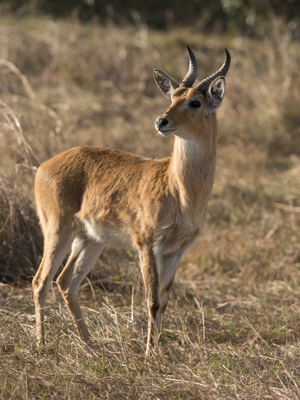
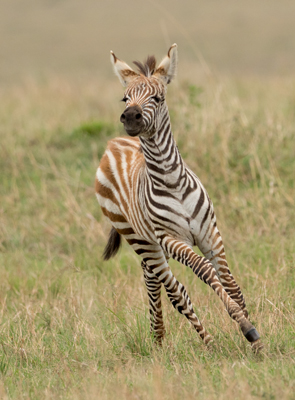
Day 14. Upper Mara
We left at 6 and headed towards the large Lion pride. One of our vehicles found them and we all headed in that direction. When I arrived, 13 Lions were scattered across the very open grassland, with two males, one older and thin, and not too healthy-looking, and a younger one in better healthy. We had a series of shots with the males walking towards us.
We followed the cats to the forested luggas, where a few of the juveniles approached quite closely to Buffalo, which half-heartedly charged the Lions, driving them off.
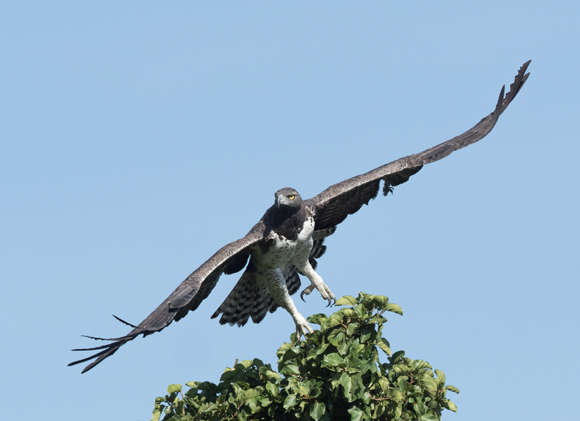
A Martial Eagle was nearby and very visible, and after getting close enough for a wonderful, full-frame flight shot, we waited twenty minutes until the bird took off. I was using a new motor drive feature and fired too soon, catching the bird while still in the frame, with the rest of the images in varying stages of lift-off. Had I waited an instant I’d have had the wings fully out.
It was now 10:15 and we still hadn’t had breakfast, and on the way I spotted a Nile Monitor with something in its mouth. It was a large African Bullfrog, which the Monitor carried towards a rocky shoreline where it eventually swallowed the frog, after scraping it along the rocks to push the spread-eagled legs together.
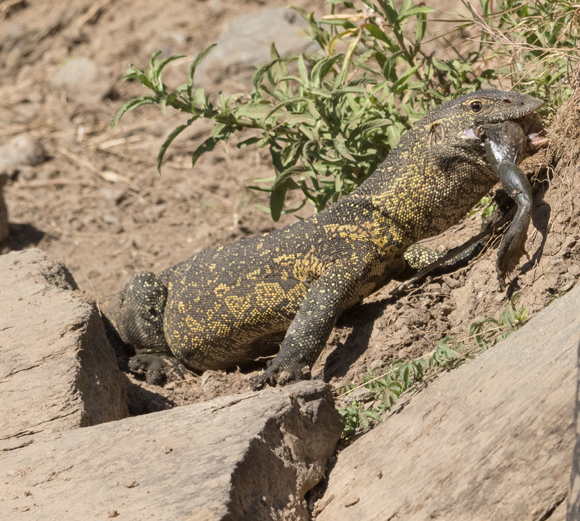
One of our participants spotted a Leopard, but by the time we arrived either Hyenas or an advancing troop of Baboons forced it into hiding and abandoning its kill. Vultures and Maribou Storks swooped in, giving us some more chances for flight shots. The Leopard was in hiding and while we watched the Baboons and Vultures it reappeared, probably from a burrow, and ran off, with the Baboons barking alarms and screaming and in pursuit. We didn’t see the Leopard again, and eventually headed for a late breakfast.
PM. We hoped for more Cheetahs and headed south, crossing the Talek and driving a straight 30 minutes towards the Lookout Hill, passing Serena Lodge far to our right, its antennae prominent against the skyline. The other drivers we met directed us further, where we finally found several cars parked along a track, watching a mother Cheetah with 9 month old cubs. Unlike the chaos and madness 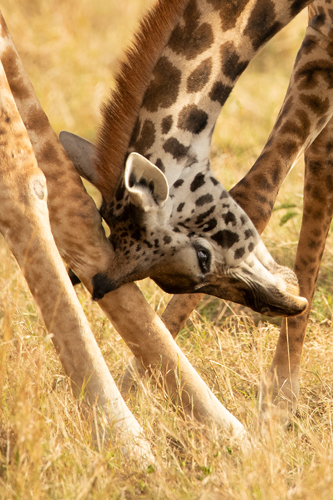 of our previous Cheetah encounter, everyone was now quite sane, keeping their distance and allowing the Cheetahs to walk to and passed them. The cats eventually moved into a large trackless area where they watched a small group of Thompson Gazelles, and the now 23 vehicles parked in two lines, far off, in anticipation of a chase. The Cheetahs settled, with the mother eventually lying down and the Gazelles moving far enough away that the likelihood of a hunt was unlikely. We headed home, hoping to find something interesting along the way. We did not, and arrived in camp shortly before 6:30.
of our previous Cheetah encounter, everyone was now quite sane, keeping their distance and allowing the Cheetahs to walk to and passed them. The cats eventually moved into a large trackless area where they watched a small group of Thompson Gazelles, and the now 23 vehicles parked in two lines, far off, in anticipation of a chase. The Cheetahs settled, with the mother eventually lying down and the Gazelles moving far enough away that the likelihood of a hunt was unlikely. We headed home, hoping to find something interesting along the way. We did not, and arrived in camp shortly before 6:30.
The camp had a special dinner set up for us, where we did Trip Highlights and reviewed the great experiences we had. Surprisingly, Giraffes were among the top picks for highlights, and for memorable photos, as well as Lions, Leopards, and Elephants.
After last year’s flash flood in Samburu and the preceding year’s severe drought in the year before. Samburu had brought in their cows, wild herbivores starved, and the land was denuded. This year, the grasses were back and the domestic herds were gone, and the future looks promising.
Nakuru’s waters still continue to rise, flooding the nearly iconic Yellow-barked Acacia trees that line the lake, creating a landscape of blackened skeletons of dead trees. Flamingos, dependent upon brackish water for their food, were present this year, arriving overnight in a flock of several thousand. The lake’s prospect, declining tourism and with it the quality of the service at the lodges there, bode for a future we’ll avoid.
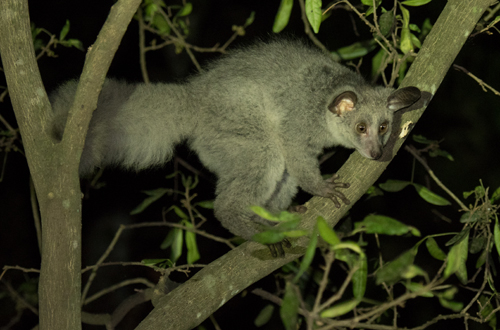 The Mara’s game was definitely down from anything we’ve experienced before, but portions of the Mara are extremely well managed. The official Mara National Reserve, managed by the Narok County Council, a Maasai group, continues to disappoint, with the Rangers there far more interested in harassing safari drivers and inconveniencing tourists over petty offenses like a tire off track, than doing the job of policing crazy local drivers (often Maasai) who chase game, interfere with crossings and hunts. The story we hear is the Maasai’s response is, basically, this is their land and they can do what they want.
The Mara’s game was definitely down from anything we’ve experienced before, but portions of the Mara are extremely well managed. The official Mara National Reserve, managed by the Narok County Council, a Maasai group, continues to disappoint, with the Rangers there far more interested in harassing safari drivers and inconveniencing tourists over petty offenses like a tire off track, than doing the job of policing crazy local drivers (often Maasai) who chase game, interfere with crossings and hunts. The story we hear is the Maasai’s response is, basically, this is their land and they can do what they want.
Despite all this, we had a very complete trip with great shots of all our target species. While game was less abundant, every drive was productive, and I remember back in the film days, in the 1990’s, when I might not shoot a single roll of film on a morning game drive, as we either found little or nothing that was novel. That was when game was still abundant, and now, with digital, it’s highly unusual to not shoot the equivalent of at least 10 rolls of film on any game drive, and often the equivalent of 30 or more.
We’ll be back … in 2020, as our schedule in 2019 is completely full with other trips. We expect the management progress we’ve seen will only continue to improve.
Why you should travel with us
Testimonials
Join us on Facebook at: Follow Hoot Hollow
Office Phone: (717) 543-6423
Or FAX us at: (717) 543-5342
Mary and Joe are proud to endorse the Photo Retailer that has
done the absolute most in supporting nature photography in all
its facets ---

Check out the Monthly Specials
from Hunt's
Check out these TPPA specials!

click the leopard for the eagle
Kenya November 2018
After our five days of treking in Rwanda for Mountain Gorillas, we continued with a two week safari in Kenya. The drought of two years ago is over, and vegetation had returned to Samburu. Gnus, which did not return to the Mara in any numbers during the summer, had returned to the areas we were visiting, but there were no river crossings for us.
We had a surprisingly productive trip, with success with all our target species -- a couple very good Leopards, beautiful male Lions, the smallest cubs we've ever seen, Elephants in Samburu, and so much more, including some excellent bird shooting opportunities. The Masai Mara's management, in many sectors, has been disasterous and apparently corrupt, but this year we did not see any cattle inside either the Mara Reserve or in Samburu, and that's real progress from a few years ago.
I was trying a new camera system in addition to the Canon cameras Mary and I usually use, and I captured bird shots like never before, shots that I'd have missed, and that my fellow photographers did miss. I'm still exploring the possibilities here, and I'll say more on this in a future posting.
For now, here's the trip report:
Day 1. Kilgali, Rwanda to Nairobi, Kenya
We arrived from Kilgali, and our five Mountain Gorilla treks, in mid-afternoon. We had our Orientation meeting at dinner, while waiting to be served, which worked great and gave us more free-time (or less of a sense of being rushed) the following morning as we headed to Samburu.
Day 2. Nairobi to Samburu
We left our hotel at 8:10, stopping in route at a curio shop for a bathroom and snack break before continuing to Tree Trout where we had lunch. We were prepared for the Black-and-White Colobus Monkeys and we were extremely lucky. One female had a 20 day old baby, still white – as they are when born, that posed wonderfully on a limb and later on the ground. After 30 minutes or so of shooting the troop wandered off, and we headed to lunch, just minutes before a pouring rain. Great timing!


After lunch we headed on to Samburu, going through the Kenya Highlands in the rain, before dropping to the lower elevation that would lead to Samburu. Ahead of us, to the East and North, the landscape was obscured by a dark veil of rain, and after passing through Isiolo towards Archer’s Gate and the entrance to Samburu we drove by flooded fields from the heavy rain. Surprisingly, Samburu was dry, and only as we neared our lodge did we find any evidence of rain – from the day before.
The Isiolo River is flowing, although the water is safely below the normal river bank. Although we didn’t shoot – intending to arrive in time for everyone to unpack in the light, we did see Oryx, Gerenuk, Dik-dik, Grant’s Gazelles, Desert Warthogs, and Vulturine Guineafowl on the drive in. As we neared camp a herd of Elephants, their legs still dark from their river crossing, passed within feet of our vehicle, in single file and unconcerned by our proximity. It was a wonderful introduction to Kenya’s wildlife for several of our participants who had never been to Africa before. We reached camp at around 4:45, had an orientation about camp safety, and settled into camp.
Day 3. Samburu
Our first game drive and the pre-drive arrangement of beanbags on the roofs of the vehicles went well, and by 6:15 we were on the road. We did not travel far today, as almost immediately we found the first of several herds of Elephants that were headed to the river. At one point, strangely, one herd broke into a run, but after investigating we assume that Rangers, on foot, spooked the herd.
Eventually dozens of Elephants made it to the river where all of our vehicles photographed them drinking from several angles. Three bulls continually followed and harassed a female that undoubtedly was coming in to her first heat – she was tiny – and throughout the morning we saw some level of pursuit.



Between Elephant shoots, photographers shot Long-crested Eagles, Baboons, Oryx, Warthogs, Giraffes, and Grants Gazelles, and several species of birds. Towards the end of the morning we found a lone Cheetah, which might be one of a group of three surviving nearly full-grown cubs, or may have been the mother. While the cat looked hungry, she eventually settled down to sleep and we went on.

PM. We left before 4PM under partly cloudy skies and, for Samburu, clement temperatures. Tony and Angie had a bull Elephant finally catch up to the young female, but when he attempted to mount her, the enormous difference in size had her collapse. Mating did not proceed and instead the bull simply continued to follow the very young cow.
Mary’s vehicle did extremely well with a wide variety of birds, while my group had a great encounter with more Elephants that literally surrounded our vehicle as they passed, making no noise other than the scuffing kicks as elephants dislodges tussocks of grass they fed upon. Towards the end of the drive we came upon a shy pair of Bat-eared Fox with very, very small pups, but the adults were shy (they usually are in Samburu) and ran off, and the pups retreated deep inside their den. Later, an adult returned, but as we approached it moved off again, and rather than spook it away we backed up and left her in peace.
Day 4. Samburu
The skies were clear, so devoid of moisture that Mt. Kenya was still visible in the distance at 9AM as we had breakfast. We hoped to find Leopard this morning but failed, although we had a fairly good, although fairly shy, Cheetah that was hunting and passing within frame-filling distance of our lenses several times before we lost him in a trackless area.

The camera I was using had a nice dynamic range, and this image had extreme contrast. I set the exposure so that the bright areas were not clipped, and later in ACR I tweaked the image to bring in the Lions and tone down the over-exposed background.
Soon after, we found a pride of Lions with three 8 month old cubs and a radio-collared male. They were totally sacked out and beneath a tree, and we left them without taking a shot. By 10:30, however, they had moved to the Iron Bridge area, a favorite ambush spot for the Lions, where we encountered them again. Some tourist vehicles had cut off their original (I presume) access to the river, and to give them room we parked in the shade of an Acacia close to the river’s edge. When the two Lionesses, followed by the three cubs, and later still followed by the male, every cat settled in the shade, almost directly below our vehicle. Eventually we moved off so that we could photograph the Lions from a better perspective than we had, looking almost straight down.


Our vehicle’s shoot began with a family group of five Elephants with a baby under 6 months, still with pink ears and still able to pass beneath the bodies of the mother and the calf’s older siblings. The calf was animated, flapping its ears out wide to Cattle Egrets, who were not impressed. Later in the day we worked on birds, including some nice sequences with Little Bee-eaters.
As the morning progressed the heat grew, and clouds formed, although as I write this at 2:20PM I doubt if they’ll build sufficiently for any rain.
PM. Hoping to find Leopards we headed to Buffalo Springs, traveling rather rapidly to reach the boundary bridge that marks the entrance. Along the way we had more Elephants, and giraffes drinking at the river, and there were some nice landscape/habitat shots looking downriver at the Eles. It was noticeably cooler, and far greener, on the Buffalo Springs side, and virtually all the game seemed to be here. We had at least 100 Grevy’s Zebras, and Rick counted over 40 Giraffes, and figures there were close to 100 scattered about.
We had a nice session with a pair of African Hawk-Eagles perched in a tree, and a Gabar Goshawk that harassed them. I shot in a mode unique to this camera, and got two nice sequences, one with the Eagles in flight and another as the Goshawk buzzed them. No one else captured the shot.

A pair of Impalas in a small bachelor herd spared for several minutes in the open,  before finally moving out of sight.
before finally moving out of sight.
We got a call that a Leopard was sighted, on the Buffalo Springs side, and we raced there, without any clear directions. We did find the Leopard, but it was nearly dark when we did so, and the shooting, aside from the first few shots when the cat was seated, was very poor. We didn’t arrive back to camp until after dark.
Day 5. Samburu
Another clear, cloudless sky at dawn. We headed back towards Buffalo Springs, hoping to find Leopards, and we succeeded. We had stopped for an Impala mother and young lamb when our guide spotted a cat running across an open spot. The Leopard, a young one, is probably the same cat we filmed last January when her mother dragged a small Nile Crocodile into the open, which the cub then carried into the brush. We followed the Leopard as it moved through the thick, low salt brush, getting several opportunities as it passed into the open, before finally climbing a large Tortillas Acacia tree right in front of us. The Leopard rested upon a limb for a half hour or so before finally descending, straight at our cameras as we had positioned ourselves to be in place at the most obvious line of travel. The cat again weaved through brush before setting in a smaller, very dense tree where we left it.

After breakfast at the lookout, where we overlook much of Buffalo Springs to the river, and beyond to the Samburu hills, we marveled that all the herds from yesterday afternoon were gone. Yesterday, in this same area we had scores of animals, but today, just a few small pockets of animals we saw in numbers yesterday. We did have two Grevy’s Zebras scrambling in a play fight, but we were just setting up when the best, and closest interaction occurred, and the Zebras rose on their hind legs to box. Although we followed the group until they disappeared far off-track, we never had another good opportunity.
 Prior to lunch I set up a camera for a Time-Lapse movie, placing the camera on the lower deck of our porch. Not long afterward a bull Elephant walked down our pathway, and found my camera, mounted on a small tripod. The elephant gently investigated the rig, while I quietly said ‘No, no,’ and Mary gave the ’eh, eh, ehh,’ gorilla-talk for the same message. The Elephant didn’t harm the gear, and lingered around our porch for 15 minoutes or so, just yards away from where I stood, quietly talking to it. Although some of these bulls are supposed to be dangerous (and one must always assume this!), I wonder ….. In Amboseli, researchers with now-decades long experiences with some groups have an incredible relationship with some family groups. Here, though, no one can take any chances.
Prior to lunch I set up a camera for a Time-Lapse movie, placing the camera on the lower deck of our porch. Not long afterward a bull Elephant walked down our pathway, and found my camera, mounted on a small tripod. The elephant gently investigated the rig, while I quietly said ‘No, no,’ and Mary gave the ’eh, eh, ehh,’ gorilla-talk for the same message. The Elephant didn’t harm the gear, and lingered around our porch for 15 minoutes or so, just yards away from where I stood, quietly talking to it. Although some of these bulls are supposed to be dangerous (and one must always assume this!), I wonder ….. In Amboseli, researchers with now-decades long experiences with some groups have an incredible relationship with some family groups. Here, though, no one can take any chances.

PM. We had a fairly slow afternoon, with my vehicle following the river where we had several encounters with White-throated Bee-eaters, an uncommon species here. African Hoopoes are surprisingly common this year, and I tried a new motor drive feature but the birds flew away from my plane of focus. I was expecting for us to search for yesterday’s Leopard but our bird shooting ate up the time, and as the sun dropped behind the mountains we headed for a SunDowner, a special treat that our lodge provides. In the failing light we watched Elephants crossing the river in the distance, enjoyed a spectacular sunset, and toasted, several times, the start of a great safari.
Day 6. Samburu to Lake Nakuru
We had a cooked breakfast, packed, and were on our way to Nakuru. The roads were good and dry, but with several stops for bathroom breaks, a pharmacy, sunscreen, and supplies, we didn’t arrive in Nakuru until 2:15.
Lake Nakuru was, and the emphasis here is on was, famous for its enormous flocks of Lesser Flamingos. Those days are gone, at least for the foreseeable future, as this alkaline lake has begun to fill, and is becoming increasing fresher, with a subsequent loss on the native fish and invertebrates. Very few Flamingos still feed along the shoreline, and the great flocks of African Pelicans are gone. The water level has risen so high that it is now impossible to circle the lake by vehicle, unless one takes the long and unproductive mountain route. The mud flats, once extending for nearly two hundred yards from the grassy edge, are gone, as are the roads leading to the lake. Yellow-bark Acacia trees are dying, either flooded out completely or their roots saturated, killing trees still seemingly on dry land. No one knows for sure what is causing this, but the suspicion is a change in hydrology and geology, with perhaps a tilting of the continental plate changing the water flow, which now goes downhill, as it were, into Nakuru and surrounding Rift Valley lakes.
At 3:45 the group did a game drive, and did get White Rhinos, Common Zebras, and a few other species. Although it often rains in the afternoon here, today was dry, but thick clouds dropped the light level and, for the most part, the shooting was somewhat slow.
Day 7. Lake Nakuru to Mara Triangle
We left our lodge at 7:10, packed up and ready for our long drive to the Masai Mara. We planned on a relatively short game drive in Nakuru, hoping to target the three subjects found here and nowhere else. We succeeded, getting a White Rhino mother and calf, a big group of Rothschilds Giraffes, and, quite surprisingly, very good Lesser Flamingos. Yesterday, the same area was devoid of birds, but overnight a few thousand arrived, and the birds fed quite close to shore. A spit of land projected into the lake and from there we had frame-filling (with some room) shots, and in great light.

We reached the Park gate by 10, and a few participants did shopping at the curio shop where one of the best carvers in Kenya co-owns the building. From there we headed to the Mara, suffering some very bumpy roads where the Chinese, who were building this road, had stopped construction until the government threatened no other project could be worked on until they finished the road. It should be a good one when finished, but this road may portend a scary future for the area. I wouldn’t doubt that, when completed, that small, individual plots of land will be bought up, and conglomerated, and eventually the Loita Plains, once nearly as rich with game as the Mara or the Serengeti, will be a vast, Montana-like wheat field with huge combines working the area – traveling about on this new, nice, wide road!
 Entering the southeastern gate we saw a small number of almost all of the Mara’s herbivores, but the game was thin and the Mara didn’t look too promising. Until last year, this country was our first stop on any visit to the Mara, but encroachment from Maasai, either moving cattle at night into the park, or raping the land with goats and sheep during the day, had eliminated much of the cover and virtually all of the Lions. As we moved west, coming far deeper into the Park, we were happy to see that large herds of Gnus had returned to the Mara.
Entering the southeastern gate we saw a small number of almost all of the Mara’s herbivores, but the game was thin and the Mara didn’t look too promising. Until last year, this country was our first stop on any visit to the Mara, but encroachment from Maasai, either moving cattle at night into the park, or raping the land with goats and sheep during the day, had eliminated much of the cover and virtually all of the Lions. As we moved west, coming far deeper into the Park, we were happy to see that large herds of Gnus had returned to the Mara.
Oddly, this year the ‘migration’ was very poor, at least during traditional migration times. Gnus barely entered the Mara and didn’t stay long, certainly disappointing the hordes of tourists that come to the Mara with the expectation that they’ll see a river crossing. Despite the few Gnus, our guides told us that over 100 vehicles often crowded the crossing points, sometimes stopping the river crossing in the process. They said it was madness.
In our experience, the migration can occur at almost anytime between June or July when Gnus may enter the Mara for the first time, and December when the last herds may leave. Between those dates, Gnus may come and go, and we’ve seen one week where the plains were empty (the Gnus heading back south into Tanzania), and the next week returning, and filling the plains with animals. So we’re hopeful that we’ll be lucky and the Gnus, quite plentiful on the other side of the river, will choose to cross the Mara River in the next few days.
We arrived at our lodge at 6:15, ready for a break from a very long day.

Day 8. Mara Triangle
We loaded and headed to the gate by 6:10, only to learn that the Game Rangers might not let us pass until 6:30AM! Sunrise is at 6:15 or so, but this new rule may have been set in the summer when sunrise times might be earlier. We were allowed to pass, and we heard that this rule was implemented because of infractions by Chinese tourists, although this might be a general blame these days because of other, and numerous, infractions.

Most of our vehicles headed towards the Mara River where we had several Nile Crocodiles tearing apart a Gnu carcass. The meat was old, as most of the hair on the Gnu’s hide had sloughed off, revealing a white body that resembled a Holstein Cow, except for the distinctive horns of the Gnu. Large male Crocs will hold and defend territory, but it appeared that this wasn’t the case now, as some were true monsters, over 12 foot easily, and fed amiably beside one another and the smaller, most likely female, Crocs that joined them. Crocs would on occasion do massive body spins as they tore off sections of meat or attempted to disarticulate the body, and in doing so the carcass would free itself from rocks and float downriver, the Crocs following. It was a good show.
We were called away by a report of Lions. As it turned out, they were three Nomadic Males that, I believe, have taken over the territory. A Lioness appeared, and acted in a playful, inviting way, flopping to her side and rolling upon her back several times as she slowly moved towards the males. The males were alert, as if they didn’t quite trust her yet, but eventually she trotted by and the three males followed, as did we. Finally, the Lioness settled into a nearly grassless clearing where we laid down, but the males remained in the surrounding bushes where they repeated sprayed urine as they scent-marked, firmly establishing their claim.

The Lioness got up and headed inland away from the river, with one male behind. Twice she stopped and presented herself, with the following male rushing up and mating. She was fresh, and feisty, and the conclusion of each mating ended with good snarls and attempted swats. Eventually they moved on, off to a trackless section of grass.
Mary’s vehicle hunted for Black Rhinos, unsuccessfully, but they did have another group of Lions where a one-year old cub repeatedly chased Zebras, seemingly to make them run.
 Most of us had a very good session with a Liliac-breasted Roller, and another that replaced the first at a perch. At one point the second flew in to replace the first, and several shooters caught both birds in flight. Along with other subjects – Topi, Giraffe and baby, and birds – it was a great start to the Mara.
Most of us had a very good session with a Liliac-breasted Roller, and another that replaced the first at a perch. At one point the second flew in to replace the first, and several shooters caught both birds in flight. Along with other subjects – Topi, Giraffe and baby, and birds – it was a great start to the Mara.
Our last observation of the morning was interesting, and puzzling. A pod of Hippos were on the opposite shoreline, with one female coming ashore, gaping widely as she walked. Eventually she joined another, slightly larger hippo, and both began nuzzling and licking another, slightly smaller Hippo lying flat on the sandbar. A subadult joined them, and nuzzled the prone Hippo, which looked uninjured and healthy. Both larger adults yawned several times, and the nearest, after a licking bout, drew away with two long white strings of saliva bowing from her jaws to the back of the prone Hippo. The only reason we could think of was the prone Hippo was pregnant, and might give birth soon. We just don’t know.

PM. We headed south, with heavy rain clouds forecasting scattered showers. Throughout the afternoon the light was soft, and, at the end of the drive, the rain came, and we drove home with a good shower pelting those of us who still stood upright in the vehicle.
Gnus were gathering in large herds on the opposite side of the river, and we headed down to one of the major crossing areas but the Gnus never crossed. Small, scattered herds of Gnus and Zebras dotted the plains, and we had fair luck with several pair of Zebras that play/fought. Mary’s vehicle spotted two Lionesses, young ones that had not yet had cubs of their own, and are radio call was conveyed that that vehicle had cubs playing! Nonetheless, it was a worthwhile visit, as the two young Lionesses groomed one another and swatted playfully.
Day 9. Mara Triangle
Leaving prior to 6:30AM was no problem today, and we headed south, intending to eventually reach the Mara River and to wait for a gnu river crossing. Just prior to sunrise we had a pair of Gray Crowned Cranes perched on an acacia close to the road. The birds were very vocal, giving a low murmuring call in addition to the traditional bell-like honking. Just as the sun crested the eastern hills the birds took off, everyone snapping away in unision.
We headed towards the Tanzania border where we often have a Lion pride and/or Cheetahs. The area has been extensively burned – perfect for Thompson’s Gazelles, but game was rather scattered. I heard a Spotted Hyena whoop, followed several seconds by more, and more. Hyenas at night may call to keep in contact, but by day repeated whoops signal an assembly, a call for reinforcements, usually done because a lone, or a few Hyenas have found a Lioness at a kill and hope to drive her off. We back-tracked and went looking.

From a distant ridge our guide spotted the source, a gathering of over 200 Vultures and several Hyenas, and, we assumed, lions. By the time we reached the location the cause of all the whooping was nearly finished, which was two clans of Hyenas gathering and contesting a dead Elephant. The two rival factions faced off with one another, their tails curled over their back and bristled – a sure sign of aggression, and the two clans advanced and retreated, contesting the area in front of the Elephant. One group must have been larger – perhaps 25-30 Hyenas vs 15-20 in the other group, and eventually the rivals moved off.
We spent well over an hour with the Hyenas, which did a great job of reducing much of the Elephant. Vultures, mostly Ruppell’s and a lesser number of White-backed, waited their turn, not trying to horn in with the Hyenas, and risk injury. Two different Black-backed Jackals joined the Hyenas, and except for a few short chases they were mostly ignored – there was enough food for all.
The Elephant was a subadult, the cause of death unknown, but the Rangers had hacked out the small tusks, leaving a gaping wound that was now reduced to barely more than a skull. Rangers always take the tusks, eliminating any chance of illegal sales (we hope).
When only a half dozen or so Hyenas remained we headed out, hoping to get a Gnu crossing. As we neared the river we discovered they had already crossed, and judging by their distance from the river we suspect they did so quite early in the morning. We had breakfast – nearly 10:30AM, and continued the game drive, stopping for a family of 5 Lions, and, as we reached the lodge, a two-second sighting of a Serval.
PM. The afternoon was slow, although several of our vehicles had a very good encounter with a Serval at the very end of the day. We headed south, checking on a Gnu crossing, but the thousands of Gnus grazing on the opposite shore were scattered, with no build-up for a crossing. My vehicle headed towards the Elephant carcass, passing sleeping Lions and reaching the carcass with only a few minutes of shooting left before we needed to race back to camp. Along the way we had a brief but excellent session with a rare Side-striped Jackal, a grassland species that sports a white-tipped tail, like a fox.
.jpg)
Two Hyenas were still feeding, with Hooded Vultures now joining the few White-backed Vultures still present. Feathers scattered everywhere, and a carcass probably only 1/3rd its previous volumn, indicated that the Vultures did have a feast, and as we turned to go more Hyenas were returning to the carcass. As we neared camp the cloudy sky broke on the horizon, and beautiful soft, orange light bathed the landscape. We couldn't find a foreground, and kept driving, hoping to encounter a Giraffe or Elephant, but we were unsuccessful. A few of our other vehicles, on other routes, had better luck with Elephants silhouetted against the sky.

Day 10. Mara Triangle to Upper Mara
We planned on packing the vehicles at 5:45AM, twenty-five minutes before sunrise, and in the predawn gloom it was confusing. One participant went to his vehicle before his luggage did, and consequently it was left behind. Later we received a call that the luggage was at the lodge, and after meeting with a friend leading another tour who saw two pieces there, my vehicle headed back. When we arrived, only one piece was there. We radioed our vehicles, who removed all the luggage for a check, and found nothing. Later, we discovered that my friend’s driver put the luggage in his vehicle! We got it back and all was well. Lesson learned, and something we’ll need to repeat, and emphasize, frequently on future safaris.
We were headed to the Mara River, hoping for a Gnu crossing. By the time my vehicle got the luggage straight we were told nothing was happening, and we started on another route. Seconds later we were told to come, and to hurry, as the Gnus were massing at the river.

We arrived in time, but over the next hour or so the movement slowed, with Gnus settling down or milling about. I decided, if a crossing would occur, it would be long after we had to leave, as we had to reach the new camp by noon.
We started north, salvaging what otherwise would have been a very unproductive morning. We had a mother Black Rhino and nearly full grown calf (with horns nearly as long as mom’s) in the open, but distant; a nice parade of Maasai Giraffes; an approaching cluster of Elephants; and three good chances for a Liliac-breasted Roller taking off. I was changing a setting when the second, and best, flight occurred, but managed nice shots on the other two.

By 11AM we were at the Oloololo Gate for our drive out of the Triangle Conservancy and into the Narok side of the Masai Mara. After crossing the Mara River bridge and climbing the atrociously maintained main road that leads up onto the plains, and Mara Rianta, we entered country that, thirty years ago, was the site of our game drives. Where we once had Cheetahs sitting on our roof here, Leopards calling their cubs from termite mounds, and Lions mauling Maasai warriors (we saw the aftermath), we now had sprawling cinder block buildings, tin-walled farmets, wire and stone fences, vehicle repair kiosks, and plastic trash everywhere. It was gut-wrenchingly depressing.
As we continued east towards the Aitong Hills we left the squalor, entering open, nearly treeless plains where ground cover – nearly bare as we left Rianta – gradually became a knee-high grassland. We passed a few cattle herds, but we were happy to see that now there are a few large, metal-fenced bomas for the cows to be kept at night. Small, one-man tents were set up on the periphery – for the herders, a far less safe position than the cows had.
Our camp is situated in a small forested grove, with the tents on the edge looking out over the open grasses. The accommodations are beautiful, set up like a luxury Botswana safari camp. We settled in and prepared for the afternoon game drive.

PM. We started our game drive at 4, crossing what first appeared to be barren grasslands with small flocks of Thompson Gazelles and Gnus. A Nubian Vulture nest offered some distraction, and later a pair of what appeared to be orphaned Lion cubs. A Lioness had been severely injured earlier, and we suspect these were her cubs. They didn’t look like they had long to live.
As we headed towards home we found a pair of male Cheetahs, and they provided near frame-filling shots. Not far away, a pride of Lions were on the edge of the forest, with one Lioness sitting in golden light on top of a termite mound. The western sky was spectacular, and we ended the day with Zebras and Acacia trees framed against the glowing orange sky.
Day 11. Masai Mara
We left at 6 and headed towards the distant escarpment and the Mara River. The drive started somewhat slowly, but soon became fantastic. One of our guides spotted some Lionesses with large cubs, and as my vehicle approached another  Lioness with small cubs, including the orphan, starving cubs from last night, walked in and joined the group. Over the next hour or more we followed the pride as they slowly moved up, around, and inside a lugga, stopping occasionally to play or drink. A family of Warthogs trotted towards them and one of the Lionesses went into a great stalk, using the termite mounds as cover, but instead of targeting one piglet she looked like she just charged into the group, and all escaped. We eventually left the pride, 15 in all, in the shade of a tree, all resting atop grass-covered termite mounds.
Lioness with small cubs, including the orphan, starving cubs from last night, walked in and joined the group. Over the next hour or more we followed the pride as they slowly moved up, around, and inside a lugga, stopping occasionally to play or drink. A family of Warthogs trotted towards them and one of the Lionesses went into a great stalk, using the termite mounds as cover, but instead of targeting one piglet she looked like she just charged into the group, and all escaped. We eventually left the pride, 15 in all, in the shade of a tree, all resting atop grass-covered termite mounds.
We headed to the river for breakfast where we had a good shoot with Hippos that were playing, mouthing each other, and a mother and calf doing the same. As we left the river a herd of Giraffes were seen about to cross the Mara River. In all, 10 started to cross, but a Hippo walked upriver and disrupted the crossing, and afterwards 8 of the 10 retreated to the original bank. Two stayed behind, seemingly torn between following the herd or crossing, and eventually the 8 returned. Another crossing started, but a herd of Zebras entering the river on the opposite bank probably stopped them again, and the Giraffes turned back and headed back into the forest. The zebras drinking was a nice bonus however.
Continuing on, we found two of the new male Lions, and beyond them, two more cubless females, not very far from a herd of Maasai cattle. Significantly, none of the cows had the obnoxious cow bells, and so the Lions slept on peacefully. We suspect that Maasai are allowed to graze on the land provided they follow some rules, including no cow bells.
As we returned to camp we learned that a Leopard was located, and the Park Rangers led our vehicles to the Leopard, sitting under a bush. The shots were fair, there, but later the Leopard climbed a tree where she presented great views for all of our vehicles. We reached camp around Noon – the best day of the safari to date.
 PM. We started our game drive with the Leopard, with everyone taking turns and several minutes photographing the Leopard which was eating a baby Warthog it had captured in our absence. An adult Warthog ran by, close, later on, but whether the Leopard was full or realized she was out-matched, she did nothing but watch it pass. My vehicle lingered in the shade, letting other safari vehicles take their views, and while we waited, after they left, the Leopard moved to an open clearing atop a Warthog burrow. The shooting from that location was superb.
PM. We started our game drive with the Leopard, with everyone taking turns and several minutes photographing the Leopard which was eating a baby Warthog it had captured in our absence. An adult Warthog ran by, close, later on, but whether the Leopard was full or realized she was out-matched, she did nothing but watch it pass. My vehicle lingered in the shade, letting other safari vehicles take their views, and while we waited, after they left, the Leopard moved to an open clearing atop a Warthog burrow. The shooting from that location was superb.
Mary radio-called that she had a Lioness with a fresh Zebra kill, with Hyenas beginning to investigate. When we arrived, one Hyena had returned to its den, and drew in first two, then three reenforcements, and as a Trio that Hyenas drove the Lioness from the kill. She tried once to reclaim it, chasing the Hyenas, but soon gave up and disappeared in the brush.
More Hyenas arrived, including subadult and fairly small juveniles, and a few Vultures, and the carcass was reduced in a short while. We were told of some small  Lion cubs quite near a track, and we did a brief visit there – the cubs were in the most open and vulnerable location I’ve ever seen, and we didn’t want to linger or create clear tracks that might draw to much attention. The cubs were among the smallest we’ve ever seen, too, about 12 days old, with their eyes barely open.
Lion cubs quite near a track, and we did a brief visit there – the cubs were in the most open and vulnerable location I’ve ever seen, and we didn’t want to linger or create clear tracks that might draw to much attention. The cubs were among the smallest we’ve ever seen, too, about 12 days old, with their eyes barely open.
My vehicle headed back towards the Leopard, but so many vehicles had lined up for a look that we drove on by, encountering a pair of Giraffes walking along the crest of the horizon, with a pre-sunset but colorful sky framing them completely. We dropped onto the lowest track we could find to shoot silhouettes, and by the time we finished, almost all of the vehicles at the Leopard had left.
We decided to stay, and eventually – an easy 30 minutes or more – the Leopard awoke, stretched, yawned, and walked down from its mound, disappearing into a warthog burrow! Five minutes later it emerged, and for the next ten minutes, as the light vanished, we followed the Leopard as it walked down a game track. A great encounter.

Day 12. To our Last Masia Mara Camp
A boxed breakfast wasn’t available and instead we had a cooked breakfast at 6, which I had hoped would be completed in twenty minutes or so and we’d be on our way. We didn’t leave until 7, as service was in bursts and vehicle packing wasn’t completed until later. Apparently we didn’t miss much but early light, as none of the vehicles already in the field located anything of interest.


I spotted a Striped Kingfisher, an open woodland species that I haven’t had a chance to photograph for years. This one allowed a close approach, afterwards flying off and catching a spikey, wooly-looking caterpillar which it consumed.
Later, we found what may have been a mating pair of Lions, but the male (the only one clearly visible) was fairly robust, so either a honeymoon was about to start or it had ended, and they had made a small kill while still together. After thirty minutes of watching a sleeping Lion we moved on, heading towards our next destination.
We did find the pride, although a bit dispersed, as there were only 10, and yesterday 15 or so. The smallest cubs, including the orphans, were not present, so we hope that they have not been abandoned. The cats were at a trot when we found them, moving into croton bushes to keep out of sight of Maasai herdsmen with large herds of cattle about a quarter mile away. We saw several cattle herds.
Our route kept us away from cancerous Mara Rianta village, and through country that, back in the day, we did game drives through on a regular basis. Much of the acacia cover was gone, but in the double-walled gorge where we filmed Half-tail and Swati, the Leopards, we found Hyrax and Hyenas, so the area still supports game.
At the Mara Reserve Gate the atrocious road entrance was now reasonably passable – it used to be a national disgrace, and a few dozen Maasai women tried hawking wares. Cattle and sheep were in a pen, confiscated, we were told, for illegally grazing.
The grassland was thick and healthy looking in Red Oat grass. There were few game tracks, so game-driving in that area would be extremely difficult since off-road driving isn’t permitted. As we neared our new camp game, and game tracks, increased, promising better viewing ahead.

PM. A coalition of unrelated male Cheetahs – a very rare if not unprecedented coalition – were sighted nearby and we headed directly to the cats. So did everyone else, and 31 vehicles converged on the four male Cheetahs (a fifth had separated at the time), jockeying for position and, ultimately, blocking the cats view of potential prey, when vehicles were not actually driving potential prey further away from the hunting Cheetahs. These big, powerful Cheetahs kill adult Gnus, Topis, and young Zebras, but the chaotic and disrespectful manner of so many of the drivers (vehicles) was such that we simply couldn’t stand it and we drove off.
Before it simply got crazy with all the vehicles racing about we did manage some nice shots, and had we asked our driver/guides to stay with the cats, I’m sure we’d have had plenty more. But it simply wasn’t worth it, and we were sickened by what we saw, how the Mara has deteriorated in a crazy free-for-all of drivers.
We moved on, encountering a nice male Lion and female who were eventually chased off by a pair of African Buffalo. Nearby, 11 other Lionesses and older cubs lounged in the grass, completely invisible until they rose.
We continued, shooting some hipps, good Grants Gazelles and Thompson’s Gazelles, and some birds for a nice afternoon truly far away from the maddening crowd.

Interestingly, one of our guides wrote an article for SWARA, the East African Wildlife Society's magazine, where he discussed the unethical, unlicensed drivers that are ruining the Mara. It was all set for publication when the top brass in the department nixed it, saying that it put Kenya in a bad light and would make Uganda and Tanzania, and other countries, look more appealing. That's censorship, and by only publishing one side, sugar-coating a disasterous situation, one could label that Fake News! Imagine that! Hearing this, I was extremely disappointed with the courage and integrity of the SWARA editors.
Day 13. Upper Mara
This morning was the polar opposite of yesterday afternoon. We heard about a Lion dragging off a Zebra, and we saw vehicles racing in that direction, and so we chose to go our own way. It was a great morning.
We started with a pre-sunrise Acacia tree and Topi silhouetted against a bright sky. Soon after, we had several young Lions walking across the plains, and later still an unsuccessful hunt as a Lioness missed what should have been a sure-thing kill of Warthogs. Later in the morning this happened again, as a confused Topi calf bounded back and forth in front of both Hyenas and Lions, but eventually the Topi made it back to its mother where it immediately nursed.
We had a very good male Lion, walking towards us across the grasses, and later, for most vehicles, wonderful shots of the Lion drinking, including its reflection. A few other highlights of the morning included a Jackal regurgitating food to pups; a young Hyena working on the jaw of a Warthog – where we hoped both tusks would be on either side of the Hyena’s mouth, but didn’t; and the male Lion scent marking our vehicle, and spraying one participant’s Molar Bag.
In all, we had 20 different Lions this morning.


PM. We crossed the Talek River to cover the area south of camp. Mary spotted a very tolerant Serval far off the road, the only cat for the afternoon. My vehicle had one of the best Reedbuck encounters I’ve ever had, with the buck rising and grooming, full-frame, rather than bounding off as they usually do. We had a mini Gnu and Zebra crossing at a lugga, and I had another great a new motor drive feature sequence of a Little Bee-eater, the only one who captured the flight sequences. Rangers were about, and we returned to camp shortly before 6:30PM.


Day 14. Upper Mara
We left at 6 and headed towards the large Lion pride. One of our vehicles found them and we all headed in that direction. When I arrived, 13 Lions were scattered across the very open grassland, with two males, one older and thin, and not too healthy-looking, and a younger one in better healthy. We had a series of shots with the males walking towards us.
We followed the cats to the forested luggas, where a few of the juveniles approached quite closely to Buffalo, which half-heartedly charged the Lions, driving them off.

A Martial Eagle was nearby and very visible, and after getting close enough for a wonderful, full-frame flight shot, we waited twenty minutes until the bird took off. I was using a new motor drive feature and fired too soon, catching the bird while still in the frame, with the rest of the images in varying stages of lift-off. Had I waited an instant I’d have had the wings fully out.
It was now 10:15 and we still hadn’t had breakfast, and on the way I spotted a Nile Monitor with something in its mouth. It was a large African Bullfrog, which the Monitor carried towards a rocky shoreline where it eventually swallowed the frog, after scraping it along the rocks to push the spread-eagled legs together.

One of our participants spotted a Leopard, but by the time we arrived either Hyenas or an advancing troop of Baboons forced it into hiding and abandoning its kill. Vultures and Maribou Storks swooped in, giving us some more chances for flight shots. The Leopard was in hiding and while we watched the Baboons and Vultures it reappeared, probably from a burrow, and ran off, with the Baboons barking alarms and screaming and in pursuit. We didn’t see the Leopard again, and eventually headed for a late breakfast.
PM. We hoped for more Cheetahs and headed south, crossing the Talek and driving a straight 30 minutes towards the Lookout Hill, passing Serena Lodge far to our right, its antennae prominent against the skyline. The other drivers we met directed us further, where we finally found several cars parked along a track, watching a mother Cheetah with 9 month old cubs. Unlike the chaos and madness  of our previous Cheetah encounter, everyone was now quite sane, keeping their distance and allowing the Cheetahs to walk to and passed them. The cats eventually moved into a large trackless area where they watched a small group of Thompson Gazelles, and the now 23 vehicles parked in two lines, far off, in anticipation of a chase. The Cheetahs settled, with the mother eventually lying down and the Gazelles moving far enough away that the likelihood of a hunt was unlikely. We headed home, hoping to find something interesting along the way. We did not, and arrived in camp shortly before 6:30.
of our previous Cheetah encounter, everyone was now quite sane, keeping their distance and allowing the Cheetahs to walk to and passed them. The cats eventually moved into a large trackless area where they watched a small group of Thompson Gazelles, and the now 23 vehicles parked in two lines, far off, in anticipation of a chase. The Cheetahs settled, with the mother eventually lying down and the Gazelles moving far enough away that the likelihood of a hunt was unlikely. We headed home, hoping to find something interesting along the way. We did not, and arrived in camp shortly before 6:30.
The camp had a special dinner set up for us, where we did Trip Highlights and reviewed the great experiences we had. Surprisingly, Giraffes were among the top picks for highlights, and for memorable photos, as well as Lions, Leopards, and Elephants.
After last year’s flash flood in Samburu and the preceding year’s severe drought in the year before. Samburu had brought in their cows, wild herbivores starved, and the land was denuded. This year, the grasses were back and the domestic herds were gone, and the future looks promising.
Nakuru’s waters still continue to rise, flooding the nearly iconic Yellow-barked Acacia trees that line the lake, creating a landscape of blackened skeletons of dead trees. Flamingos, dependent upon brackish water for their food, were present this year, arriving overnight in a flock of several thousand. The lake’s prospect, declining tourism and with it the quality of the service at the lodges there, bode for a future we’ll avoid.
 The Mara’s game was definitely down from anything we’ve experienced before, but portions of the Mara are extremely well managed. The official Mara National Reserve, managed by the Narok County Council, a Maasai group, continues to disappoint, with the Rangers there far more interested in harassing safari drivers and inconveniencing tourists over petty offenses like a tire off track, than doing the job of policing crazy local drivers (often Maasai) who chase game, interfere with crossings and hunts. The story we hear is the Maasai’s response is, basically, this is their land and they can do what they want.
The Mara’s game was definitely down from anything we’ve experienced before, but portions of the Mara are extremely well managed. The official Mara National Reserve, managed by the Narok County Council, a Maasai group, continues to disappoint, with the Rangers there far more interested in harassing safari drivers and inconveniencing tourists over petty offenses like a tire off track, than doing the job of policing crazy local drivers (often Maasai) who chase game, interfere with crossings and hunts. The story we hear is the Maasai’s response is, basically, this is their land and they can do what they want.
Despite all this, we had a very complete trip with great shots of all our target species. While game was less abundant, every drive was productive, and I remember back in the film days, in the 1990’s, when I might not shoot a single roll of film on a morning game drive, as we either found little or nothing that was novel. That was when game was still abundant, and now, with digital, it’s highly unusual to not shoot the equivalent of at least 10 rolls of film on any game drive, and often the equivalent of 30 or more.
We’ll be back … in 2020, as our schedule in 2019 is completely full with other trips. We expect the management progress we’ve seen will only continue to improve.
Why you should travel with us
Testimonials
Join us on Facebook at: Follow Hoot Hollow
Office Phone: (717) 543-6423
Or FAX us at: (717) 543-5342
Mary and Joe are proud to endorse the Photo Retailer that has
done the absolute most in supporting nature photography in all
its facets ---

Check out the Monthly Specials
from Hunt's
Check out these TPPA specials!

click the leopard for the eagle
Kenya November 2018
After our five days of treking in Rwanda for Mountain Gorillas, we continued with a two week safari in Kenya. The drought of two years ago is over, and vegetation had returned to Samburu. Gnus, which did not return to the Mara in any numbers during the summer, had returned to the areas we were visiting, but there were no river crossings for us.
We had a surprisingly productive trip, with success with all our target species -- a couple very good Leopards, beautiful male Lions, the smallest cubs we've ever seen, Elephants in Samburu, and so much more, including some excellent bird shooting opportunities. The Masai Mara's management, in many sectors, has been disasterous and apparently corrupt, but this year we did not see any cattle inside either the Mara Reserve or in Samburu, and that's real progress from a few years ago.
I was trying a new camera system in addition to the Canon cameras Mary and I usually use, and I captured bird shots like never before, shots that I'd have missed, and that my fellow photographers did miss. I'm still exploring the possibilities here, and I'll say more on this in a future posting.
For now, here's the trip report:
Day 1. Kilgali, Rwanda to Nairobi, Kenya
We arrived from Kilgali, and our five Mountain Gorilla treks, in mid-afternoon. We had our Orientation meeting at dinner, while waiting to be served, which worked great and gave us more free-time (or less of a sense of being rushed) the following morning as we headed to Samburu.
Day 2. Nairobi to Samburu
We left our hotel at 8:10, stopping in route at a curio shop for a bathroom and snack break before continuing to Tree Trout where we had lunch. We were prepared for the Black-and-White Colobus Monkeys and we were extremely lucky. One female had a 20 day old baby, still white – as they are when born, that posed wonderfully on a limb and later on the ground. After 30 minutes or so of shooting the troop wandered off, and we headed to lunch, just minutes before a pouring rain. Great timing!


After lunch we headed on to Samburu, going through the Kenya Highlands in the rain, before dropping to the lower elevation that would lead to Samburu. Ahead of us, to the East and North, the landscape was obscured by a dark veil of rain, and after passing through Isiolo towards Archer’s Gate and the entrance to Samburu we drove by flooded fields from the heavy rain. Surprisingly, Samburu was dry, and only as we neared our lodge did we find any evidence of rain – from the day before.
The Isiolo River is flowing, although the water is safely below the normal river bank. Although we didn’t shoot – intending to arrive in time for everyone to unpack in the light, we did see Oryx, Gerenuk, Dik-dik, Grant’s Gazelles, Desert Warthogs, and Vulturine Guineafowl on the drive in. As we neared camp a herd of Elephants, their legs still dark from their river crossing, passed within feet of our vehicle, in single file and unconcerned by our proximity. It was a wonderful introduction to Kenya’s wildlife for several of our participants who had never been to Africa before. We reached camp at around 4:45, had an orientation about camp safety, and settled into camp.
Day 3. Samburu
Our first game drive and the pre-drive arrangement of beanbags on the roofs of the vehicles went well, and by 6:15 we were on the road. We did not travel far today, as almost immediately we found the first of several herds of Elephants that were headed to the river. At one point, strangely, one herd broke into a run, but after investigating we assume that Rangers, on foot, spooked the herd.
Eventually dozens of Elephants made it to the river where all of our vehicles photographed them drinking from several angles. Three bulls continually followed and harassed a female that undoubtedly was coming in to her first heat – she was tiny – and throughout the morning we saw some level of pursuit.



Between Elephant shoots, photographers shot Long-crested Eagles, Baboons, Oryx, Warthogs, Giraffes, and Grants Gazelles, and several species of birds. Towards the end of the morning we found a lone Cheetah, which might be one of a group of three surviving nearly full-grown cubs, or may have been the mother. While the cat looked hungry, she eventually settled down to sleep and we went on.

PM. We left before 4PM under partly cloudy skies and, for Samburu, clement temperatures. Tony and Angie had a bull Elephant finally catch up to the young female, but when he attempted to mount her, the enormous difference in size had her collapse. Mating did not proceed and instead the bull simply continued to follow the very young cow.
Mary’s vehicle did extremely well with a wide variety of birds, while my group had a great encounter with more Elephants that literally surrounded our vehicle as they passed, making no noise other than the scuffing kicks as elephants dislodges tussocks of grass they fed upon. Towards the end of the drive we came upon a shy pair of Bat-eared Fox with very, very small pups, but the adults were shy (they usually are in Samburu) and ran off, and the pups retreated deep inside their den. Later, an adult returned, but as we approached it moved off again, and rather than spook it away we backed up and left her in peace.
Day 4. Samburu
The skies were clear, so devoid of moisture that Mt. Kenya was still visible in the distance at 9AM as we had breakfast. We hoped to find Leopard this morning but failed, although we had a fairly good, although fairly shy, Cheetah that was hunting and passing within frame-filling distance of our lenses several times before we lost him in a trackless area.

The camera I was using had a nice dynamic range, and this image had extreme contrast. I set the exposure so that the bright areas were not clipped, and later in ACR I tweaked the image to bring in the Lions and tone down the over-exposed background.
Soon after, we found a pride of Lions with three 8 month old cubs and a radio-collared male. They were totally sacked out and beneath a tree, and we left them without taking a shot. By 10:30, however, they had moved to the Iron Bridge area, a favorite ambush spot for the Lions, where we encountered them again. Some tourist vehicles had cut off their original (I presume) access to the river, and to give them room we parked in the shade of an Acacia close to the river’s edge. When the two Lionesses, followed by the three cubs, and later still followed by the male, every cat settled in the shade, almost directly below our vehicle. Eventually we moved off so that we could photograph the Lions from a better perspective than we had, looking almost straight down.


Our vehicle’s shoot began with a family group of five Elephants with a baby under 6 months, still with pink ears and still able to pass beneath the bodies of the mother and the calf’s older siblings. The calf was animated, flapping its ears out wide to Cattle Egrets, who were not impressed. Later in the day we worked on birds, including some nice sequences with Little Bee-eaters.
As the morning progressed the heat grew, and clouds formed, although as I write this at 2:20PM I doubt if they’ll build sufficiently for any rain.
PM. Hoping to find Leopards we headed to Buffalo Springs, traveling rather rapidly to reach the boundary bridge that marks the entrance. Along the way we had more Elephants, and giraffes drinking at the river, and there were some nice landscape/habitat shots looking downriver at the Eles. It was noticeably cooler, and far greener, on the Buffalo Springs side, and virtually all the game seemed to be here. We had at least 100 Grevy’s Zebras, and Rick counted over 40 Giraffes, and figures there were close to 100 scattered about.
We had a nice session with a pair of African Hawk-Eagles perched in a tree, and a Gabar Goshawk that harassed them. I shot in a mode unique to this camera, and got two nice sequences, one with the Eagles in flight and another as the Goshawk buzzed them. No one else captured the shot.

A pair of Impalas in a small bachelor herd spared for several minutes in the open,  before finally moving out of sight.
before finally moving out of sight.
We got a call that a Leopard was sighted, on the Buffalo Springs side, and we raced there, without any clear directions. We did find the Leopard, but it was nearly dark when we did so, and the shooting, aside from the first few shots when the cat was seated, was very poor. We didn’t arrive back to camp until after dark.
Day 5. Samburu
Another clear, cloudless sky at dawn. We headed back towards Buffalo Springs, hoping to find Leopards, and we succeeded. We had stopped for an Impala mother and young lamb when our guide spotted a cat running across an open spot. The Leopard, a young one, is probably the same cat we filmed last January when her mother dragged a small Nile Crocodile into the open, which the cub then carried into the brush. We followed the Leopard as it moved through the thick, low salt brush, getting several opportunities as it passed into the open, before finally climbing a large Tortillas Acacia tree right in front of us. The Leopard rested upon a limb for a half hour or so before finally descending, straight at our cameras as we had positioned ourselves to be in place at the most obvious line of travel. The cat again weaved through brush before setting in a smaller, very dense tree where we left it.

After breakfast at the lookout, where we overlook much of Buffalo Springs to the river, and beyond to the Samburu hills, we marveled that all the herds from yesterday afternoon were gone. Yesterday, in this same area we had scores of animals, but today, just a few small pockets of animals we saw in numbers yesterday. We did have two Grevy’s Zebras scrambling in a play fight, but we were just setting up when the best, and closest interaction occurred, and the Zebras rose on their hind legs to box. Although we followed the group until they disappeared far off-track, we never had another good opportunity.
 Prior to lunch I set up a camera for a Time-Lapse movie, placing the camera on the lower deck of our porch. Not long afterward a bull Elephant walked down our pathway, and found my camera, mounted on a small tripod. The elephant gently investigated the rig, while I quietly said ‘No, no,’ and Mary gave the ’eh, eh, ehh,’ gorilla-talk for the same message. The Elephant didn’t harm the gear, and lingered around our porch for 15 minoutes or so, just yards away from where I stood, quietly talking to it. Although some of these bulls are supposed to be dangerous (and one must always assume this!), I wonder ….. In Amboseli, researchers with now-decades long experiences with some groups have an incredible relationship with some family groups. Here, though, no one can take any chances.
Prior to lunch I set up a camera for a Time-Lapse movie, placing the camera on the lower deck of our porch. Not long afterward a bull Elephant walked down our pathway, and found my camera, mounted on a small tripod. The elephant gently investigated the rig, while I quietly said ‘No, no,’ and Mary gave the ’eh, eh, ehh,’ gorilla-talk for the same message. The Elephant didn’t harm the gear, and lingered around our porch for 15 minoutes or so, just yards away from where I stood, quietly talking to it. Although some of these bulls are supposed to be dangerous (and one must always assume this!), I wonder ….. In Amboseli, researchers with now-decades long experiences with some groups have an incredible relationship with some family groups. Here, though, no one can take any chances.

PM. We had a fairly slow afternoon, with my vehicle following the river where we had several encounters with White-throated Bee-eaters, an uncommon species here. African Hoopoes are surprisingly common this year, and I tried a new motor drive feature but the birds flew away from my plane of focus. I was expecting for us to search for yesterday’s Leopard but our bird shooting ate up the time, and as the sun dropped behind the mountains we headed for a SunDowner, a special treat that our lodge provides. In the failing light we watched Elephants crossing the river in the distance, enjoyed a spectacular sunset, and toasted, several times, the start of a great safari.
Day 6. Samburu to Lake Nakuru
We had a cooked breakfast, packed, and were on our way to Nakuru. The roads were good and dry, but with several stops for bathroom breaks, a pharmacy, sunscreen, and supplies, we didn’t arrive in Nakuru until 2:15.
Lake Nakuru was, and the emphasis here is on was, famous for its enormous flocks of Lesser Flamingos. Those days are gone, at least for the foreseeable future, as this alkaline lake has begun to fill, and is becoming increasing fresher, with a subsequent loss on the native fish and invertebrates. Very few Flamingos still feed along the shoreline, and the great flocks of African Pelicans are gone. The water level has risen so high that it is now impossible to circle the lake by vehicle, unless one takes the long and unproductive mountain route. The mud flats, once extending for nearly two hundred yards from the grassy edge, are gone, as are the roads leading to the lake. Yellow-bark Acacia trees are dying, either flooded out completely or their roots saturated, killing trees still seemingly on dry land. No one knows for sure what is causing this, but the suspicion is a change in hydrology and geology, with perhaps a tilting of the continental plate changing the water flow, which now goes downhill, as it were, into Nakuru and surrounding Rift Valley lakes.
At 3:45 the group did a game drive, and did get White Rhinos, Common Zebras, and a few other species. Although it often rains in the afternoon here, today was dry, but thick clouds dropped the light level and, for the most part, the shooting was somewhat slow.
Day 7. Lake Nakuru to Mara Triangle
We left our lodge at 7:10, packed up and ready for our long drive to the Masai Mara. We planned on a relatively short game drive in Nakuru, hoping to target the three subjects found here and nowhere else. We succeeded, getting a White Rhino mother and calf, a big group of Rothschilds Giraffes, and, quite surprisingly, very good Lesser Flamingos. Yesterday, the same area was devoid of birds, but overnight a few thousand arrived, and the birds fed quite close to shore. A spit of land projected into the lake and from there we had frame-filling (with some room) shots, and in great light.

We reached the Park gate by 10, and a few participants did shopping at the curio shop where one of the best carvers in Kenya co-owns the building. From there we headed to the Mara, suffering some very bumpy roads where the Chinese, who were building this road, had stopped construction until the government threatened no other project could be worked on until they finished the road. It should be a good one when finished, but this road may portend a scary future for the area. I wouldn’t doubt that, when completed, that small, individual plots of land will be bought up, and conglomerated, and eventually the Loita Plains, once nearly as rich with game as the Mara or the Serengeti, will be a vast, Montana-like wheat field with huge combines working the area – traveling about on this new, nice, wide road!
 Entering the southeastern gate we saw a small number of almost all of the Mara’s herbivores, but the game was thin and the Mara didn’t look too promising. Until last year, this country was our first stop on any visit to the Mara, but encroachment from Maasai, either moving cattle at night into the park, or raping the land with goats and sheep during the day, had eliminated much of the cover and virtually all of the Lions. As we moved west, coming far deeper into the Park, we were happy to see that large herds of Gnus had returned to the Mara.
Entering the southeastern gate we saw a small number of almost all of the Mara’s herbivores, but the game was thin and the Mara didn’t look too promising. Until last year, this country was our first stop on any visit to the Mara, but encroachment from Maasai, either moving cattle at night into the park, or raping the land with goats and sheep during the day, had eliminated much of the cover and virtually all of the Lions. As we moved west, coming far deeper into the Park, we were happy to see that large herds of Gnus had returned to the Mara.
Oddly, this year the ‘migration’ was very poor, at least during traditional migration times. Gnus barely entered the Mara and didn’t stay long, certainly disappointing the hordes of tourists that come to the Mara with the expectation that they’ll see a river crossing. Despite the few Gnus, our guides told us that over 100 vehicles often crowded the crossing points, sometimes stopping the river crossing in the process. They said it was madness.
In our experience, the migration can occur at almost anytime between June or July when Gnus may enter the Mara for the first time, and December when the last herds may leave. Between those dates, Gnus may come and go, and we’ve seen one week where the plains were empty (the Gnus heading back south into Tanzania), and the next week returning, and filling the plains with animals. So we’re hopeful that we’ll be lucky and the Gnus, quite plentiful on the other side of the river, will choose to cross the Mara River in the next few days.
We arrived at our lodge at 6:15, ready for a break from a very long day.

Day 8. Mara Triangle
We loaded and headed to the gate by 6:10, only to learn that the Game Rangers might not let us pass until 6:30AM! Sunrise is at 6:15 or so, but this new rule may have been set in the summer when sunrise times might be earlier. We were allowed to pass, and we heard that this rule was implemented because of infractions by Chinese tourists, although this might be a general blame these days because of other, and numerous, infractions.

Most of our vehicles headed towards the Mara River where we had several Nile Crocodiles tearing apart a Gnu carcass. The meat was old, as most of the hair on the Gnu’s hide had sloughed off, revealing a white body that resembled a Holstein Cow, except for the distinctive horns of the Gnu. Large male Crocs will hold and defend territory, but it appeared that this wasn’t the case now, as some were true monsters, over 12 foot easily, and fed amiably beside one another and the smaller, most likely female, Crocs that joined them. Crocs would on occasion do massive body spins as they tore off sections of meat or attempted to disarticulate the body, and in doing so the carcass would free itself from rocks and float downriver, the Crocs following. It was a good show.
We were called away by a report of Lions. As it turned out, they were three Nomadic Males that, I believe, have taken over the territory. A Lioness appeared, and acted in a playful, inviting way, flopping to her side and rolling upon her back several times as she slowly moved towards the males. The males were alert, as if they didn’t quite trust her yet, but eventually she trotted by and the three males followed, as did we. Finally, the Lioness settled into a nearly grassless clearing where we laid down, but the males remained in the surrounding bushes where they repeated sprayed urine as they scent-marked, firmly establishing their claim.

The Lioness got up and headed inland away from the river, with one male behind. Twice she stopped and presented herself, with the following male rushing up and mating. She was fresh, and feisty, and the conclusion of each mating ended with good snarls and attempted swats. Eventually they moved on, off to a trackless section of grass.
Mary’s vehicle hunted for Black Rhinos, unsuccessfully, but they did have another group of Lions where a one-year old cub repeatedly chased Zebras, seemingly to make them run.
 Most of us had a very good session with a Liliac-breasted Roller, and another that replaced the first at a perch. At one point the second flew in to replace the first, and several shooters caught both birds in flight. Along with other subjects – Topi, Giraffe and baby, and birds – it was a great start to the Mara.
Most of us had a very good session with a Liliac-breasted Roller, and another that replaced the first at a perch. At one point the second flew in to replace the first, and several shooters caught both birds in flight. Along with other subjects – Topi, Giraffe and baby, and birds – it was a great start to the Mara.
Our last observation of the morning was interesting, and puzzling. A pod of Hippos were on the opposite shoreline, with one female coming ashore, gaping widely as she walked. Eventually she joined another, slightly larger hippo, and both began nuzzling and licking another, slightly smaller Hippo lying flat on the sandbar. A subadult joined them, and nuzzled the prone Hippo, which looked uninjured and healthy. Both larger adults yawned several times, and the nearest, after a licking bout, drew away with two long white strings of saliva bowing from her jaws to the back of the prone Hippo. The only reason we could think of was the prone Hippo was pregnant, and might give birth soon. We just don’t know.

PM. We headed south, with heavy rain clouds forecasting scattered showers. Throughout the afternoon the light was soft, and, at the end of the drive, the rain came, and we drove home with a good shower pelting those of us who still stood upright in the vehicle.
Gnus were gathering in large herds on the opposite side of the river, and we headed down to one of the major crossing areas but the Gnus never crossed. Small, scattered herds of Gnus and Zebras dotted the plains, and we had fair luck with several pair of Zebras that play/fought. Mary’s vehicle spotted two Lionesses, young ones that had not yet had cubs of their own, and are radio call was conveyed that that vehicle had cubs playing! Nonetheless, it was a worthwhile visit, as the two young Lionesses groomed one another and swatted playfully.
Day 9. Mara Triangle
Leaving prior to 6:30AM was no problem today, and we headed south, intending to eventually reach the Mara River and to wait for a gnu river crossing. Just prior to sunrise we had a pair of Gray Crowned Cranes perched on an acacia close to the road. The birds were very vocal, giving a low murmuring call in addition to the traditional bell-like honking. Just as the sun crested the eastern hills the birds took off, everyone snapping away in unision.
We headed towards the Tanzania border where we often have a Lion pride and/or Cheetahs. The area has been extensively burned – perfect for Thompson’s Gazelles, but game was rather scattered. I heard a Spotted Hyena whoop, followed several seconds by more, and more. Hyenas at night may call to keep in contact, but by day repeated whoops signal an assembly, a call for reinforcements, usually done because a lone, or a few Hyenas have found a Lioness at a kill and hope to drive her off. We back-tracked and went looking.

From a distant ridge our guide spotted the source, a gathering of over 200 Vultures and several Hyenas, and, we assumed, lions. By the time we reached the location the cause of all the whooping was nearly finished, which was two clans of Hyenas gathering and contesting a dead Elephant. The two rival factions faced off with one another, their tails curled over their back and bristled – a sure sign of aggression, and the two clans advanced and retreated, contesting the area in front of the Elephant. One group must have been larger – perhaps 25-30 Hyenas vs 15-20 in the other group, and eventually the rivals moved off.
We spent well over an hour with the Hyenas, which did a great job of reducing much of the Elephant. Vultures, mostly Ruppell’s and a lesser number of White-backed, waited their turn, not trying to horn in with the Hyenas, and risk injury. Two different Black-backed Jackals joined the Hyenas, and except for a few short chases they were mostly ignored – there was enough food for all.
The Elephant was a subadult, the cause of death unknown, but the Rangers had hacked out the small tusks, leaving a gaping wound that was now reduced to barely more than a skull. Rangers always take the tusks, eliminating any chance of illegal sales (we hope).
When only a half dozen or so Hyenas remained we headed out, hoping to get a Gnu crossing. As we neared the river we discovered they had already crossed, and judging by their distance from the river we suspect they did so quite early in the morning. We had breakfast – nearly 10:30AM, and continued the game drive, stopping for a family of 5 Lions, and, as we reached the lodge, a two-second sighting of a Serval.
PM. The afternoon was slow, although several of our vehicles had a very good encounter with a Serval at the very end of the day. We headed south, checking on a Gnu crossing, but the thousands of Gnus grazing on the opposite shore were scattered, with no build-up for a crossing. My vehicle headed towards the Elephant carcass, passing sleeping Lions and reaching the carcass with only a few minutes of shooting left before we needed to race back to camp. Along the way we had a brief but excellent session with a rare Side-striped Jackal, a grassland species that sports a white-tipped tail, like a fox.
.jpg)
Two Hyenas were still feeding, with Hooded Vultures now joining the few White-backed Vultures still present. Feathers scattered everywhere, and a carcass probably only 1/3rd its previous volumn, indicated that the Vultures did have a feast, and as we turned to go more Hyenas were returning to the carcass. As we neared camp the cloudy sky broke on the horizon, and beautiful soft, orange light bathed the landscape. We couldn't find a foreground, and kept driving, hoping to encounter a Giraffe or Elephant, but we were unsuccessful. A few of our other vehicles, on other routes, had better luck with Elephants silhouetted against the sky.

Day 10. Mara Triangle to Upper Mara
We planned on packing the vehicles at 5:45AM, twenty-five minutes before sunrise, and in the predawn gloom it was confusing. One participant went to his vehicle before his luggage did, and consequently it was left behind. Later we received a call that the luggage was at the lodge, and after meeting with a friend leading another tour who saw two pieces there, my vehicle headed back. When we arrived, only one piece was there. We radioed our vehicles, who removed all the luggage for a check, and found nothing. Later, we discovered that my friend’s driver put the luggage in his vehicle! We got it back and all was well. Lesson learned, and something we’ll need to repeat, and emphasize, frequently on future safaris.
We were headed to the Mara River, hoping for a Gnu crossing. By the time my vehicle got the luggage straight we were told nothing was happening, and we started on another route. Seconds later we were told to come, and to hurry, as the Gnus were massing at the river.

We arrived in time, but over the next hour or so the movement slowed, with Gnus settling down or milling about. I decided, if a crossing would occur, it would be long after we had to leave, as we had to reach the new camp by noon.
We started north, salvaging what otherwise would have been a very unproductive morning. We had a mother Black Rhino and nearly full grown calf (with horns nearly as long as mom’s) in the open, but distant; a nice parade of Maasai Giraffes; an approaching cluster of Elephants; and three good chances for a Liliac-breasted Roller taking off. I was changing a setting when the second, and best, flight occurred, but managed nice shots on the other two.

By 11AM we were at the Oloololo Gate for our drive out of the Triangle Conservancy and into the Narok side of the Masai Mara. After crossing the Mara River bridge and climbing the atrociously maintained main road that leads up onto the plains, and Mara Rianta, we entered country that, thirty years ago, was the site of our game drives. Where we once had Cheetahs sitting on our roof here, Leopards calling their cubs from termite mounds, and Lions mauling Maasai warriors (we saw the aftermath), we now had sprawling cinder block buildings, tin-walled farmets, wire and stone fences, vehicle repair kiosks, and plastic trash everywhere. It was gut-wrenchingly depressing.
As we continued east towards the Aitong Hills we left the squalor, entering open, nearly treeless plains where ground cover – nearly bare as we left Rianta – gradually became a knee-high grassland. We passed a few cattle herds, but we were happy to see that now there are a few large, metal-fenced bomas for the cows to be kept at night. Small, one-man tents were set up on the periphery – for the herders, a far less safe position than the cows had.
Our camp is situated in a small forested grove, with the tents on the edge looking out over the open grasses. The accommodations are beautiful, set up like a luxury Botswana safari camp. We settled in and prepared for the afternoon game drive.

PM. We started our game drive at 4, crossing what first appeared to be barren grasslands with small flocks of Thompson Gazelles and Gnus. A Nubian Vulture nest offered some distraction, and later a pair of what appeared to be orphaned Lion cubs. A Lioness had been severely injured earlier, and we suspect these were her cubs. They didn’t look like they had long to live.
As we headed towards home we found a pair of male Cheetahs, and they provided near frame-filling shots. Not far away, a pride of Lions were on the edge of the forest, with one Lioness sitting in golden light on top of a termite mound. The western sky was spectacular, and we ended the day with Zebras and Acacia trees framed against the glowing orange sky.
Day 11. Masai Mara
We left at 6 and headed towards the distant escarpment and the Mara River. The drive started somewhat slowly, but soon became fantastic. One of our guides spotted some Lionesses with large cubs, and as my vehicle approached another  Lioness with small cubs, including the orphan, starving cubs from last night, walked in and joined the group. Over the next hour or more we followed the pride as they slowly moved up, around, and inside a lugga, stopping occasionally to play or drink. A family of Warthogs trotted towards them and one of the Lionesses went into a great stalk, using the termite mounds as cover, but instead of targeting one piglet she looked like she just charged into the group, and all escaped. We eventually left the pride, 15 in all, in the shade of a tree, all resting atop grass-covered termite mounds.
Lioness with small cubs, including the orphan, starving cubs from last night, walked in and joined the group. Over the next hour or more we followed the pride as they slowly moved up, around, and inside a lugga, stopping occasionally to play or drink. A family of Warthogs trotted towards them and one of the Lionesses went into a great stalk, using the termite mounds as cover, but instead of targeting one piglet she looked like she just charged into the group, and all escaped. We eventually left the pride, 15 in all, in the shade of a tree, all resting atop grass-covered termite mounds.
We headed to the river for breakfast where we had a good shoot with Hippos that were playing, mouthing each other, and a mother and calf doing the same. As we left the river a herd of Giraffes were seen about to cross the Mara River. In all, 10 started to cross, but a Hippo walked upriver and disrupted the crossing, and afterwards 8 of the 10 retreated to the original bank. Two stayed behind, seemingly torn between following the herd or crossing, and eventually the 8 returned. Another crossing started, but a herd of Zebras entering the river on the opposite bank probably stopped them again, and the Giraffes turned back and headed back into the forest. The zebras drinking was a nice bonus however.
Continuing on, we found two of the new male Lions, and beyond them, two more cubless females, not very far from a herd of Maasai cattle. Significantly, none of the cows had the obnoxious cow bells, and so the Lions slept on peacefully. We suspect that Maasai are allowed to graze on the land provided they follow some rules, including no cow bells.
As we returned to camp we learned that a Leopard was located, and the Park Rangers led our vehicles to the Leopard, sitting under a bush. The shots were fair, there, but later the Leopard climbed a tree where she presented great views for all of our vehicles. We reached camp around Noon – the best day of the safari to date.
 PM. We started our game drive with the Leopard, with everyone taking turns and several minutes photographing the Leopard which was eating a baby Warthog it had captured in our absence. An adult Warthog ran by, close, later on, but whether the Leopard was full or realized she was out-matched, she did nothing but watch it pass. My vehicle lingered in the shade, letting other safari vehicles take their views, and while we waited, after they left, the Leopard moved to an open clearing atop a Warthog burrow. The shooting from that location was superb.
PM. We started our game drive with the Leopard, with everyone taking turns and several minutes photographing the Leopard which was eating a baby Warthog it had captured in our absence. An adult Warthog ran by, close, later on, but whether the Leopard was full or realized she was out-matched, she did nothing but watch it pass. My vehicle lingered in the shade, letting other safari vehicles take their views, and while we waited, after they left, the Leopard moved to an open clearing atop a Warthog burrow. The shooting from that location was superb.
Mary radio-called that she had a Lioness with a fresh Zebra kill, with Hyenas beginning to investigate. When we arrived, one Hyena had returned to its den, and drew in first two, then three reenforcements, and as a Trio that Hyenas drove the Lioness from the kill. She tried once to reclaim it, chasing the Hyenas, but soon gave up and disappeared in the brush.
More Hyenas arrived, including subadult and fairly small juveniles, and a few Vultures, and the carcass was reduced in a short while. We were told of some small  Lion cubs quite near a track, and we did a brief visit there – the cubs were in the most open and vulnerable location I’ve ever seen, and we didn’t want to linger or create clear tracks that might draw to much attention. The cubs were among the smallest we’ve ever seen, too, about 12 days old, with their eyes barely open.
Lion cubs quite near a track, and we did a brief visit there – the cubs were in the most open and vulnerable location I’ve ever seen, and we didn’t want to linger or create clear tracks that might draw to much attention. The cubs were among the smallest we’ve ever seen, too, about 12 days old, with their eyes barely open.
My vehicle headed back towards the Leopard, but so many vehicles had lined up for a look that we drove on by, encountering a pair of Giraffes walking along the crest of the horizon, with a pre-sunset but colorful sky framing them completely. We dropped onto the lowest track we could find to shoot silhouettes, and by the time we finished, almost all of the vehicles at the Leopard had left.
We decided to stay, and eventually – an easy 30 minutes or more – the Leopard awoke, stretched, yawned, and walked down from its mound, disappearing into a warthog burrow! Five minutes later it emerged, and for the next ten minutes, as the light vanished, we followed the Leopard as it walked down a game track. A great encounter.

Day 12. To our Last Masia Mara Camp
A boxed breakfast wasn’t available and instead we had a cooked breakfast at 6, which I had hoped would be completed in twenty minutes or so and we’d be on our way. We didn’t leave until 7, as service was in bursts and vehicle packing wasn’t completed until later. Apparently we didn’t miss much but early light, as none of the vehicles already in the field located anything of interest.


I spotted a Striped Kingfisher, an open woodland species that I haven’t had a chance to photograph for years. This one allowed a close approach, afterwards flying off and catching a spikey, wooly-looking caterpillar which it consumed.
Later, we found what may have been a mating pair of Lions, but the male (the only one clearly visible) was fairly robust, so either a honeymoon was about to start or it had ended, and they had made a small kill while still together. After thirty minutes of watching a sleeping Lion we moved on, heading towards our next destination.
We did find the pride, although a bit dispersed, as there were only 10, and yesterday 15 or so. The smallest cubs, including the orphans, were not present, so we hope that they have not been abandoned. The cats were at a trot when we found them, moving into croton bushes to keep out of sight of Maasai herdsmen with large herds of cattle about a quarter mile away. We saw several cattle herds.
Our route kept us away from cancerous Mara Rianta village, and through country that, back in the day, we did game drives through on a regular basis. Much of the acacia cover was gone, but in the double-walled gorge where we filmed Half-tail and Swati, the Leopards, we found Hyrax and Hyenas, so the area still supports game.
At the Mara Reserve Gate the atrocious road entrance was now reasonably passable – it used to be a national disgrace, and a few dozen Maasai women tried hawking wares. Cattle and sheep were in a pen, confiscated, we were told, for illegally grazing.
The grassland was thick and healthy looking in Red Oat grass. There were few game tracks, so game-driving in that area would be extremely difficult since off-road driving isn’t permitted. As we neared our new camp game, and game tracks, increased, promising better viewing ahead.

PM. A coalition of unrelated male Cheetahs – a very rare if not unprecedented coalition – were sighted nearby and we headed directly to the cats. So did everyone else, and 31 vehicles converged on the four male Cheetahs (a fifth had separated at the time), jockeying for position and, ultimately, blocking the cats view of potential prey, when vehicles were not actually driving potential prey further away from the hunting Cheetahs. These big, powerful Cheetahs kill adult Gnus, Topis, and young Zebras, but the chaotic and disrespectful manner of so many of the drivers (vehicles) was such that we simply couldn’t stand it and we drove off.
Before it simply got crazy with all the vehicles racing about we did manage some nice shots, and had we asked our driver/guides to stay with the cats, I’m sure we’d have had plenty more. But it simply wasn’t worth it, and we were sickened by what we saw, how the Mara has deteriorated in a crazy free-for-all of drivers.
We moved on, encountering a nice male Lion and female who were eventually chased off by a pair of African Buffalo. Nearby, 11 other Lionesses and older cubs lounged in the grass, completely invisible until they rose.
We continued, shooting some hipps, good Grants Gazelles and Thompson’s Gazelles, and some birds for a nice afternoon truly far away from the maddening crowd.

Interestingly, one of our guides wrote an article for SWARA, the East African Wildlife Society's magazine, where he discussed the unethical, unlicensed drivers that are ruining the Mara. It was all set for publication when the top brass in the department nixed it, saying that it put Kenya in a bad light and would make Uganda and Tanzania, and other countries, look more appealing. That's censorship, and by only publishing one side, sugar-coating a disasterous situation, one could label that Fake News! Imagine that! Hearing this, I was extremely disappointed with the courage and integrity of the SWARA editors.
Day 13. Upper Mara
This morning was the polar opposite of yesterday afternoon. We heard about a Lion dragging off a Zebra, and we saw vehicles racing in that direction, and so we chose to go our own way. It was a great morning.
We started with a pre-sunrise Acacia tree and Topi silhouetted against a bright sky. Soon after, we had several young Lions walking across the plains, and later still an unsuccessful hunt as a Lioness missed what should have been a sure-thing kill of Warthogs. Later in the morning this happened again, as a confused Topi calf bounded back and forth in front of both Hyenas and Lions, but eventually the Topi made it back to its mother where it immediately nursed.
We had a very good male Lion, walking towards us across the grasses, and later, for most vehicles, wonderful shots of the Lion drinking, including its reflection. A few other highlights of the morning included a Jackal regurgitating food to pups; a young Hyena working on the jaw of a Warthog – where we hoped both tusks would be on either side of the Hyena’s mouth, but didn’t; and the male Lion scent marking our vehicle, and spraying one participant’s Molar Bag.
In all, we had 20 different Lions this morning.


PM. We crossed the Talek River to cover the area south of camp. Mary spotted a very tolerant Serval far off the road, the only cat for the afternoon. My vehicle had one of the best Reedbuck encounters I’ve ever had, with the buck rising and grooming, full-frame, rather than bounding off as they usually do. We had a mini Gnu and Zebra crossing at a lugga, and I had another great a new motor drive feature sequence of a Little Bee-eater, the only one who captured the flight sequences. Rangers were about, and we returned to camp shortly before 6:30PM.


Day 14. Upper Mara
We left at 6 and headed towards the large Lion pride. One of our vehicles found them and we all headed in that direction. When I arrived, 13 Lions were scattered across the very open grassland, with two males, one older and thin, and not too healthy-looking, and a younger one in better healthy. We had a series of shots with the males walking towards us.
We followed the cats to the forested luggas, where a few of the juveniles approached quite closely to Buffalo, which half-heartedly charged the Lions, driving them off.

A Martial Eagle was nearby and very visible, and after getting close enough for a wonderful, full-frame flight shot, we waited twenty minutes until the bird took off. I was using a new motor drive feature and fired too soon, catching the bird while still in the frame, with the rest of the images in varying stages of lift-off. Had I waited an instant I’d have had the wings fully out.
It was now 10:15 and we still hadn’t had breakfast, and on the way I spotted a Nile Monitor with something in its mouth. It was a large African Bullfrog, which the Monitor carried towards a rocky shoreline where it eventually swallowed the frog, after scraping it along the rocks to push the spread-eagled legs together.

One of our participants spotted a Leopard, but by the time we arrived either Hyenas or an advancing troop of Baboons forced it into hiding and abandoning its kill. Vultures and Maribou Storks swooped in, giving us some more chances for flight shots. The Leopard was in hiding and while we watched the Baboons and Vultures it reappeared, probably from a burrow, and ran off, with the Baboons barking alarms and screaming and in pursuit. We didn’t see the Leopard again, and eventually headed for a late breakfast.
PM. We hoped for more Cheetahs and headed south, crossing the Talek and driving a straight 30 minutes towards the Lookout Hill, passing Serena Lodge far to our right, its antennae prominent against the skyline. The other drivers we met directed us further, where we finally found several cars parked along a track, watching a mother Cheetah with 9 month old cubs. Unlike the chaos and madness  of our previous Cheetah encounter, everyone was now quite sane, keeping their distance and allowing the Cheetahs to walk to and passed them. The cats eventually moved into a large trackless area where they watched a small group of Thompson Gazelles, and the now 23 vehicles parked in two lines, far off, in anticipation of a chase. The Cheetahs settled, with the mother eventually lying down and the Gazelles moving far enough away that the likelihood of a hunt was unlikely. We headed home, hoping to find something interesting along the way. We did not, and arrived in camp shortly before 6:30.
of our previous Cheetah encounter, everyone was now quite sane, keeping their distance and allowing the Cheetahs to walk to and passed them. The cats eventually moved into a large trackless area where they watched a small group of Thompson Gazelles, and the now 23 vehicles parked in two lines, far off, in anticipation of a chase. The Cheetahs settled, with the mother eventually lying down and the Gazelles moving far enough away that the likelihood of a hunt was unlikely. We headed home, hoping to find something interesting along the way. We did not, and arrived in camp shortly before 6:30.
The camp had a special dinner set up for us, where we did Trip Highlights and reviewed the great experiences we had. Surprisingly, Giraffes were among the top picks for highlights, and for memorable photos, as well as Lions, Leopards, and Elephants.
After last year’s flash flood in Samburu and the preceding year’s severe drought in the year before. Samburu had brought in their cows, wild herbivores starved, and the land was denuded. This year, the grasses were back and the domestic herds were gone, and the future looks promising.
Nakuru’s waters still continue to rise, flooding the nearly iconic Yellow-barked Acacia trees that line the lake, creating a landscape of blackened skeletons of dead trees. Flamingos, dependent upon brackish water for their food, were present this year, arriving overnight in a flock of several thousand. The lake’s prospect, declining tourism and with it the quality of the service at the lodges there, bode for a future we’ll avoid.
 The Mara’s game was definitely down from anything we’ve experienced before, but portions of the Mara are extremely well managed. The official Mara National Reserve, managed by the Narok County Council, a Maasai group, continues to disappoint, with the Rangers there far more interested in harassing safari drivers and inconveniencing tourists over petty offenses like a tire off track, than doing the job of policing crazy local drivers (often Maasai) who chase game, interfere with crossings and hunts. The story we hear is the Maasai’s response is, basically, this is their land and they can do what they want.
The Mara’s game was definitely down from anything we’ve experienced before, but portions of the Mara are extremely well managed. The official Mara National Reserve, managed by the Narok County Council, a Maasai group, continues to disappoint, with the Rangers there far more interested in harassing safari drivers and inconveniencing tourists over petty offenses like a tire off track, than doing the job of policing crazy local drivers (often Maasai) who chase game, interfere with crossings and hunts. The story we hear is the Maasai’s response is, basically, this is their land and they can do what they want.
Despite all this, we had a very complete trip with great shots of all our target species. While game was less abundant, every drive was productive, and I remember back in the film days, in the 1990’s, when I might not shoot a single roll of film on a morning game drive, as we either found little or nothing that was novel. That was when game was still abundant, and now, with digital, it’s highly unusual to not shoot the equivalent of at least 10 rolls of film on any game drive, and often the equivalent of 30 or more.
We’ll be back … in 2020, as our schedule in 2019 is completely full with other trips. We expect the management progress we’ve seen will only continue to improve.
Why you should travel with us
Testimonials
Join us on Facebook at: Follow Hoot Hollow
Office Phone: (717) 543-6423
Or FAX us at: (717) 543-5342
Mary and Joe are proud to endorse the Photo Retailer that has
done the absolute most in supporting nature photography in all
its facets ---

Check out the Monthly Specials
from Hunt's
Check out these TPPA specials!

click the leopard for the eagle
Kenya November 2018
After our five days of treking in Rwanda for Mountain Gorillas, we continued with a two week safari in Kenya. The drought of two years ago is over, and vegetation had returned to Samburu. Gnus, which did not return to the Mara in any numbers during the summer, had returned to the areas we were visiting, but there were no river crossings for us.
We had a surprisingly productive trip, with success with all our target species -- a couple very good Leopards, beautiful male Lions, the smallest cubs we've ever seen, Elephants in Samburu, and so much more, including some excellent bird shooting opportunities. The Masai Mara's management, in many sectors, has been disasterous and apparently corrupt, but this year we did not see any cattle inside either the Mara Reserve or in Samburu, and that's real progress from a few years ago.
I was trying a new camera system in addition to the Canon cameras Mary and I usually use, and I captured bird shots like never before, shots that I'd have missed, and that my fellow photographers did miss. I'm still exploring the possibilities here, and I'll say more on this in a future posting.
For now, here's the trip report:
Day 1. Kilgali, Rwanda to Nairobi, Kenya
We arrived from Kilgali, and our five Mountain Gorilla treks, in mid-afternoon. We had our Orientation meeting at dinner, while waiting to be served, which worked great and gave us more free-time (or less of a sense of being rushed) the following morning as we headed to Samburu.
Day 2. Nairobi to Samburu
We left our hotel at 8:10, stopping in route at a curio shop for a bathroom and snack break before continuing to Tree Trout where we had lunch. We were prepared for the Black-and-White Colobus Monkeys and we were extremely lucky. One female had a 20 day old baby, still white – as they are when born, that posed wonderfully on a limb and later on the ground. After 30 minutes or so of shooting the troop wandered off, and we headed to lunch, just minutes before a pouring rain. Great timing!


After lunch we headed on to Samburu, going through the Kenya Highlands in the rain, before dropping to the lower elevation that would lead to Samburu. Ahead of us, to the East and North, the landscape was obscured by a dark veil of rain, and after passing through Isiolo towards Archer’s Gate and the entrance to Samburu we drove by flooded fields from the heavy rain. Surprisingly, Samburu was dry, and only as we neared our lodge did we find any evidence of rain – from the day before.
The Isiolo River is flowing, although the water is safely below the normal river bank. Although we didn’t shoot – intending to arrive in time for everyone to unpack in the light, we did see Oryx, Gerenuk, Dik-dik, Grant’s Gazelles, Desert Warthogs, and Vulturine Guineafowl on the drive in. As we neared camp a herd of Elephants, their legs still dark from their river crossing, passed within feet of our vehicle, in single file and unconcerned by our proximity. It was a wonderful introduction to Kenya’s wildlife for several of our participants who had never been to Africa before. We reached camp at around 4:45, had an orientation about camp safety, and settled into camp.
Day 3. Samburu
Our first game drive and the pre-drive arrangement of beanbags on the roofs of the vehicles went well, and by 6:15 we were on the road. We did not travel far today, as almost immediately we found the first of several herds of Elephants that were headed to the river. At one point, strangely, one herd broke into a run, but after investigating we assume that Rangers, on foot, spooked the herd.
Eventually dozens of Elephants made it to the river where all of our vehicles photographed them drinking from several angles. Three bulls continually followed and harassed a female that undoubtedly was coming in to her first heat – she was tiny – and throughout the morning we saw some level of pursuit.



Between Elephant shoots, photographers shot Long-crested Eagles, Baboons, Oryx, Warthogs, Giraffes, and Grants Gazelles, and several species of birds. Towards the end of the morning we found a lone Cheetah, which might be one of a group of three surviving nearly full-grown cubs, or may have been the mother. While the cat looked hungry, she eventually settled down to sleep and we went on.

PM. We left before 4PM under partly cloudy skies and, for Samburu, clement temperatures. Tony and Angie had a bull Elephant finally catch up to the young female, but when he attempted to mount her, the enormous difference in size had her collapse. Mating did not proceed and instead the bull simply continued to follow the very young cow.
Mary’s vehicle did extremely well with a wide variety of birds, while my group had a great encounter with more Elephants that literally surrounded our vehicle as they passed, making no noise other than the scuffing kicks as elephants dislodges tussocks of grass they fed upon. Towards the end of the drive we came upon a shy pair of Bat-eared Fox with very, very small pups, but the adults were shy (they usually are in Samburu) and ran off, and the pups retreated deep inside their den. Later, an adult returned, but as we approached it moved off again, and rather than spook it away we backed up and left her in peace.
Day 4. Samburu
The skies were clear, so devoid of moisture that Mt. Kenya was still visible in the distance at 9AM as we had breakfast. We hoped to find Leopard this morning but failed, although we had a fairly good, although fairly shy, Cheetah that was hunting and passing within frame-filling distance of our lenses several times before we lost him in a trackless area.

The camera I was using had a nice dynamic range, and this image had extreme contrast. I set the exposure so that the bright areas were not clipped, and later in ACR I tweaked the image to bring in the Lions and tone down the over-exposed background.
Soon after, we found a pride of Lions with three 8 month old cubs and a radio-collared male. They were totally sacked out and beneath a tree, and we left them without taking a shot. By 10:30, however, they had moved to the Iron Bridge area, a favorite ambush spot for the Lions, where we encountered them again. Some tourist vehicles had cut off their original (I presume) access to the river, and to give them room we parked in the shade of an Acacia close to the river’s edge. When the two Lionesses, followed by the three cubs, and later still followed by the male, every cat settled in the shade, almost directly below our vehicle. Eventually we moved off so that we could photograph the Lions from a better perspective than we had, looking almost straight down.


Our vehicle’s shoot began with a family group of five Elephants with a baby under 6 months, still with pink ears and still able to pass beneath the bodies of the mother and the calf’s older siblings. The calf was animated, flapping its ears out wide to Cattle Egrets, who were not impressed. Later in the day we worked on birds, including some nice sequences with Little Bee-eaters.
As the morning progressed the heat grew, and clouds formed, although as I write this at 2:20PM I doubt if they’ll build sufficiently for any rain.
PM. Hoping to find Leopards we headed to Buffalo Springs, traveling rather rapidly to reach the boundary bridge that marks the entrance. Along the way we had more Elephants, and giraffes drinking at the river, and there were some nice landscape/habitat shots looking downriver at the Eles. It was noticeably cooler, and far greener, on the Buffalo Springs side, and virtually all the game seemed to be here. We had at least 100 Grevy’s Zebras, and Rick counted over 40 Giraffes, and figures there were close to 100 scattered about.
We had a nice session with a pair of African Hawk-Eagles perched in a tree, and a Gabar Goshawk that harassed them. I shot in a mode unique to this camera, and got two nice sequences, one with the Eagles in flight and another as the Goshawk buzzed them. No one else captured the shot.

A pair of Impalas in a small bachelor herd spared for several minutes in the open,  before finally moving out of sight.
before finally moving out of sight.
We got a call that a Leopard was sighted, on the Buffalo Springs side, and we raced there, without any clear directions. We did find the Leopard, but it was nearly dark when we did so, and the shooting, aside from the first few shots when the cat was seated, was very poor. We didn’t arrive back to camp until after dark.
Day 5. Samburu
Another clear, cloudless sky at dawn. We headed back towards Buffalo Springs, hoping to find Leopards, and we succeeded. We had stopped for an Impala mother and young lamb when our guide spotted a cat running across an open spot. The Leopard, a young one, is probably the same cat we filmed last January when her mother dragged a small Nile Crocodile into the open, which the cub then carried into the brush. We followed the Leopard as it moved through the thick, low salt brush, getting several opportunities as it passed into the open, before finally climbing a large Tortillas Acacia tree right in front of us. The Leopard rested upon a limb for a half hour or so before finally descending, straight at our cameras as we had positioned ourselves to be in place at the most obvious line of travel. The cat again weaved through brush before setting in a smaller, very dense tree where we left it.

After breakfast at the lookout, where we overlook much of Buffalo Springs to the river, and beyond to the Samburu hills, we marveled that all the herds from yesterday afternoon were gone. Yesterday, in this same area we had scores of animals, but today, just a few small pockets of animals we saw in numbers yesterday. We did have two Grevy’s Zebras scrambling in a play fight, but we were just setting up when the best, and closest interaction occurred, and the Zebras rose on their hind legs to box. Although we followed the group until they disappeared far off-track, we never had another good opportunity.
 Prior to lunch I set up a camera for a Time-Lapse movie, placing the camera on the lower deck of our porch. Not long afterward a bull Elephant walked down our pathway, and found my camera, mounted on a small tripod. The elephant gently investigated the rig, while I quietly said ‘No, no,’ and Mary gave the ’eh, eh, ehh,’ gorilla-talk for the same message. The Elephant didn’t harm the gear, and lingered around our porch for 15 minoutes or so, just yards away from where I stood, quietly talking to it. Although some of these bulls are supposed to be dangerous (and one must always assume this!), I wonder ….. In Amboseli, researchers with now-decades long experiences with some groups have an incredible relationship with some family groups. Here, though, no one can take any chances.
Prior to lunch I set up a camera for a Time-Lapse movie, placing the camera on the lower deck of our porch. Not long afterward a bull Elephant walked down our pathway, and found my camera, mounted on a small tripod. The elephant gently investigated the rig, while I quietly said ‘No, no,’ and Mary gave the ’eh, eh, ehh,’ gorilla-talk for the same message. The Elephant didn’t harm the gear, and lingered around our porch for 15 minoutes or so, just yards away from where I stood, quietly talking to it. Although some of these bulls are supposed to be dangerous (and one must always assume this!), I wonder ….. In Amboseli, researchers with now-decades long experiences with some groups have an incredible relationship with some family groups. Here, though, no one can take any chances.

PM. We had a fairly slow afternoon, with my vehicle following the river where we had several encounters with White-throated Bee-eaters, an uncommon species here. African Hoopoes are surprisingly common this year, and I tried a new motor drive feature but the birds flew away from my plane of focus. I was expecting for us to search for yesterday’s Leopard but our bird shooting ate up the time, and as the sun dropped behind the mountains we headed for a SunDowner, a special treat that our lodge provides. In the failing light we watched Elephants crossing the river in the distance, enjoyed a spectacular sunset, and toasted, several times, the start of a great safari.
Day 6. Samburu to Lake Nakuru
We had a cooked breakfast, packed, and were on our way to Nakuru. The roads were good and dry, but with several stops for bathroom breaks, a pharmacy, sunscreen, and supplies, we didn’t arrive in Nakuru until 2:15.
Lake Nakuru was, and the emphasis here is on was, famous for its enormous flocks of Lesser Flamingos. Those days are gone, at least for the foreseeable future, as this alkaline lake has begun to fill, and is becoming increasing fresher, with a subsequent loss on the native fish and invertebrates. Very few Flamingos still feed along the shoreline, and the great flocks of African Pelicans are gone. The water level has risen so high that it is now impossible to circle the lake by vehicle, unless one takes the long and unproductive mountain route. The mud flats, once extending for nearly two hundred yards from the grassy edge, are gone, as are the roads leading to the lake. Yellow-bark Acacia trees are dying, either flooded out completely or their roots saturated, killing trees still seemingly on dry land. No one knows for sure what is causing this, but the suspicion is a change in hydrology and geology, with perhaps a tilting of the continental plate changing the water flow, which now goes downhill, as it were, into Nakuru and surrounding Rift Valley lakes.
At 3:45 the group did a game drive, and did get White Rhinos, Common Zebras, and a few other species. Although it often rains in the afternoon here, today was dry, but thick clouds dropped the light level and, for the most part, the shooting was somewhat slow.
Day 7. Lake Nakuru to Mara Triangle
We left our lodge at 7:10, packed up and ready for our long drive to the Masai Mara. We planned on a relatively short game drive in Nakuru, hoping to target the three subjects found here and nowhere else. We succeeded, getting a White Rhino mother and calf, a big group of Rothschilds Giraffes, and, quite surprisingly, very good Lesser Flamingos. Yesterday, the same area was devoid of birds, but overnight a few thousand arrived, and the birds fed quite close to shore. A spit of land projected into the lake and from there we had frame-filling (with some room) shots, and in great light.

We reached the Park gate by 10, and a few participants did shopping at the curio shop where one of the best carvers in Kenya co-owns the building. From there we headed to the Mara, suffering some very bumpy roads where the Chinese, who were building this road, had stopped construction until the government threatened no other project could be worked on until they finished the road. It should be a good one when finished, but this road may portend a scary future for the area. I wouldn’t doubt that, when completed, that small, individual plots of land will be bought up, and conglomerated, and eventually the Loita Plains, once nearly as rich with game as the Mara or the Serengeti, will be a vast, Montana-like wheat field with huge combines working the area – traveling about on this new, nice, wide road!
 Entering the southeastern gate we saw a small number of almost all of the Mara’s herbivores, but the game was thin and the Mara didn’t look too promising. Until last year, this country was our first stop on any visit to the Mara, but encroachment from Maasai, either moving cattle at night into the park, or raping the land with goats and sheep during the day, had eliminated much of the cover and virtually all of the Lions. As we moved west, coming far deeper into the Park, we were happy to see that large herds of Gnus had returned to the Mara.
Entering the southeastern gate we saw a small number of almost all of the Mara’s herbivores, but the game was thin and the Mara didn’t look too promising. Until last year, this country was our first stop on any visit to the Mara, but encroachment from Maasai, either moving cattle at night into the park, or raping the land with goats and sheep during the day, had eliminated much of the cover and virtually all of the Lions. As we moved west, coming far deeper into the Park, we were happy to see that large herds of Gnus had returned to the Mara.
Oddly, this year the ‘migration’ was very poor, at least during traditional migration times. Gnus barely entered the Mara and didn’t stay long, certainly disappointing the hordes of tourists that come to the Mara with the expectation that they’ll see a river crossing. Despite the few Gnus, our guides told us that over 100 vehicles often crowded the crossing points, sometimes stopping the river crossing in the process. They said it was madness.
In our experience, the migration can occur at almost anytime between June or July when Gnus may enter the Mara for the first time, and December when the last herds may leave. Between those dates, Gnus may come and go, and we’ve seen one week where the plains were empty (the Gnus heading back south into Tanzania), and the next week returning, and filling the plains with animals. So we’re hopeful that we’ll be lucky and the Gnus, quite plentiful on the other side of the river, will choose to cross the Mara River in the next few days.
We arrived at our lodge at 6:15, ready for a break from a very long day.

Day 8. Mara Triangle
We loaded and headed to the gate by 6:10, only to learn that the Game Rangers might not let us pass until 6:30AM! Sunrise is at 6:15 or so, but this new rule may have been set in the summer when sunrise times might be earlier. We were allowed to pass, and we heard that this rule was implemented because of infractions by Chinese tourists, although this might be a general blame these days because of other, and numerous, infractions.

Most of our vehicles headed towards the Mara River where we had several Nile Crocodiles tearing apart a Gnu carcass. The meat was old, as most of the hair on the Gnu’s hide had sloughed off, revealing a white body that resembled a Holstein Cow, except for the distinctive horns of the Gnu. Large male Crocs will hold and defend territory, but it appeared that this wasn’t the case now, as some were true monsters, over 12 foot easily, and fed amiably beside one another and the smaller, most likely female, Crocs that joined them. Crocs would on occasion do massive body spins as they tore off sections of meat or attempted to disarticulate the body, and in doing so the carcass would free itself from rocks and float downriver, the Crocs following. It was a good show.
We were called away by a report of Lions. As it turned out, they were three Nomadic Males that, I believe, have taken over the territory. A Lioness appeared, and acted in a playful, inviting way, flopping to her side and rolling upon her back several times as she slowly moved towards the males. The males were alert, as if they didn’t quite trust her yet, but eventually she trotted by and the three males followed, as did we. Finally, the Lioness settled into a nearly grassless clearing where we laid down, but the males remained in the surrounding bushes where they repeated sprayed urine as they scent-marked, firmly establishing their claim.

The Lioness got up and headed inland away from the river, with one male behind. Twice she stopped and presented herself, with the following male rushing up and mating. She was fresh, and feisty, and the conclusion of each mating ended with good snarls and attempted swats. Eventually they moved on, off to a trackless section of grass.
Mary’s vehicle hunted for Black Rhinos, unsuccessfully, but they did have another group of Lions where a one-year old cub repeatedly chased Zebras, seemingly to make them run.
 Most of us had a very good session with a Liliac-breasted Roller, and another that replaced the first at a perch. At one point the second flew in to replace the first, and several shooters caught both birds in flight. Along with other subjects – Topi, Giraffe and baby, and birds – it was a great start to the Mara.
Most of us had a very good session with a Liliac-breasted Roller, and another that replaced the first at a perch. At one point the second flew in to replace the first, and several shooters caught both birds in flight. Along with other subjects – Topi, Giraffe and baby, and birds – it was a great start to the Mara.
Our last observation of the morning was interesting, and puzzling. A pod of Hippos were on the opposite shoreline, with one female coming ashore, gaping widely as she walked. Eventually she joined another, slightly larger hippo, and both began nuzzling and licking another, slightly smaller Hippo lying flat on the sandbar. A subadult joined them, and nuzzled the prone Hippo, which looked uninjured and healthy. Both larger adults yawned several times, and the nearest, after a licking bout, drew away with two long white strings of saliva bowing from her jaws to the back of the prone Hippo. The only reason we could think of was the prone Hippo was pregnant, and might give birth soon. We just don’t know.

PM. We headed south, with heavy rain clouds forecasting scattered showers. Throughout the afternoon the light was soft, and, at the end of the drive, the rain came, and we drove home with a good shower pelting those of us who still stood upright in the vehicle.
Gnus were gathering in large herds on the opposite side of the river, and we headed down to one of the major crossing areas but the Gnus never crossed. Small, scattered herds of Gnus and Zebras dotted the plains, and we had fair luck with several pair of Zebras that play/fought. Mary’s vehicle spotted two Lionesses, young ones that had not yet had cubs of their own, and are radio call was conveyed that that vehicle had cubs playing! Nonetheless, it was a worthwhile visit, as the two young Lionesses groomed one another and swatted playfully.
Day 9. Mara Triangle
Leaving prior to 6:30AM was no problem today, and we headed south, intending to eventually reach the Mara River and to wait for a gnu river crossing. Just prior to sunrise we had a pair of Gray Crowned Cranes perched on an acacia close to the road. The birds were very vocal, giving a low murmuring call in addition to the traditional bell-like honking. Just as the sun crested the eastern hills the birds took off, everyone snapping away in unision.
We headed towards the Tanzania border where we often have a Lion pride and/or Cheetahs. The area has been extensively burned – perfect for Thompson’s Gazelles, but game was rather scattered. I heard a Spotted Hyena whoop, followed several seconds by more, and more. Hyenas at night may call to keep in contact, but by day repeated whoops signal an assembly, a call for reinforcements, usually done because a lone, or a few Hyenas have found a Lioness at a kill and hope to drive her off. We back-tracked and went looking.

From a distant ridge our guide spotted the source, a gathering of over 200 Vultures and several Hyenas, and, we assumed, lions. By the time we reached the location the cause of all the whooping was nearly finished, which was two clans of Hyenas gathering and contesting a dead Elephant. The two rival factions faced off with one another, their tails curled over their back and bristled – a sure sign of aggression, and the two clans advanced and retreated, contesting the area in front of the Elephant. One group must have been larger – perhaps 25-30 Hyenas vs 15-20 in the other group, and eventually the rivals moved off.
We spent well over an hour with the Hyenas, which did a great job of reducing much of the Elephant. Vultures, mostly Ruppell’s and a lesser number of White-backed, waited their turn, not trying to horn in with the Hyenas, and risk injury. Two different Black-backed Jackals joined the Hyenas, and except for a few short chases they were mostly ignored – there was enough food for all.
The Elephant was a subadult, the cause of death unknown, but the Rangers had hacked out the small tusks, leaving a gaping wound that was now reduced to barely more than a skull. Rangers always take the tusks, eliminating any chance of illegal sales (we hope).
When only a half dozen or so Hyenas remained we headed out, hoping to get a Gnu crossing. As we neared the river we discovered they had already crossed, and judging by their distance from the river we suspect they did so quite early in the morning. We had breakfast – nearly 10:30AM, and continued the game drive, stopping for a family of 5 Lions, and, as we reached the lodge, a two-second sighting of a Serval.
PM. The afternoon was slow, although several of our vehicles had a very good encounter with a Serval at the very end of the day. We headed south, checking on a Gnu crossing, but the thousands of Gnus grazing on the opposite shore were scattered, with no build-up for a crossing. My vehicle headed towards the Elephant carcass, passing sleeping Lions and reaching the carcass with only a few minutes of shooting left before we needed to race back to camp. Along the way we had a brief but excellent session with a rare Side-striped Jackal, a grassland species that sports a white-tipped tail, like a fox.
.jpg)
Two Hyenas were still feeding, with Hooded Vultures now joining the few White-backed Vultures still present. Feathers scattered everywhere, and a carcass probably only 1/3rd its previous volumn, indicated that the Vultures did have a feast, and as we turned to go more Hyenas were returning to the carcass. As we neared camp the cloudy sky broke on the horizon, and beautiful soft, orange light bathed the landscape. We couldn't find a foreground, and kept driving, hoping to encounter a Giraffe or Elephant, but we were unsuccessful. A few of our other vehicles, on other routes, had better luck with Elephants silhouetted against the sky.

Day 10. Mara Triangle to Upper Mara
We planned on packing the vehicles at 5:45AM, twenty-five minutes before sunrise, and in the predawn gloom it was confusing. One participant went to his vehicle before his luggage did, and consequently it was left behind. Later we received a call that the luggage was at the lodge, and after meeting with a friend leading another tour who saw two pieces there, my vehicle headed back. When we arrived, only one piece was there. We radioed our vehicles, who removed all the luggage for a check, and found nothing. Later, we discovered that my friend’s driver put the luggage in his vehicle! We got it back and all was well. Lesson learned, and something we’ll need to repeat, and emphasize, frequently on future safaris.
We were headed to the Mara River, hoping for a Gnu crossing. By the time my vehicle got the luggage straight we were told nothing was happening, and we started on another route. Seconds later we were told to come, and to hurry, as the Gnus were massing at the river.

We arrived in time, but over the next hour or so the movement slowed, with Gnus settling down or milling about. I decided, if a crossing would occur, it would be long after we had to leave, as we had to reach the new camp by noon.
We started north, salvaging what otherwise would have been a very unproductive morning. We had a mother Black Rhino and nearly full grown calf (with horns nearly as long as mom’s) in the open, but distant; a nice parade of Maasai Giraffes; an approaching cluster of Elephants; and three good chances for a Liliac-breasted Roller taking off. I was changing a setting when the second, and best, flight occurred, but managed nice shots on the other two.

By 11AM we were at the Oloololo Gate for our drive out of the Triangle Conservancy and into the Narok side of the Masai Mara. After crossing the Mara River bridge and climbing the atrociously maintained main road that leads up onto the plains, and Mara Rianta, we entered country that, thirty years ago, was the site of our game drives. Where we once had Cheetahs sitting on our roof here, Leopards calling their cubs from termite mounds, and Lions mauling Maasai warriors (we saw the aftermath), we now had sprawling cinder block buildings, tin-walled farmets, wire and stone fences, vehicle repair kiosks, and plastic trash everywhere. It was gut-wrenchingly depressing.
As we continued east towards the Aitong Hills we left the squalor, entering open, nearly treeless plains where ground cover – nearly bare as we left Rianta – gradually became a knee-high grassland. We passed a few cattle herds, but we were happy to see that now there are a few large, metal-fenced bomas for the cows to be kept at night. Small, one-man tents were set up on the periphery – for the herders, a far less safe position than the cows had.
Our camp is situated in a small forested grove, with the tents on the edge looking out over the open grasses. The accommodations are beautiful, set up like a luxury Botswana safari camp. We settled in and prepared for the afternoon game drive.

PM. We started our game drive at 4, crossing what first appeared to be barren grasslands with small flocks of Thompson Gazelles and Gnus. A Nubian Vulture nest offered some distraction, and later a pair of what appeared to be orphaned Lion cubs. A Lioness had been severely injured earlier, and we suspect these were her cubs. They didn’t look like they had long to live.
As we headed towards home we found a pair of male Cheetahs, and they provided near frame-filling shots. Not far away, a pride of Lions were on the edge of the forest, with one Lioness sitting in golden light on top of a termite mound. The western sky was spectacular, and we ended the day with Zebras and Acacia trees framed against the glowing orange sky.
Day 11. Masai Mara
We left at 6 and headed towards the distant escarpment and the Mara River. The drive started somewhat slowly, but soon became fantastic. One of our guides spotted some Lionesses with large cubs, and as my vehicle approached another  Lioness with small cubs, including the orphan, starving cubs from last night, walked in and joined the group. Over the next hour or more we followed the pride as they slowly moved up, around, and inside a lugga, stopping occasionally to play or drink. A family of Warthogs trotted towards them and one of the Lionesses went into a great stalk, using the termite mounds as cover, but instead of targeting one piglet she looked like she just charged into the group, and all escaped. We eventually left the pride, 15 in all, in the shade of a tree, all resting atop grass-covered termite mounds.
Lioness with small cubs, including the orphan, starving cubs from last night, walked in and joined the group. Over the next hour or more we followed the pride as they slowly moved up, around, and inside a lugga, stopping occasionally to play or drink. A family of Warthogs trotted towards them and one of the Lionesses went into a great stalk, using the termite mounds as cover, but instead of targeting one piglet she looked like she just charged into the group, and all escaped. We eventually left the pride, 15 in all, in the shade of a tree, all resting atop grass-covered termite mounds.
We headed to the river for breakfast where we had a good shoot with Hippos that were playing, mouthing each other, and a mother and calf doing the same. As we left the river a herd of Giraffes were seen about to cross the Mara River. In all, 10 started to cross, but a Hippo walked upriver and disrupted the crossing, and afterwards 8 of the 10 retreated to the original bank. Two stayed behind, seemingly torn between following the herd or crossing, and eventually the 8 returned. Another crossing started, but a herd of Zebras entering the river on the opposite bank probably stopped them again, and the Giraffes turned back and headed back into the forest. The zebras drinking was a nice bonus however.
Continuing on, we found two of the new male Lions, and beyond them, two more cubless females, not very far from a herd of Maasai cattle. Significantly, none of the cows had the obnoxious cow bells, and so the Lions slept on peacefully. We suspect that Maasai are allowed to graze on the land provided they follow some rules, including no cow bells.
As we returned to camp we learned that a Leopard was located, and the Park Rangers led our vehicles to the Leopard, sitting under a bush. The shots were fair, there, but later the Leopard climbed a tree where she presented great views for all of our vehicles. We reached camp around Noon – the best day of the safari to date.
 PM. We started our game drive with the Leopard, with everyone taking turns and several minutes photographing the Leopard which was eating a baby Warthog it had captured in our absence. An adult Warthog ran by, close, later on, but whether the Leopard was full or realized she was out-matched, she did nothing but watch it pass. My vehicle lingered in the shade, letting other safari vehicles take their views, and while we waited, after they left, the Leopard moved to an open clearing atop a Warthog burrow. The shooting from that location was superb.
PM. We started our game drive with the Leopard, with everyone taking turns and several minutes photographing the Leopard which was eating a baby Warthog it had captured in our absence. An adult Warthog ran by, close, later on, but whether the Leopard was full or realized she was out-matched, she did nothing but watch it pass. My vehicle lingered in the shade, letting other safari vehicles take their views, and while we waited, after they left, the Leopard moved to an open clearing atop a Warthog burrow. The shooting from that location was superb.
Mary radio-called that she had a Lioness with a fresh Zebra kill, with Hyenas beginning to investigate. When we arrived, one Hyena had returned to its den, and drew in first two, then three reenforcements, and as a Trio that Hyenas drove the Lioness from the kill. She tried once to reclaim it, chasing the Hyenas, but soon gave up and disappeared in the brush.
More Hyenas arrived, including subadult and fairly small juveniles, and a few Vultures, and the carcass was reduced in a short while. We were told of some small  Lion cubs quite near a track, and we did a brief visit there – the cubs were in the most open and vulnerable location I’ve ever seen, and we didn’t want to linger or create clear tracks that might draw to much attention. The cubs were among the smallest we’ve ever seen, too, about 12 days old, with their eyes barely open.
Lion cubs quite near a track, and we did a brief visit there – the cubs were in the most open and vulnerable location I’ve ever seen, and we didn’t want to linger or create clear tracks that might draw to much attention. The cubs were among the smallest we’ve ever seen, too, about 12 days old, with their eyes barely open.
My vehicle headed back towards the Leopard, but so many vehicles had lined up for a look that we drove on by, encountering a pair of Giraffes walking along the crest of the horizon, with a pre-sunset but colorful sky framing them completely. We dropped onto the lowest track we could find to shoot silhouettes, and by the time we finished, almost all of the vehicles at the Leopard had left.
We decided to stay, and eventually – an easy 30 minutes or more – the Leopard awoke, stretched, yawned, and walked down from its mound, disappearing into a warthog burrow! Five minutes later it emerged, and for the next ten minutes, as the light vanished, we followed the Leopard as it walked down a game track. A great encounter.

Day 12. To our Last Masia Mara Camp
A boxed breakfast wasn’t available and instead we had a cooked breakfast at 6, which I had hoped would be completed in twenty minutes or so and we’d be on our way. We didn’t leave until 7, as service was in bursts and vehicle packing wasn’t completed until later. Apparently we didn’t miss much but early light, as none of the vehicles already in the field located anything of interest.


I spotted a Striped Kingfisher, an open woodland species that I haven’t had a chance to photograph for years. This one allowed a close approach, afterwards flying off and catching a spikey, wooly-looking caterpillar which it consumed.
Later, we found what may have been a mating pair of Lions, but the male (the only one clearly visible) was fairly robust, so either a honeymoon was about to start or it had ended, and they had made a small kill while still together. After thirty minutes of watching a sleeping Lion we moved on, heading towards our next destination.
We did find the pride, although a bit dispersed, as there were only 10, and yesterday 15 or so. The smallest cubs, including the orphans, were not present, so we hope that they have not been abandoned. The cats were at a trot when we found them, moving into croton bushes to keep out of sight of Maasai herdsmen with large herds of cattle about a quarter mile away. We saw several cattle herds.
Our route kept us away from cancerous Mara Rianta village, and through country that, back in the day, we did game drives through on a regular basis. Much of the acacia cover was gone, but in the double-walled gorge where we filmed Half-tail and Swati, the Leopards, we found Hyrax and Hyenas, so the area still supports game.
At the Mara Reserve Gate the atrocious road entrance was now reasonably passable – it used to be a national disgrace, and a few dozen Maasai women tried hawking wares. Cattle and sheep were in a pen, confiscated, we were told, for illegally grazing.
The grassland was thick and healthy looking in Red Oat grass. There were few game tracks, so game-driving in that area would be extremely difficult since off-road driving isn’t permitted. As we neared our new camp game, and game tracks, increased, promising better viewing ahead.

PM. A coalition of unrelated male Cheetahs – a very rare if not unprecedented coalition – were sighted nearby and we headed directly to the cats. So did everyone else, and 31 vehicles converged on the four male Cheetahs (a fifth had separated at the time), jockeying for position and, ultimately, blocking the cats view of potential prey, when vehicles were not actually driving potential prey further away from the hunting Cheetahs. These big, powerful Cheetahs kill adult Gnus, Topis, and young Zebras, but the chaotic and disrespectful manner of so many of the drivers (vehicles) was such that we simply couldn’t stand it and we drove off.
Before it simply got crazy with all the vehicles racing about we did manage some nice shots, and had we asked our driver/guides to stay with the cats, I’m sure we’d have had plenty more. But it simply wasn’t worth it, and we were sickened by what we saw, how the Mara has deteriorated in a crazy free-for-all of drivers.
We moved on, encountering a nice male Lion and female who were eventually chased off by a pair of African Buffalo. Nearby, 11 other Lionesses and older cubs lounged in the grass, completely invisible until they rose.
We continued, shooting some hipps, good Grants Gazelles and Thompson’s Gazelles, and some birds for a nice afternoon truly far away from the maddening crowd.

Interestingly, one of our guides wrote an article for SWARA, the East African Wildlife Society's magazine, where he discussed the unethical, unlicensed drivers that are ruining the Mara. It was all set for publication when the top brass in the department nixed it, saying that it put Kenya in a bad light and would make Uganda and Tanzania, and other countries, look more appealing. That's censorship, and by only publishing one side, sugar-coating a disasterous situation, one could label that Fake News! Imagine that! Hearing this, I was extremely disappointed with the courage and integrity of the SWARA editors.
Day 13. Upper Mara
This morning was the polar opposite of yesterday afternoon. We heard about a Lion dragging off a Zebra, and we saw vehicles racing in that direction, and so we chose to go our own way. It was a great morning.
We started with a pre-sunrise Acacia tree and Topi silhouetted against a bright sky. Soon after, we had several young Lions walking across the plains, and later still an unsuccessful hunt as a Lioness missed what should have been a sure-thing kill of Warthogs. Later in the morning this happened again, as a confused Topi calf bounded back and forth in front of both Hyenas and Lions, but eventually the Topi made it back to its mother where it immediately nursed.
We had a very good male Lion, walking towards us across the grasses, and later, for most vehicles, wonderful shots of the Lion drinking, including its reflection. A few other highlights of the morning included a Jackal regurgitating food to pups; a young Hyena working on the jaw of a Warthog – where we hoped both tusks would be on either side of the Hyena’s mouth, but didn’t; and the male Lion scent marking our vehicle, and spraying one participant’s Molar Bag.
In all, we had 20 different Lions this morning.


PM. We crossed the Talek River to cover the area south of camp. Mary spotted a very tolerant Serval far off the road, the only cat for the afternoon. My vehicle had one of the best Reedbuck encounters I’ve ever had, with the buck rising and grooming, full-frame, rather than bounding off as they usually do. We had a mini Gnu and Zebra crossing at a lugga, and I had another great a new motor drive feature sequence of a Little Bee-eater, the only one who captured the flight sequences. Rangers were about, and we returned to camp shortly before 6:30PM.


Day 14. Upper Mara
We left at 6 and headed towards the large Lion pride. One of our vehicles found them and we all headed in that direction. When I arrived, 13 Lions were scattered across the very open grassland, with two males, one older and thin, and not too healthy-looking, and a younger one in better healthy. We had a series of shots with the males walking towards us.
We followed the cats to the forested luggas, where a few of the juveniles approached quite closely to Buffalo, which half-heartedly charged the Lions, driving them off.

A Martial Eagle was nearby and very visible, and after getting close enough for a wonderful, full-frame flight shot, we waited twenty minutes until the bird took off. I was using a new motor drive feature and fired too soon, catching the bird while still in the frame, with the rest of the images in varying stages of lift-off. Had I waited an instant I’d have had the wings fully out.
It was now 10:15 and we still hadn’t had breakfast, and on the way I spotted a Nile Monitor with something in its mouth. It was a large African Bullfrog, which the Monitor carried towards a rocky shoreline where it eventually swallowed the frog, after scraping it along the rocks to push the spread-eagled legs together.

One of our participants spotted a Leopard, but by the time we arrived either Hyenas or an advancing troop of Baboons forced it into hiding and abandoning its kill. Vultures and Maribou Storks swooped in, giving us some more chances for flight shots. The Leopard was in hiding and while we watched the Baboons and Vultures it reappeared, probably from a burrow, and ran off, with the Baboons barking alarms and screaming and in pursuit. We didn’t see the Leopard again, and eventually headed for a late breakfast.
PM. We hoped for more Cheetahs and headed south, crossing the Talek and driving a straight 30 minutes towards the Lookout Hill, passing Serena Lodge far to our right, its antennae prominent against the skyline. The other drivers we met directed us further, where we finally found several cars parked along a track, watching a mother Cheetah with 9 month old cubs. Unlike the chaos and madness  of our previous Cheetah encounter, everyone was now quite sane, keeping their distance and allowing the Cheetahs to walk to and passed them. The cats eventually moved into a large trackless area where they watched a small group of Thompson Gazelles, and the now 23 vehicles parked in two lines, far off, in anticipation of a chase. The Cheetahs settled, with the mother eventually lying down and the Gazelles moving far enough away that the likelihood of a hunt was unlikely. We headed home, hoping to find something interesting along the way. We did not, and arrived in camp shortly before 6:30.
of our previous Cheetah encounter, everyone was now quite sane, keeping their distance and allowing the Cheetahs to walk to and passed them. The cats eventually moved into a large trackless area where they watched a small group of Thompson Gazelles, and the now 23 vehicles parked in two lines, far off, in anticipation of a chase. The Cheetahs settled, with the mother eventually lying down and the Gazelles moving far enough away that the likelihood of a hunt was unlikely. We headed home, hoping to find something interesting along the way. We did not, and arrived in camp shortly before 6:30.
The camp had a special dinner set up for us, where we did Trip Highlights and reviewed the great experiences we had. Surprisingly, Giraffes were among the top picks for highlights, and for memorable photos, as well as Lions, Leopards, and Elephants.
After last year’s flash flood in Samburu and the preceding year’s severe drought in the year before. Samburu had brought in their cows, wild herbivores starved, and the land was denuded. This year, the grasses were back and the domestic herds were gone, and the future looks promising.
Nakuru’s waters still continue to rise, flooding the nearly iconic Yellow-barked Acacia trees that line the lake, creating a landscape of blackened skeletons of dead trees. Flamingos, dependent upon brackish water for their food, were present this year, arriving overnight in a flock of several thousand. The lake’s prospect, declining tourism and with it the quality of the service at the lodges there, bode for a future we’ll avoid.
 The Mara’s game was definitely down from anything we’ve experienced before, but portions of the Mara are extremely well managed. The official Mara National Reserve, managed by the Narok County Council, a Maasai group, continues to disappoint, with the Rangers there far more interested in harassing safari drivers and inconveniencing tourists over petty offenses like a tire off track, than doing the job of policing crazy local drivers (often Maasai) who chase game, interfere with crossings and hunts. The story we hear is the Maasai’s response is, basically, this is their land and they can do what they want.
The Mara’s game was definitely down from anything we’ve experienced before, but portions of the Mara are extremely well managed. The official Mara National Reserve, managed by the Narok County Council, a Maasai group, continues to disappoint, with the Rangers there far more interested in harassing safari drivers and inconveniencing tourists over petty offenses like a tire off track, than doing the job of policing crazy local drivers (often Maasai) who chase game, interfere with crossings and hunts. The story we hear is the Maasai’s response is, basically, this is their land and they can do what they want.
Despite all this, we had a very complete trip with great shots of all our target species. While game was less abundant, every drive was productive, and I remember back in the film days, in the 1990’s, when I might not shoot a single roll of film on a morning game drive, as we either found little or nothing that was novel. That was when game was still abundant, and now, with digital, it’s highly unusual to not shoot the equivalent of at least 10 rolls of film on any game drive, and often the equivalent of 30 or more.
We’ll be back … in 2020, as our schedule in 2019 is completely full with other trips. We expect the management progress we’ve seen will only continue to improve.
Why you should travel with us
Testimonials
Join us on Facebook at: Follow Hoot Hollow
Office Phone: (717) 543-6423
Or FAX us at: (717) 543-5342
Mary and Joe are proud to endorse the Photo Retailer that has
done the absolute most in supporting nature photography in all
its facets ---

Check out the Monthly Specials
from Hunt's
Check out these TPPA specials!

click the leopard for the eagle
Kenya November 2018
After our five days of treking in Rwanda for Mountain Gorillas, we continued with a two week safari in Kenya. The drought of two years ago is over, and vegetation had returned to Samburu. Gnus, which did not return to the Mara in any numbers during the summer, had returned to the areas we were visiting, but there were no river crossings for us.
We had a surprisingly productive trip, with success with all our target species -- a couple very good Leopards, beautiful male Lions, the smallest cubs we've ever seen, Elephants in Samburu, and so much more, including some excellent bird shooting opportunities. The Masai Mara's management, in many sectors, has been disasterous and apparently corrupt, but this year we did not see any cattle inside either the Mara Reserve or in Samburu, and that's real progress from a few years ago.
I was trying a new camera system in addition to the Canon cameras Mary and I usually use, and I captured bird shots like never before, shots that I'd have missed, and that my fellow photographers did miss. I'm still exploring the possibilities here, and I'll say more on this in a future posting.
For now, here's the trip report:
Day 1. Kilgali, Rwanda to Nairobi, Kenya
We arrived from Kilgali, and our five Mountain Gorilla treks, in mid-afternoon. We had our Orientation meeting at dinner, while waiting to be served, which worked great and gave us more free-time (or less of a sense of being rushed) the following morning as we headed to Samburu.
Day 2. Nairobi to Samburu
We left our hotel at 8:10, stopping in route at a curio shop for a bathroom and snack break before continuing to Tree Trout where we had lunch. We were prepared for the Black-and-White Colobus Monkeys and we were extremely lucky. One female had a 20 day old baby, still white – as they are when born, that posed wonderfully on a limb and later on the ground. After 30 minutes or so of shooting the troop wandered off, and we headed to lunch, just minutes before a pouring rain. Great timing!


After lunch we headed on to Samburu, going through the Kenya Highlands in the rain, before dropping to the lower elevation that would lead to Samburu. Ahead of us, to the East and North, the landscape was obscured by a dark veil of rain, and after passing through Isiolo towards Archer’s Gate and the entrance to Samburu we drove by flooded fields from the heavy rain. Surprisingly, Samburu was dry, and only as we neared our lodge did we find any evidence of rain – from the day before.
The Isiolo River is flowing, although the water is safely below the normal river bank. Although we didn’t shoot – intending to arrive in time for everyone to unpack in the light, we did see Oryx, Gerenuk, Dik-dik, Grant’s Gazelles, Desert Warthogs, and Vulturine Guineafowl on the drive in. As we neared camp a herd of Elephants, their legs still dark from their river crossing, passed within feet of our vehicle, in single file and unconcerned by our proximity. It was a wonderful introduction to Kenya’s wildlife for several of our participants who had never been to Africa before. We reached camp at around 4:45, had an orientation about camp safety, and settled into camp.
Day 3. Samburu
Our first game drive and the pre-drive arrangement of beanbags on the roofs of the vehicles went well, and by 6:15 we were on the road. We did not travel far today, as almost immediately we found the first of several herds of Elephants that were headed to the river. At one point, strangely, one herd broke into a run, but after investigating we assume that Rangers, on foot, spooked the herd.
Eventually dozens of Elephants made it to the river where all of our vehicles photographed them drinking from several angles. Three bulls continually followed and harassed a female that undoubtedly was coming in to her first heat – she was tiny – and throughout the morning we saw some level of pursuit.



Between Elephant shoots, photographers shot Long-crested Eagles, Baboons, Oryx, Warthogs, Giraffes, and Grants Gazelles, and several species of birds. Towards the end of the morning we found a lone Cheetah, which might be one of a group of three surviving nearly full-grown cubs, or may have been the mother. While the cat looked hungry, she eventually settled down to sleep and we went on.

PM. We left before 4PM under partly cloudy skies and, for Samburu, clement temperatures. Tony and Angie had a bull Elephant finally catch up to the young female, but when he attempted to mount her, the enormous difference in size had her collapse. Mating did not proceed and instead the bull simply continued to follow the very young cow.
Mary’s vehicle did extremely well with a wide variety of birds, while my group had a great encounter with more Elephants that literally surrounded our vehicle as they passed, making no noise other than the scuffing kicks as elephants dislodges tussocks of grass they fed upon. Towards the end of the drive we came upon a shy pair of Bat-eared Fox with very, very small pups, but the adults were shy (they usually are in Samburu) and ran off, and the pups retreated deep inside their den. Later, an adult returned, but as we approached it moved off again, and rather than spook it away we backed up and left her in peace.
Day 4. Samburu
The skies were clear, so devoid of moisture that Mt. Kenya was still visible in the distance at 9AM as we had breakfast. We hoped to find Leopard this morning but failed, although we had a fairly good, although fairly shy, Cheetah that was hunting and passing within frame-filling distance of our lenses several times before we lost him in a trackless area.

The camera I was using had a nice dynamic range, and this image had extreme contrast. I set the exposure so that the bright areas were not clipped, and later in ACR I tweaked the image to bring in the Lions and tone down the over-exposed background.
Soon after, we found a pride of Lions with three 8 month old cubs and a radio-collared male. They were totally sacked out and beneath a tree, and we left them without taking a shot. By 10:30, however, they had moved to the Iron Bridge area, a favorite ambush spot for the Lions, where we encountered them again. Some tourist vehicles had cut off their original (I presume) access to the river, and to give them room we parked in the shade of an Acacia close to the river’s edge. When the two Lionesses, followed by the three cubs, and later still followed by the male, every cat settled in the shade, almost directly below our vehicle. Eventually we moved off so that we could photograph the Lions from a better perspective than we had, looking almost straight down.


Our vehicle’s shoot began with a family group of five Elephants with a baby under 6 months, still with pink ears and still able to pass beneath the bodies of the mother and the calf’s older siblings. The calf was animated, flapping its ears out wide to Cattle Egrets, who were not impressed. Later in the day we worked on birds, including some nice sequences with Little Bee-eaters.
As the morning progressed the heat grew, and clouds formed, although as I write this at 2:20PM I doubt if they’ll build sufficiently for any rain.
PM. Hoping to find Leopards we headed to Buffalo Springs, traveling rather rapidly to reach the boundary bridge that marks the entrance. Along the way we had more Elephants, and giraffes drinking at the river, and there were some nice landscape/habitat shots looking downriver at the Eles. It was noticeably cooler, and far greener, on the Buffalo Springs side, and virtually all the game seemed to be here. We had at least 100 Grevy’s Zebras, and Rick counted over 40 Giraffes, and figures there were close to 100 scattered about.
We had a nice session with a pair of African Hawk-Eagles perched in a tree, and a Gabar Goshawk that harassed them. I shot in a mode unique to this camera, and got two nice sequences, one with the Eagles in flight and another as the Goshawk buzzed them. No one else captured the shot.

A pair of Impalas in a small bachelor herd spared for several minutes in the open,  before finally moving out of sight.
before finally moving out of sight.
We got a call that a Leopard was sighted, on the Buffalo Springs side, and we raced there, without any clear directions. We did find the Leopard, but it was nearly dark when we did so, and the shooting, aside from the first few shots when the cat was seated, was very poor. We didn’t arrive back to camp until after dark.
Day 5. Samburu
Another clear, cloudless sky at dawn. We headed back towards Buffalo Springs, hoping to find Leopards, and we succeeded. We had stopped for an Impala mother and young lamb when our guide spotted a cat running across an open spot. The Leopard, a young one, is probably the same cat we filmed last January when her mother dragged a small Nile Crocodile into the open, which the cub then carried into the brush. We followed the Leopard as it moved through the thick, low salt brush, getting several opportunities as it passed into the open, before finally climbing a large Tortillas Acacia tree right in front of us. The Leopard rested upon a limb for a half hour or so before finally descending, straight at our cameras as we had positioned ourselves to be in place at the most obvious line of travel. The cat again weaved through brush before setting in a smaller, very dense tree where we left it.

After breakfast at the lookout, where we overlook much of Buffalo Springs to the river, and beyond to the Samburu hills, we marveled that all the herds from yesterday afternoon were gone. Yesterday, in this same area we had scores of animals, but today, just a few small pockets of animals we saw in numbers yesterday. We did have two Grevy’s Zebras scrambling in a play fight, but we were just setting up when the best, and closest interaction occurred, and the Zebras rose on their hind legs to box. Although we followed the group until they disappeared far off-track, we never had another good opportunity.
 Prior to lunch I set up a camera for a Time-Lapse movie, placing the camera on the lower deck of our porch. Not long afterward a bull Elephant walked down our pathway, and found my camera, mounted on a small tripod. The elephant gently investigated the rig, while I quietly said ‘No, no,’ and Mary gave the ’eh, eh, ehh,’ gorilla-talk for the same message. The Elephant didn’t harm the gear, and lingered around our porch for 15 minoutes or so, just yards away from where I stood, quietly talking to it. Although some of these bulls are supposed to be dangerous (and one must always assume this!), I wonder ….. In Amboseli, researchers with now-decades long experiences with some groups have an incredible relationship with some family groups. Here, though, no one can take any chances.
Prior to lunch I set up a camera for a Time-Lapse movie, placing the camera on the lower deck of our porch. Not long afterward a bull Elephant walked down our pathway, and found my camera, mounted on a small tripod. The elephant gently investigated the rig, while I quietly said ‘No, no,’ and Mary gave the ’eh, eh, ehh,’ gorilla-talk for the same message. The Elephant didn’t harm the gear, and lingered around our porch for 15 minoutes or so, just yards away from where I stood, quietly talking to it. Although some of these bulls are supposed to be dangerous (and one must always assume this!), I wonder ….. In Amboseli, researchers with now-decades long experiences with some groups have an incredible relationship with some family groups. Here, though, no one can take any chances.

PM. We had a fairly slow afternoon, with my vehicle following the river where we had several encounters with White-throated Bee-eaters, an uncommon species here. African Hoopoes are surprisingly common this year, and I tried a new motor drive feature but the birds flew away from my plane of focus. I was expecting for us to search for yesterday’s Leopard but our bird shooting ate up the time, and as the sun dropped behind the mountains we headed for a SunDowner, a special treat that our lodge provides. In the failing light we watched Elephants crossing the river in the distance, enjoyed a spectacular sunset, and toasted, several times, the start of a great safari.
Day 6. Samburu to Lake Nakuru
We had a cooked breakfast, packed, and were on our way to Nakuru. The roads were good and dry, but with several stops for bathroom breaks, a pharmacy, sunscreen, and supplies, we didn’t arrive in Nakuru until 2:15.
Lake Nakuru was, and the emphasis here is on was, famous for its enormous flocks of Lesser Flamingos. Those days are gone, at least for the foreseeable future, as this alkaline lake has begun to fill, and is becoming increasing fresher, with a subsequent loss on the native fish and invertebrates. Very few Flamingos still feed along the shoreline, and the great flocks of African Pelicans are gone. The water level has risen so high that it is now impossible to circle the lake by vehicle, unless one takes the long and unproductive mountain route. The mud flats, once extending for nearly two hundred yards from the grassy edge, are gone, as are the roads leading to the lake. Yellow-bark Acacia trees are dying, either flooded out completely or their roots saturated, killing trees still seemingly on dry land. No one knows for sure what is causing this, but the suspicion is a change in hydrology and geology, with perhaps a tilting of the continental plate changing the water flow, which now goes downhill, as it were, into Nakuru and surrounding Rift Valley lakes.
At 3:45 the group did a game drive, and did get White Rhinos, Common Zebras, and a few other species. Although it often rains in the afternoon here, today was dry, but thick clouds dropped the light level and, for the most part, the shooting was somewhat slow.
Day 7. Lake Nakuru to Mara Triangle
We left our lodge at 7:10, packed up and ready for our long drive to the Masai Mara. We planned on a relatively short game drive in Nakuru, hoping to target the three subjects found here and nowhere else. We succeeded, getting a White Rhino mother and calf, a big group of Rothschilds Giraffes, and, quite surprisingly, very good Lesser Flamingos. Yesterday, the same area was devoid of birds, but overnight a few thousand arrived, and the birds fed quite close to shore. A spit of land projected into the lake and from there we had frame-filling (with some room) shots, and in great light.

We reached the Park gate by 10, and a few participants did shopping at the curio shop where one of the best carvers in Kenya co-owns the building. From there we headed to the Mara, suffering some very bumpy roads where the Chinese, who were building this road, had stopped construction until the government threatened no other project could be worked on until they finished the road. It should be a good one when finished, but this road may portend a scary future for the area. I wouldn’t doubt that, when completed, that small, individual plots of land will be bought up, and conglomerated, and eventually the Loita Plains, once nearly as rich with game as the Mara or the Serengeti, will be a vast, Montana-like wheat field with huge combines working the area – traveling about on this new, nice, wide road!
 Entering the southeastern gate we saw a small number of almost all of the Mara’s herbivores, but the game was thin and the Mara didn’t look too promising. Until last year, this country was our first stop on any visit to the Mara, but encroachment from Maasai, either moving cattle at night into the park, or raping the land with goats and sheep during the day, had eliminated much of the cover and virtually all of the Lions. As we moved west, coming far deeper into the Park, we were happy to see that large herds of Gnus had returned to the Mara.
Entering the southeastern gate we saw a small number of almost all of the Mara’s herbivores, but the game was thin and the Mara didn’t look too promising. Until last year, this country was our first stop on any visit to the Mara, but encroachment from Maasai, either moving cattle at night into the park, or raping the land with goats and sheep during the day, had eliminated much of the cover and virtually all of the Lions. As we moved west, coming far deeper into the Park, we were happy to see that large herds of Gnus had returned to the Mara.
Oddly, this year the ‘migration’ was very poor, at least during traditional migration times. Gnus barely entered the Mara and didn’t stay long, certainly disappointing the hordes of tourists that come to the Mara with the expectation that they’ll see a river crossing. Despite the few Gnus, our guides told us that over 100 vehicles often crowded the crossing points, sometimes stopping the river crossing in the process. They said it was madness.
In our experience, the migration can occur at almost anytime between June or July when Gnus may enter the Mara for the first time, and December when the last herds may leave. Between those dates, Gnus may come and go, and we’ve seen one week where the plains were empty (the Gnus heading back south into Tanzania), and the next week returning, and filling the plains with animals. So we’re hopeful that we’ll be lucky and the Gnus, quite plentiful on the other side of the river, will choose to cross the Mara River in the next few days.
We arrived at our lodge at 6:15, ready for a break from a very long day.

Day 8. Mara Triangle
We loaded and headed to the gate by 6:10, only to learn that the Game Rangers might not let us pass until 6:30AM! Sunrise is at 6:15 or so, but this new rule may have been set in the summer when sunrise times might be earlier. We were allowed to pass, and we heard that this rule was implemented because of infractions by Chinese tourists, although this might be a general blame these days because of other, and numerous, infractions.

Most of our vehicles headed towards the Mara River where we had several Nile Crocodiles tearing apart a Gnu carcass. The meat was old, as most of the hair on the Gnu’s hide had sloughed off, revealing a white body that resembled a Holstein Cow, except for the distinctive horns of the Gnu. Large male Crocs will hold and defend territory, but it appeared that this wasn’t the case now, as some were true monsters, over 12 foot easily, and fed amiably beside one another and the smaller, most likely female, Crocs that joined them. Crocs would on occasion do massive body spins as they tore off sections of meat or attempted to disarticulate the body, and in doing so the carcass would free itself from rocks and float downriver, the Crocs following. It was a good show.
We were called away by a report of Lions. As it turned out, they were three Nomadic Males that, I believe, have taken over the territory. A Lioness appeared, and acted in a playful, inviting way, flopping to her side and rolling upon her back several times as she slowly moved towards the males. The males were alert, as if they didn’t quite trust her yet, but eventually she trotted by and the three males followed, as did we. Finally, the Lioness settled into a nearly grassless clearing where we laid down, but the males remained in the surrounding bushes where they repeated sprayed urine as they scent-marked, firmly establishing their claim.

The Lioness got up and headed inland away from the river, with one male behind. Twice she stopped and presented herself, with the following male rushing up and mating. She was fresh, and feisty, and the conclusion of each mating ended with good snarls and attempted swats. Eventually they moved on, off to a trackless section of grass.
Mary’s vehicle hunted for Black Rhinos, unsuccessfully, but they did have another group of Lions where a one-year old cub repeatedly chased Zebras, seemingly to make them run.
 Most of us had a very good session with a Liliac-breasted Roller, and another that replaced the first at a perch. At one point the second flew in to replace the first, and several shooters caught both birds in flight. Along with other subjects – Topi, Giraffe and baby, and birds – it was a great start to the Mara.
Most of us had a very good session with a Liliac-breasted Roller, and another that replaced the first at a perch. At one point the second flew in to replace the first, and several shooters caught both birds in flight. Along with other subjects – Topi, Giraffe and baby, and birds – it was a great start to the Mara.
Our last observation of the morning was interesting, and puzzling. A pod of Hippos were on the opposite shoreline, with one female coming ashore, gaping widely as she walked. Eventually she joined another, slightly larger hippo, and both began nuzzling and licking another, slightly smaller Hippo lying flat on the sandbar. A subadult joined them, and nuzzled the prone Hippo, which looked uninjured and healthy. Both larger adults yawned several times, and the nearest, after a licking bout, drew away with two long white strings of saliva bowing from her jaws to the back of the prone Hippo. The only reason we could think of was the prone Hippo was pregnant, and might give birth soon. We just don’t know.

PM. We headed south, with heavy rain clouds forecasting scattered showers. Throughout the afternoon the light was soft, and, at the end of the drive, the rain came, and we drove home with a good shower pelting those of us who still stood upright in the vehicle.
Gnus were gathering in large herds on the opposite side of the river, and we headed down to one of the major crossing areas but the Gnus never crossed. Small, scattered herds of Gnus and Zebras dotted the plains, and we had fair luck with several pair of Zebras that play/fought. Mary’s vehicle spotted two Lionesses, young ones that had not yet had cubs of their own, and are radio call was conveyed that that vehicle had cubs playing! Nonetheless, it was a worthwhile visit, as the two young Lionesses groomed one another and swatted playfully.
Day 9. Mara Triangle
Leaving prior to 6:30AM was no problem today, and we headed south, intending to eventually reach the Mara River and to wait for a gnu river crossing. Just prior to sunrise we had a pair of Gray Crowned Cranes perched on an acacia close to the road. The birds were very vocal, giving a low murmuring call in addition to the traditional bell-like honking. Just as the sun crested the eastern hills the birds took off, everyone snapping away in unision.
We headed towards the Tanzania border where we often have a Lion pride and/or Cheetahs. The area has been extensively burned – perfect for Thompson’s Gazelles, but game was rather scattered. I heard a Spotted Hyena whoop, followed several seconds by more, and more. Hyenas at night may call to keep in contact, but by day repeated whoops signal an assembly, a call for reinforcements, usually done because a lone, or a few Hyenas have found a Lioness at a kill and hope to drive her off. We back-tracked and went looking.

From a distant ridge our guide spotted the source, a gathering of over 200 Vultures and several Hyenas, and, we assumed, lions. By the time we reached the location the cause of all the whooping was nearly finished, which was two clans of Hyenas gathering and contesting a dead Elephant. The two rival factions faced off with one another, their tails curled over their back and bristled – a sure sign of aggression, and the two clans advanced and retreated, contesting the area in front of the Elephant. One group must have been larger – perhaps 25-30 Hyenas vs 15-20 in the other group, and eventually the rivals moved off.
We spent well over an hour with the Hyenas, which did a great job of reducing much of the Elephant. Vultures, mostly Ruppell’s and a lesser number of White-backed, waited their turn, not trying to horn in with the Hyenas, and risk injury. Two different Black-backed Jackals joined the Hyenas, and except for a few short chases they were mostly ignored – there was enough food for all.
The Elephant was a subadult, the cause of death unknown, but the Rangers had hacked out the small tusks, leaving a gaping wound that was now reduced to barely more than a skull. Rangers always take the tusks, eliminating any chance of illegal sales (we hope).
When only a half dozen or so Hyenas remained we headed out, hoping to get a Gnu crossing. As we neared the river we discovered they had already crossed, and judging by their distance from the river we suspect they did so quite early in the morning. We had breakfast – nearly 10:30AM, and continued the game drive, stopping for a family of 5 Lions, and, as we reached the lodge, a two-second sighting of a Serval.
PM. The afternoon was slow, although several of our vehicles had a very good encounter with a Serval at the very end of the day. We headed south, checking on a Gnu crossing, but the thousands of Gnus grazing on the opposite shore were scattered, with no build-up for a crossing. My vehicle headed towards the Elephant carcass, passing sleeping Lions and reaching the carcass with only a few minutes of shooting left before we needed to race back to camp. Along the way we had a brief but excellent session with a rare Side-striped Jackal, a grassland species that sports a white-tipped tail, like a fox.
.jpg)
Two Hyenas were still feeding, with Hooded Vultures now joining the few White-backed Vultures still present. Feathers scattered everywhere, and a carcass probably only 1/3rd its previous volumn, indicated that the Vultures did have a feast, and as we turned to go more Hyenas were returning to the carcass. As we neared camp the cloudy sky broke on the horizon, and beautiful soft, orange light bathed the landscape. We couldn't find a foreground, and kept driving, hoping to encounter a Giraffe or Elephant, but we were unsuccessful. A few of our other vehicles, on other routes, had better luck with Elephants silhouetted against the sky.

Day 10. Mara Triangle to Upper Mara
We planned on packing the vehicles at 5:45AM, twenty-five minutes before sunrise, and in the predawn gloom it was confusing. One participant went to his vehicle before his luggage did, and consequently it was left behind. Later we received a call that the luggage was at the lodge, and after meeting with a friend leading another tour who saw two pieces there, my vehicle headed back. When we arrived, only one piece was there. We radioed our vehicles, who removed all the luggage for a check, and found nothing. Later, we discovered that my friend’s driver put the luggage in his vehicle! We got it back and all was well. Lesson learned, and something we’ll need to repeat, and emphasize, frequently on future safaris.
We were headed to the Mara River, hoping for a Gnu crossing. By the time my vehicle got the luggage straight we were told nothing was happening, and we started on another route. Seconds later we were told to come, and to hurry, as the Gnus were massing at the river.

We arrived in time, but over the next hour or so the movement slowed, with Gnus settling down or milling about. I decided, if a crossing would occur, it would be long after we had to leave, as we had to reach the new camp by noon.
We started north, salvaging what otherwise would have been a very unproductive morning. We had a mother Black Rhino and nearly full grown calf (with horns nearly as long as mom’s) in the open, but distant; a nice parade of Maasai Giraffes; an approaching cluster of Elephants; and three good chances for a Liliac-breasted Roller taking off. I was changing a setting when the second, and best, flight occurred, but managed nice shots on the other two.

By 11AM we were at the Oloololo Gate for our drive out of the Triangle Conservancy and into the Narok side of the Masai Mara. After crossing the Mara River bridge and climbing the atrociously maintained main road that leads up onto the plains, and Mara Rianta, we entered country that, thirty years ago, was the site of our game drives. Where we once had Cheetahs sitting on our roof here, Leopards calling their cubs from termite mounds, and Lions mauling Maasai warriors (we saw the aftermath), we now had sprawling cinder block buildings, tin-walled farmets, wire and stone fences, vehicle repair kiosks, and plastic trash everywhere. It was gut-wrenchingly depressing.
As we continued east towards the Aitong Hills we left the squalor, entering open, nearly treeless plains where ground cover – nearly bare as we left Rianta – gradually became a knee-high grassland. We passed a few cattle herds, but we were happy to see that now there are a few large, metal-fenced bomas for the cows to be kept at night. Small, one-man tents were set up on the periphery – for the herders, a far less safe position than the cows had.
Our camp is situated in a small forested grove, with the tents on the edge looking out over the open grasses. The accommodations are beautiful, set up like a luxury Botswana safari camp. We settled in and prepared for the afternoon game drive.

PM. We started our game drive at 4, crossing what first appeared to be barren grasslands with small flocks of Thompson Gazelles and Gnus. A Nubian Vulture nest offered some distraction, and later a pair of what appeared to be orphaned Lion cubs. A Lioness had been severely injured earlier, and we suspect these were her cubs. They didn’t look like they had long to live.
As we headed towards home we found a pair of male Cheetahs, and they provided near frame-filling shots. Not far away, a pride of Lions were on the edge of the forest, with one Lioness sitting in golden light on top of a termite mound. The western sky was spectacular, and we ended the day with Zebras and Acacia trees framed against the glowing orange sky.
Day 11. Masai Mara
We left at 6 and headed towards the distant escarpment and the Mara River. The drive started somewhat slowly, but soon became fantastic. One of our guides spotted some Lionesses with large cubs, and as my vehicle approached another  Lioness with small cubs, including the orphan, starving cubs from last night, walked in and joined the group. Over the next hour or more we followed the pride as they slowly moved up, around, and inside a lugga, stopping occasionally to play or drink. A family of Warthogs trotted towards them and one of the Lionesses went into a great stalk, using the termite mounds as cover, but instead of targeting one piglet she looked like she just charged into the group, and all escaped. We eventually left the pride, 15 in all, in the shade of a tree, all resting atop grass-covered termite mounds.
Lioness with small cubs, including the orphan, starving cubs from last night, walked in and joined the group. Over the next hour or more we followed the pride as they slowly moved up, around, and inside a lugga, stopping occasionally to play or drink. A family of Warthogs trotted towards them and one of the Lionesses went into a great stalk, using the termite mounds as cover, but instead of targeting one piglet she looked like she just charged into the group, and all escaped. We eventually left the pride, 15 in all, in the shade of a tree, all resting atop grass-covered termite mounds.
We headed to the river for breakfast where we had a good shoot with Hippos that were playing, mouthing each other, and a mother and calf doing the same. As we left the river a herd of Giraffes were seen about to cross the Mara River. In all, 10 started to cross, but a Hippo walked upriver and disrupted the crossing, and afterwards 8 of the 10 retreated to the original bank. Two stayed behind, seemingly torn between following the herd or crossing, and eventually the 8 returned. Another crossing started, but a herd of Zebras entering the river on the opposite bank probably stopped them again, and the Giraffes turned back and headed back into the forest. The zebras drinking was a nice bonus however.
Continuing on, we found two of the new male Lions, and beyond them, two more cubless females, not very far from a herd of Maasai cattle. Significantly, none of the cows had the obnoxious cow bells, and so the Lions slept on peacefully. We suspect that Maasai are allowed to graze on the land provided they follow some rules, including no cow bells.
As we returned to camp we learned that a Leopard was located, and the Park Rangers led our vehicles to the Leopard, sitting under a bush. The shots were fair, there, but later the Leopard climbed a tree where she presented great views for all of our vehicles. We reached camp around Noon – the best day of the safari to date.
 PM. We started our game drive with the Leopard, with everyone taking turns and several minutes photographing the Leopard which was eating a baby Warthog it had captured in our absence. An adult Warthog ran by, close, later on, but whether the Leopard was full or realized she was out-matched, she did nothing but watch it pass. My vehicle lingered in the shade, letting other safari vehicles take their views, and while we waited, after they left, the Leopard moved to an open clearing atop a Warthog burrow. The shooting from that location was superb.
PM. We started our game drive with the Leopard, with everyone taking turns and several minutes photographing the Leopard which was eating a baby Warthog it had captured in our absence. An adult Warthog ran by, close, later on, but whether the Leopard was full or realized she was out-matched, she did nothing but watch it pass. My vehicle lingered in the shade, letting other safari vehicles take their views, and while we waited, after they left, the Leopard moved to an open clearing atop a Warthog burrow. The shooting from that location was superb.
Mary radio-called that she had a Lioness with a fresh Zebra kill, with Hyenas beginning to investigate. When we arrived, one Hyena had returned to its den, and drew in first two, then three reenforcements, and as a Trio that Hyenas drove the Lioness from the kill. She tried once to reclaim it, chasing the Hyenas, but soon gave up and disappeared in the brush.
More Hyenas arrived, including subadult and fairly small juveniles, and a few Vultures, and the carcass was reduced in a short while. We were told of some small  Lion cubs quite near a track, and we did a brief visit there – the cubs were in the most open and vulnerable location I’ve ever seen, and we didn’t want to linger or create clear tracks that might draw to much attention. The cubs were among the smallest we’ve ever seen, too, about 12 days old, with their eyes barely open.
Lion cubs quite near a track, and we did a brief visit there – the cubs were in the most open and vulnerable location I’ve ever seen, and we didn’t want to linger or create clear tracks that might draw to much attention. The cubs were among the smallest we’ve ever seen, too, about 12 days old, with their eyes barely open.
My vehicle headed back towards the Leopard, but so many vehicles had lined up for a look that we drove on by, encountering a pair of Giraffes walking along the crest of the horizon, with a pre-sunset but colorful sky framing them completely. We dropped onto the lowest track we could find to shoot silhouettes, and by the time we finished, almost all of the vehicles at the Leopard had left.
We decided to stay, and eventually – an easy 30 minutes or more – the Leopard awoke, stretched, yawned, and walked down from its mound, disappearing into a warthog burrow! Five minutes later it emerged, and for the next ten minutes, as the light vanished, we followed the Leopard as it walked down a game track. A great encounter.

Day 12. To our Last Masia Mara Camp
A boxed breakfast wasn’t available and instead we had a cooked breakfast at 6, which I had hoped would be completed in twenty minutes or so and we’d be on our way. We didn’t leave until 7, as service was in bursts and vehicle packing wasn’t completed until later. Apparently we didn’t miss much but early light, as none of the vehicles already in the field located anything of interest.


I spotted a Striped Kingfisher, an open woodland species that I haven’t had a chance to photograph for years. This one allowed a close approach, afterwards flying off and catching a spikey, wooly-looking caterpillar which it consumed.
Later, we found what may have been a mating pair of Lions, but the male (the only one clearly visible) was fairly robust, so either a honeymoon was about to start or it had ended, and they had made a small kill while still together. After thirty minutes of watching a sleeping Lion we moved on, heading towards our next destination.
We did find the pride, although a bit dispersed, as there were only 10, and yesterday 15 or so. The smallest cubs, including the orphans, were not present, so we hope that they have not been abandoned. The cats were at a trot when we found them, moving into croton bushes to keep out of sight of Maasai herdsmen with large herds of cattle about a quarter mile away. We saw several cattle herds.
Our route kept us away from cancerous Mara Rianta village, and through country that, back in the day, we did game drives through on a regular basis. Much of the acacia cover was gone, but in the double-walled gorge where we filmed Half-tail and Swati, the Leopards, we found Hyrax and Hyenas, so the area still supports game.
At the Mara Reserve Gate the atrocious road entrance was now reasonably passable – it used to be a national disgrace, and a few dozen Maasai women tried hawking wares. Cattle and sheep were in a pen, confiscated, we were told, for illegally grazing.
The grassland was thick and healthy looking in Red Oat grass. There were few game tracks, so game-driving in that area would be extremely difficult since off-road driving isn’t permitted. As we neared our new camp game, and game tracks, increased, promising better viewing ahead.

PM. A coalition of unrelated male Cheetahs – a very rare if not unprecedented coalition – were sighted nearby and we headed directly to the cats. So did everyone else, and 31 vehicles converged on the four male Cheetahs (a fifth had separated at the time), jockeying for position and, ultimately, blocking the cats view of potential prey, when vehicles were not actually driving potential prey further away from the hunting Cheetahs. These big, powerful Cheetahs kill adult Gnus, Topis, and young Zebras, but the chaotic and disrespectful manner of so many of the drivers (vehicles) was such that we simply couldn’t stand it and we drove off.
Before it simply got crazy with all the vehicles racing about we did manage some nice shots, and had we asked our driver/guides to stay with the cats, I’m sure we’d have had plenty more. But it simply wasn’t worth it, and we were sickened by what we saw, how the Mara has deteriorated in a crazy free-for-all of drivers.
We moved on, encountering a nice male Lion and female who were eventually chased off by a pair of African Buffalo. Nearby, 11 other Lionesses and older cubs lounged in the grass, completely invisible until they rose.
We continued, shooting some hipps, good Grants Gazelles and Thompson’s Gazelles, and some birds for a nice afternoon truly far away from the maddening crowd.

Interestingly, one of our guides wrote an article for SWARA, the East African Wildlife Society's magazine, where he discussed the unethical, unlicensed drivers that are ruining the Mara. It was all set for publication when the top brass in the department nixed it, saying that it put Kenya in a bad light and would make Uganda and Tanzania, and other countries, look more appealing. That's censorship, and by only publishing one side, sugar-coating a disasterous situation, one could label that Fake News! Imagine that! Hearing this, I was extremely disappointed with the courage and integrity of the SWARA editors.
Day 13. Upper Mara
This morning was the polar opposite of yesterday afternoon. We heard about a Lion dragging off a Zebra, and we saw vehicles racing in that direction, and so we chose to go our own way. It was a great morning.
We started with a pre-sunrise Acacia tree and Topi silhouetted against a bright sky. Soon after, we had several young Lions walking across the plains, and later still an unsuccessful hunt as a Lioness missed what should have been a sure-thing kill of Warthogs. Later in the morning this happened again, as a confused Topi calf bounded back and forth in front of both Hyenas and Lions, but eventually the Topi made it back to its mother where it immediately nursed.
We had a very good male Lion, walking towards us across the grasses, and later, for most vehicles, wonderful shots of the Lion drinking, including its reflection. A few other highlights of the morning included a Jackal regurgitating food to pups; a young Hyena working on the jaw of a Warthog – where we hoped both tusks would be on either side of the Hyena’s mouth, but didn’t; and the male Lion scent marking our vehicle, and spraying one participant’s Molar Bag.
In all, we had 20 different Lions this morning.


PM. We crossed the Talek River to cover the area south of camp. Mary spotted a very tolerant Serval far off the road, the only cat for the afternoon. My vehicle had one of the best Reedbuck encounters I’ve ever had, with the buck rising and grooming, full-frame, rather than bounding off as they usually do. We had a mini Gnu and Zebra crossing at a lugga, and I had another great a new motor drive feature sequence of a Little Bee-eater, the only one who captured the flight sequences. Rangers were about, and we returned to camp shortly before 6:30PM.


Day 14. Upper Mara
We left at 6 and headed towards the large Lion pride. One of our vehicles found them and we all headed in that direction. When I arrived, 13 Lions were scattered across the very open grassland, with two males, one older and thin, and not too healthy-looking, and a younger one in better healthy. We had a series of shots with the males walking towards us.
We followed the cats to the forested luggas, where a few of the juveniles approached quite closely to Buffalo, which half-heartedly charged the Lions, driving them off.

A Martial Eagle was nearby and very visible, and after getting close enough for a wonderful, full-frame flight shot, we waited twenty minutes until the bird took off. I was using a new motor drive feature and fired too soon, catching the bird while still in the frame, with the rest of the images in varying stages of lift-off. Had I waited an instant I’d have had the wings fully out.
It was now 10:15 and we still hadn’t had breakfast, and on the way I spotted a Nile Monitor with something in its mouth. It was a large African Bullfrog, which the Monitor carried towards a rocky shoreline where it eventually swallowed the frog, after scraping it along the rocks to push the spread-eagled legs together.

One of our participants spotted a Leopard, but by the time we arrived either Hyenas or an advancing troop of Baboons forced it into hiding and abandoning its kill. Vultures and Maribou Storks swooped in, giving us some more chances for flight shots. The Leopard was in hiding and while we watched the Baboons and Vultures it reappeared, probably from a burrow, and ran off, with the Baboons barking alarms and screaming and in pursuit. We didn’t see the Leopard again, and eventually headed for a late breakfast.
PM. We hoped for more Cheetahs and headed south, crossing the Talek and driving a straight 30 minutes towards the Lookout Hill, passing Serena Lodge far to our right, its antennae prominent against the skyline. The other drivers we met directed us further, where we finally found several cars parked along a track, watching a mother Cheetah with 9 month old cubs. Unlike the chaos and madness  of our previous Cheetah encounter, everyone was now quite sane, keeping their distance and allowing the Cheetahs to walk to and passed them. The cats eventually moved into a large trackless area where they watched a small group of Thompson Gazelles, and the now 23 vehicles parked in two lines, far off, in anticipation of a chase. The Cheetahs settled, with the mother eventually lying down and the Gazelles moving far enough away that the likelihood of a hunt was unlikely. We headed home, hoping to find something interesting along the way. We did not, and arrived in camp shortly before 6:30.
of our previous Cheetah encounter, everyone was now quite sane, keeping their distance and allowing the Cheetahs to walk to and passed them. The cats eventually moved into a large trackless area where they watched a small group of Thompson Gazelles, and the now 23 vehicles parked in two lines, far off, in anticipation of a chase. The Cheetahs settled, with the mother eventually lying down and the Gazelles moving far enough away that the likelihood of a hunt was unlikely. We headed home, hoping to find something interesting along the way. We did not, and arrived in camp shortly before 6:30.
The camp had a special dinner set up for us, where we did Trip Highlights and reviewed the great experiences we had. Surprisingly, Giraffes were among the top picks for highlights, and for memorable photos, as well as Lions, Leopards, and Elephants.
After last year’s flash flood in Samburu and the preceding year’s severe drought in the year before. Samburu had brought in their cows, wild herbivores starved, and the land was denuded. This year, the grasses were back and the domestic herds were gone, and the future looks promising.
Nakuru’s waters still continue to rise, flooding the nearly iconic Yellow-barked Acacia trees that line the lake, creating a landscape of blackened skeletons of dead trees. Flamingos, dependent upon brackish water for their food, were present this year, arriving overnight in a flock of several thousand. The lake’s prospect, declining tourism and with it the quality of the service at the lodges there, bode for a future we’ll avoid.
 The Mara’s game was definitely down from anything we’ve experienced before, but portions of the Mara are extremely well managed. The official Mara National Reserve, managed by the Narok County Council, a Maasai group, continues to disappoint, with the Rangers there far more interested in harassing safari drivers and inconveniencing tourists over petty offenses like a tire off track, than doing the job of policing crazy local drivers (often Maasai) who chase game, interfere with crossings and hunts. The story we hear is the Maasai’s response is, basically, this is their land and they can do what they want.
The Mara’s game was definitely down from anything we’ve experienced before, but portions of the Mara are extremely well managed. The official Mara National Reserve, managed by the Narok County Council, a Maasai group, continues to disappoint, with the Rangers there far more interested in harassing safari drivers and inconveniencing tourists over petty offenses like a tire off track, than doing the job of policing crazy local drivers (often Maasai) who chase game, interfere with crossings and hunts. The story we hear is the Maasai’s response is, basically, this is their land and they can do what they want.
Despite all this, we had a very complete trip with great shots of all our target species. While game was less abundant, every drive was productive, and I remember back in the film days, in the 1990’s, when I might not shoot a single roll of film on a morning game drive, as we either found little or nothing that was novel. That was when game was still abundant, and now, with digital, it’s highly unusual to not shoot the equivalent of at least 10 rolls of film on any game drive, and often the equivalent of 30 or more.
We’ll be back … in 2020, as our schedule in 2019 is completely full with other trips. We expect the management progress we’ve seen will only continue to improve.
Why you should travel with us
Testimonials
Join us on Facebook at: Follow Hoot Hollow
Office Phone: (717) 543-6423
Or FAX us at: (717) 543-5342
Mary and Joe are proud to endorse the Photo Retailer that has
done the absolute most in supporting nature photography in all
its facets ---

Check out the Monthly Specials
from Hunt's
Check out these TPPA specials!
Join us on Facebook at: Follow Hoot Hollow
Office Phone: (717) 543-6423
Or FAX us at: (717) 543-5342
Mary and Joe are proud to endorse the Photo Retailer that has
done the absolute most in supporting nature photography in all
its facets ---

Check out the Monthly Specials
from Hunt's
Check out these TPPA specials!



